Since the inception of artificial intelligence, humans everywhere have been left fearfully wondering: “Will a robot steal my job!?”
As it turns out, the answer is… maybe!
Telemarketers, receptionists, couriers, and proofreaders are among those who are potentially on the chopping block as AI becomes more advanced. If you’re curious about whether your job is in danger, you can enter your job title into the somewhat nerve-wracking website aptly named “Will Robots Take My Job?”
In this article, we’re taking a look at whether a new AI technology called “GPT-3” will add content marketers to the list of jobs in hot water.
Can AI technology really replace a human when it comes to writing content and website copy? Keep reading to find out!
What Is GPT-3?

GPT-3 is an AI language model developed by OpenAI that was recently released in June 2020. Basically, GPT-3 is a version of natural language processing (NLP) that gives machines the ability to read, understand, and communicate using human languages.
Although NLP sounds pretty futuristic, it’s actually been around for many years and is more common than you might think. A common example of NLP is probably within arms reach of you right now. Apple’s Siri uses NLP to understand and respond to your random questions throughout the day. “Hey Siri, are robots taking over the world!? This article is scaring me!”
There are four main types or applications of natural language processing:
- Text classification: assigning a set of predefined categories to text based on its context
- Text summarization: condensing long text into a shorter version.
- Text generation: generating new text.
- Text translation: translating text into new languages.
The goal of GPT-3 is primarily text generation, and the technology can be used to generate human-like text on demand. Compared to its predecessor GPT-2, GPT-3 has significantly more parameters, allowing it to accurately respond to a prompt without any fine-tuning. This is a huge leap forward for AI and puts us one step closer to being dominated by robots… maybe.
What Can GPT-3 do?

With GPT-3, you can let the robots run wild! Whereas other NLP systems only work within their own platforms, NLP systems can create unique content for basically any need or platform, without any human input.
For example, GPT-3 has even been used to write an article on itself! Yes, GPT-3 wrote an article explaining how GPT-3 works. Pretty crazy, right? You might be surprised at the high-quality content it produced if you can get past all the run-on sentences!
Perhaps even more mind-blowing is the technology’s ability to learn writing styles and domain-specific knowledge. A cool example of this is when Mario Klingemann, an artist who works with machine learning, used GPT-3 to create a short story written in the style of the writer, Jerome K. Jerome. All that Klingmann gave the AI was the title, the author, and the story’s first word. You can take a look at the rather astonishing product in the image below.
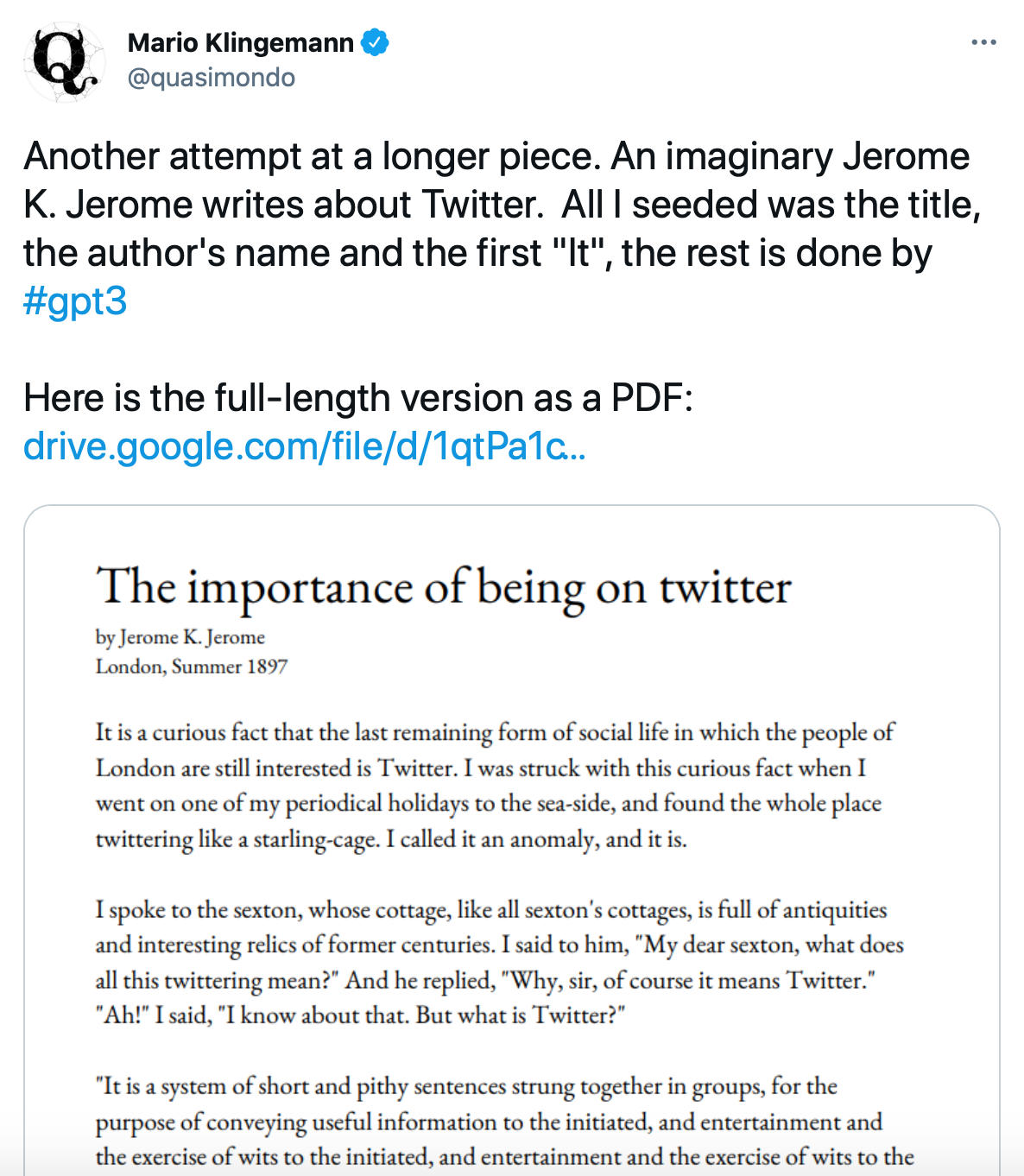
GPT-3 can be used for more than just fun experiments like this. The technology has been shown to complete many writing tasks, including press releases, screenplays, essays, technical manuals, and even raps! If you’re looking for a good laugh, you can check out this blog post where GPT-3 was used to write a rap song about Harry Potter by Lil Wayne.
When it comes to content marketing, GPT-3 has also proven to be rather effective. The technology can be used for the following applications (content marketers & copywriters – get ready to see your career flash before your eyes!):
- Evergreen, long-form content
- Copy for category pages
- “Basic copy” (ie. footer copy, meta descriptions, alt text)
- Ad Copy
- Product descriptions
- Pulling structured data
Before we get you too frightened about GPT-3 stealing your content marketing job (or even too excited about replacing your content marketer with a robot), there are plenty of shortcomings to this technology. While it’s impressive how much GPT-3 CAN do, there’s also a lot that it CAN’T do. We’ll discuss this further in the ‘Limitations of GPT-3’ section below.
How Does GPT 3 Learn?
When it comes to writing content, GPT-3 doesn’t just come up with ideas out of the blue. The technology relies on high-quality, human-written articles that are already available on the internet.
GPT-3 uses previous content to learn important elements like sentence structure and vocabulary. While processing the content, GPT-3 attempts to predict each word based on the previous words and context.
Based on this information, you can see why GPT-3 has certain limitations…
What Are the Limitations of GPT-3?
Content marketers can now all breathe a sigh of relief. At this point, GPT-3 is not a turn-key solution. While the technology may produce an article that would have taken content marketers a few hours in a few seconds, the quality of GPT-3 content is just not up to par.
While there are quite a few limitations of GPT-3, the lack of content diversity, the potential for content biases, and the lack of reliability are some of the most troublesome.
Your Brand = Just Another Fish in the Sea
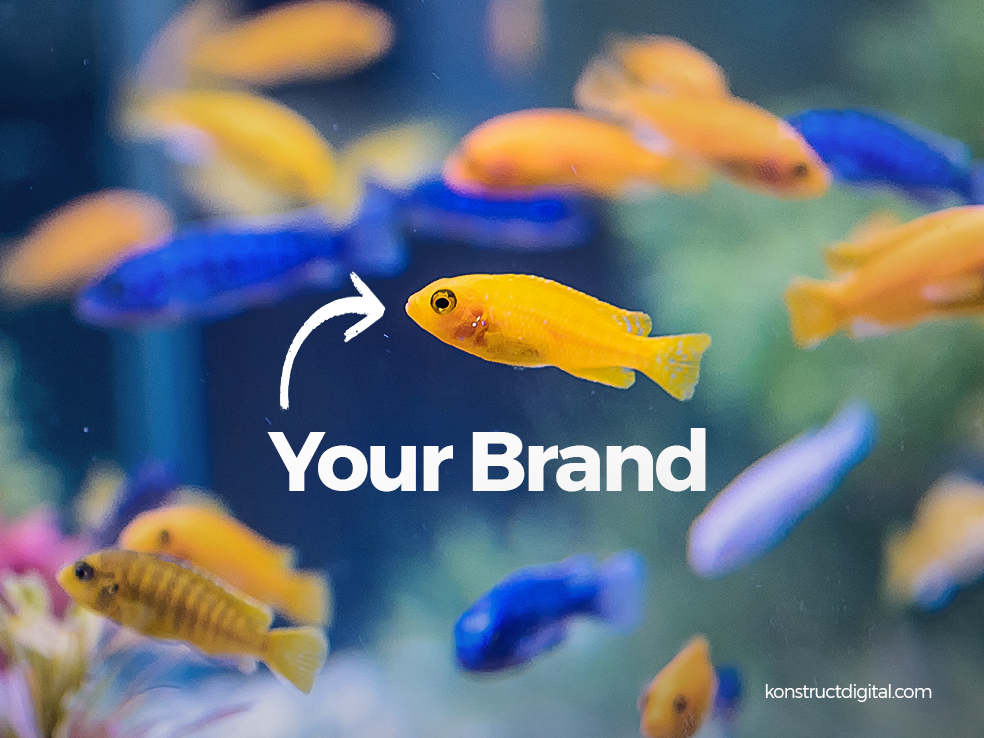
GPT-3 struggles when it comes to producing content that fits your brand. If GPT-3 bases its content off of existing sources, then the content it produces for you cannot and will not be unique.
For example, GPT-3 cannot produce customer data out of thin air. If it could, that wouldn’t be very genuine anyways! Think about the case studies on your website. It just wouldn’t be possible for the technology to produce customer testimonials without being disingenuous.
With a rise in GPT-3 content, we also anticipate an issue with content sameness. All the articles written on a particular topic will cover the same information without adding any new or unique value.
If you were to rely solely on GPT-3 for your content creation, you can kiss original content and unique ideas goodbye and watch your brand slowly fade into the crowd… This probably goes without saying, but that is a terrible marketing strategy!
Racism, Sexism, and All those Terrible ‘isms’ You Want to Avoid

If the existing content on a particular topic is biased, and GPT-3 uses that content as a reference, your content will also be biased. Even if you don’t think biases exist in your industry, you might be surprised.
Although reducing bias in machine learning is an active area of research, we’re not yet at the point where these tools are filtering out biased information.
The last thing you want is to get your brand twisted in a PR scandal because you let a bot run wild. That’s why it’s widely encouraged to carefully edit your content output before making it available to the public.
Trust Issues

One of the greatest pitfalls of GPT-3 is the potential for it to make basic errors that average humans would never commit. There’s also no guarantee that the content it produces will even be correct!
Basically, GPT-3 lacks common sense. If it’s never learned a particular concept, it will jump to conclusions that may very well make no sense at all. A rather humorous example of this is the following exchange between a human and GPT-3:
“Human: How many eyes does a giraffe have?
GPT-3: A giraffe has two eyes.
Human: How many eyes does my foot have?
GPT-3: Your foot has two eyes.
Human: How many eyes does a spider have?
GPT-3: A spider has eight eyes.
Human: How many eyes does the sun have?
GPT-3: The sun has one eye.”
The result is downright bizarre!
Consider the implications of using GPT-3 for your business and having it infer information like this. It would be pretty embarrassing for your brand if you put out content so absurdly incorrect!
How Do You Make GPT-3 Work For You?

Now that we’ve spent all this time telling you the ways in which GPT-3 kinda sucks, it’s time to share the key to making GPT-3 work for you. Drumroll, please! The secret sauce to GPT-3 success is… humans!
When it comes to GPT-3, the magic really starts to happen when you combine the powers of AI with your content marketing team. Fusing together the content creation speed of GPT-3 with the common sense and industry knowledge of humans can give you the best of both worlds.
“GPT-3 will increase competition across the board and put pressure on content marketers to find ways to stand out. As generic content becomes a commodity, creators will need to rely on other aspects that are harder to automate. For example, by utilizing proprietary research, building a superior user experience, or telling a more entertaining story. Luckily, there will be more time to do it thanks to the automation!”
Ryo Chiba, Co-Founder at Topic
The key takeaway is that GPT-3 cannot operate in a vacuum. It takes a human touch to augment the GPT-3 system and to help it produce new content that has real value for your business.
What is the SEO Opportunity of GPT-3?
When it comes to SEO, the most significant benefit of GPT-3 is its ability to incorporate keywords into your content naturally. By understanding the context in which other sources use particular keywords, GPT-3 can seamlessly use these same keywords and optimize the language in your content. This will help you improve the odds of search engines ranking your content highly.
GPT-3 really shines when used to do some of the “heavy lifting” of baseline content research and outline creation. Because GPT-3 generates content word-by-word, it can struggle with maintaining a coherent message when content is longer than a few paragraphs. Instead of relying on GPT-3 to write all of your content for you, take advantage of its ability to aggregate and compare top-performing content. This will give you a better idea of the topics you need to cover to rank for a particular keyword while still having the freedom to write content that is unique and valuable to your audience.
Finally, the more content you produce, the greater your organic search traffic is likely to be. As SEOs know, every piece of content is an opportunity to rank for new keywords. This allows new audiences to find your site, learn about your brand, and become potential customers. GPT-3 may make it easier for you to produce more content each month and improve your overall search visibility.
What SEO Tools Already Use GPT-3?
Although OpenAi only released their GPT-3 private beta to select developers, many developers have already used the technology to create exciting GPT-3-based SEO tools for digital marketers.
Here are some of the neatest tools we’ve seen floating around the web.
Blog Idea Generator
Say goodbye to writer’s block! Powered by Topic and GPT-3, this tool analyzes top-performing content on Google for your given target keyword. It then spits out a series of unique ideas for your topic and helps you cut down on brainstorming time.
We gave this tool a couple of tries to see how it works. We especially love the “Give me a new idea” button which allows you to generate new concepts until you find the perfect one.
Copysmith
If you’re looking for more than just a blog post idea and want a tool that will do the heavy lifting, Copysmith is a cool option. This tool can use GPT-3 to create SEO-oriented blog posts. It can also write copy for landing pages, metadata, ads, and more! Interestingly, this tool can learn from the ways you edit the content it produces. This means the more you create and edit content, the smarter the tool becomes!
Headlime
Another content generation tool option is Headlime. This tool was originally used to generate effective headlines for articles. Headlime has since expanded and can now be used for a wide variety of content generation tasks. An interesting aspect of this tool is that it leaves lots of room for a personal touch. For example, if you’re writing a blog post and get stuck on a certain section, you can click the “write for me” button. This allows the tool to write content from where you left off until you’re ready to continue writing again.
Writesonic
With over 20+ content types available, including Google ads copy, website copy, blog copy, and more, Writesonic looks to be a very well-rounded AI copywriting tool! The tool is available in 11 languages and is said to write content that converts. After choosing your content types and entering a short description of your product or service, the tool spits out a dozen different copy variants for you to choose from.
Are Content Marketers Going Extinct?
And now for the answer you’ve all been waiting for… Will robots replace content marketers? Nope!
Although we will likely see GPT-3 do a lot of the heavy lifting when it comes to content development, AI will always be missing that human touch that really helps content excel both with search engines and users!
“The introduction of advanced natural language generation (NLG) tools like GPT-3 will absolutely shake up the SEO content landscape in two distinct ways. First, factual content (e.g. what is, how to, market reports) that are basic brushstrokes across a topic will be mostly automated away with robot-generated content. Second, thoughtful content which contains true subject matter expertise and points of view will become invaluable to a winning SEO content strategy.”
Bernard Huang, Co-Founder at Clearscope
As GPT-3 begins to dominate the web, we predict that content uniqueness will become a key ranking factor. Google will want to reward content that offers a unique angle or valuable information, especially if all the content starts to look the same. This is where content marketers will come to save the day. With their creative minds and true industry expertise, content marketers will take AI-written content to the next level and help it stand out from the pack.
Page experience is an integral part of the successful performance of your website. If visitors enjoy using your website, they are more likely to convert. Woohoo! But users aren’t the only ones who care about your page experience…
Spoiler alert: Google cares too! And that’s where the new Core Web Vitals ranking factors come into play. In this article, we’re sharing everything you need to know about Google’s Core Web Vitals and how to optimize your site to get an organic rankings boost.
Core Web Vitals

Core Web Vitals, recently introduced by Google, are a set of metrics that Google considers important to the page experience of a website. They measure the page speed, responsiveness, and visual stability of your site. Core Web Vitals are made up of three specific measurements that Google has deemed essential in delivering a good page experience to site visitors:
- Largest Contentful Paint (LCP)
- First Input Delay (FDI)
- Cumulative Layout Shift (CLS)
So, why should you care?
In June 2021, Google will begin to gradually roll out the “page experience update” which will make Core Web Vitals a crucial aspect of your page experience score. Google explained, “The new page experience signals combine Core Web Vitals with existing search signals including mobile-friendliness, safe-browsing, HTTPS-security, and intrusive interstitial guidelines.” This means in order to get your pages to rank higher on Google, it’s a good idea to assess the Core Web Vitals on your site and make the necessary changes before the Google “page experience update” takes action.
In this article, we are going to discuss each of the Core Web Vitals in detail and share a few tips to help you improve them ahead of the page experience Google algorithm update.
Largest Contentful Paint
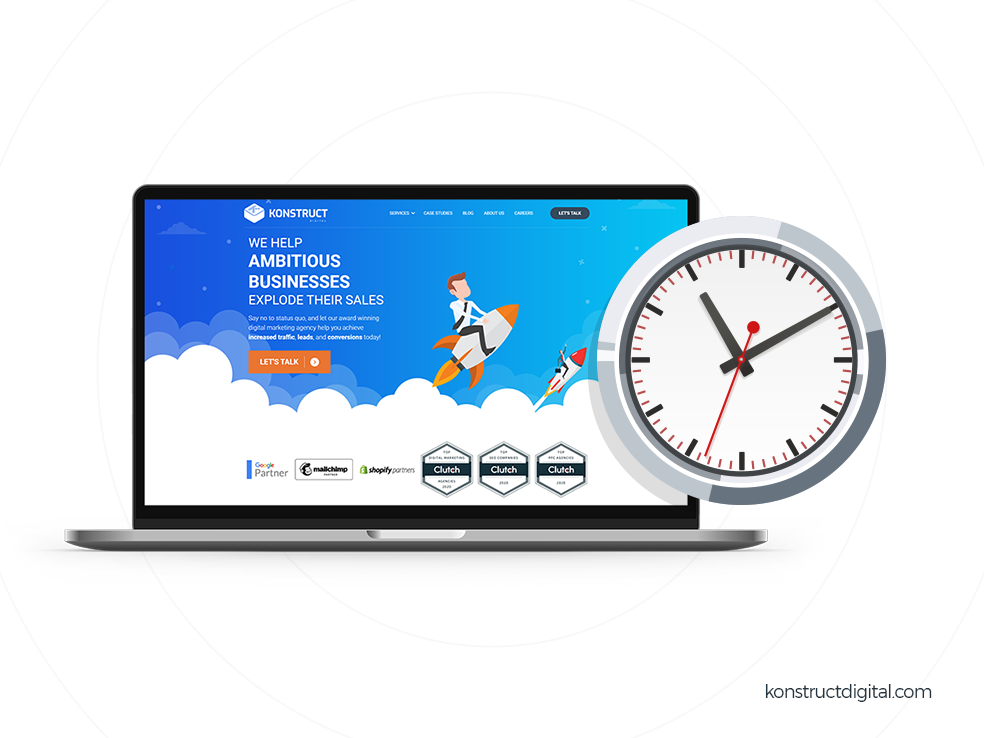
Largest Contentful Paint or LCP refers to your page loading performance. It is a measurement of how long it takes for the largest content element to render within the user viewport. This includes elements such as images, background images, text elements, and video elements.
Google is paying attention to page speed insights because they realize slow page load speeds are causing a lot of people to bounce. A fast-loading website creates a much more positive user experience. If a user’s experience is more positive, they are going to stay on your site longer. If your website is taking too long to load, the user is going to leave and find a site that answers their query more quickly without.
Meeting Google’s requirements for LCP is pretty straightforward. A slow LCP means lower ranking and penalties, and a fast LCP means higher rankings, which means more traffic to your website.
So, what is a good LCP metric? An ideal LCP measurement is less than or equal to 2.5 seconds. If your LCP is slower than 2.5 seconds, you can expect to be penalized by Google with a lower site ranking.
Tips for increasing page loading performance
To improve the Largest Contentful Paint, you should focus on two things. The first is to reduce the download time of resources, and the second is to avoid blocking or slowing elements as much as possible.
Reducing the download time of resources is the most obvious way to improve your site’s LCP. If resources such as fonts, HTML files, images, CSS, and javascript are loaded quickly by a browser, then the browser can also start rendering the page earlier. Some ways to do this are to make use of HTTP caching, use compression to reduce the transfer time, and optimize your server settings.
There are a number of ways to avoid blocking delays by CSS files and JavaScript files. A simple way to do this is to not rely on external hosted JavaScript or CSS files. Also, using a lightweight theme or template with minimal pop-ups and plugins can help. Blocking delays is primarily a coding issue, and it may take time and expertise to rectify.
First Input Delay
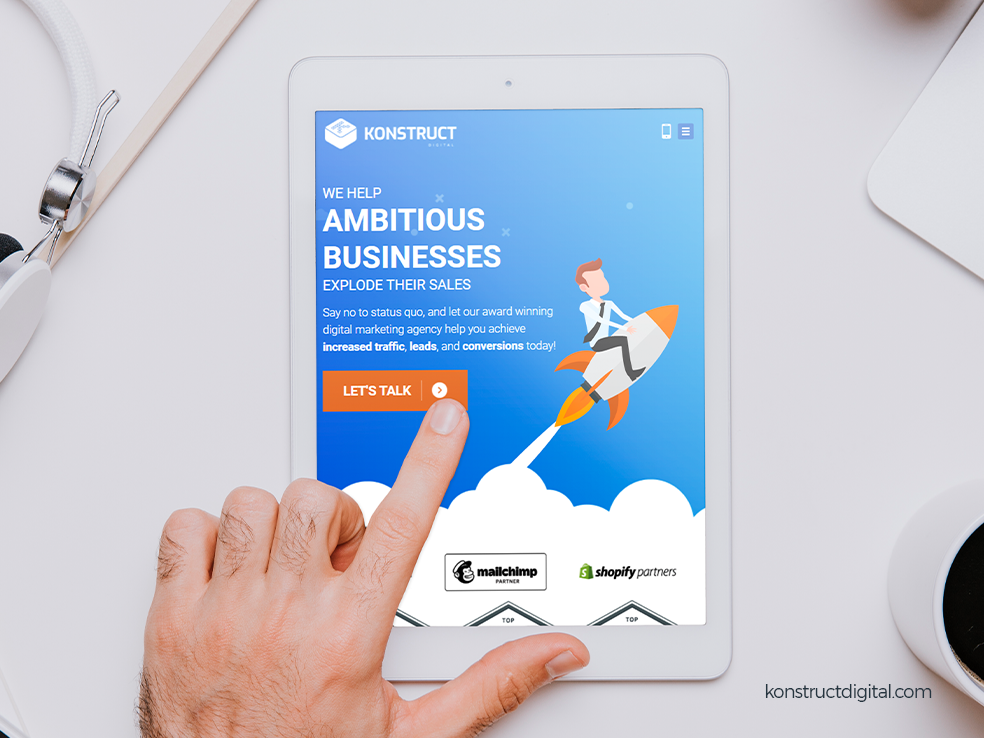
This First Input Delay or FID is the responsiveness of your webpage. It measures the time it takes for a page to become interactive.
It is also the measurement of user frustration. In essence, this metric measures how quickly a user can interact with your website. If the user can achieve what they want on your website quickly, they are happy. If they can not efficiently achieve what they came to do, then they become frustrated. Key smashing and swearing may ensue.
FID is a huge page experience metric. The sooner a user can interact with your site, the sooner they engage with your website. It builds trust and confidence in your site, and in your product. A fast FID can mean the difference between capturing a lead or a sale or losing a prospect altogether.
When it comes to FID, a good benchmark to keep in mind is that your page should be responsive in less than or equal to 100 ms. Any longer than this and you risk losing the trust of both your real users and Google.
Tips for improving your First Input Delay
Improving your FID is not a simple task. The easiest way to improve your FID is to have a solid foundation with strong UX as your standard. Like LCP, to rank well for FID you will need your site to be optimized properly.
If you are not starting from a solid foundation, you may want to consider seeking help from a programmer to optimize your site’s FID.
Cumulative Layout Shift

Cumulative Layout Shift refers to the frequency of unexpected layout changes and a web page’s overall visual stability. Like FID, this can be the source of great frustration for your visitors.
Here’s an example:
Have you ever visited a website and were about to click on a link to an article, but the layout suddenly shifts and an ad appears? Instead of clicking on the article you wanted to read, you click on the annoying ad. So frustrating!
Ideally, you do not want anything getting in the way of the visitor engaging in your website in the way they want. You want it to be easy for them to navigate your site and accomplish what they came there to do.
To feel confident about your site’s performance, you will want a CLS score of less than or equal to 0.1. A fully static page with no layout shift can have a score as low as zero and the score increases as more layout shifts occur.
Tips for improving your First Input Delay
Before we attempt to optimize our CLS, let’s first understand what causes it:
- Using fonts improperly leading to a flash of invisible text (FOIT) or a flash of unstyled text (FOUT)
- Embeds and banner ads and iframes without dimensions
- Using images without specifying their dimensions
- Actions waiting for a response from the network before updating DOM
- Any content that is injected dynamically
The simplest way to increase your CLS score is to add dimensions to your images and videos, as well as reserving space for your ads, embeds, and iFrames.
Measuring Core Web Vitals
The Core Web Vitals report has replaced the old speed report in Google Search Console. If you’re not already monitoring your core web vitals you will want to start paying close attention before Google’s update.
Tracking your Core Vitals can be done through Google Search Console. The report breaks all of the pages on your website down into buckets that are labelled poor, in need of improvement, and good. This makes it easy for you to identify which pages need work, and which pages are working well.
Lighthouse is another tool that makes it easy to monitor your core web vitals. This web vitals Chrome extension allows you to run reports that give you a score for each of the core web vitals, along with the Lighthouse Performance Score.
The Importance of Core Web Vitals
So, we’ve spent this entire blog post telling you that core web vitals are important because they will soon act as ranking signals and impact your search rankings. But, how much of an impact will they really have? Is it worth getting in a panic and ringing all the alarms?
The truth is… core web vitals may not be as influential to your search rankings as some had originally thought. Although page experience signals are important, Google shared that relevance and valuable information will still trump page experience ranking as the most important ranking factors.
Google explains, “While all of the components of page experience are important, we will prioritize pages with the best information overall, even if some aspects of page experience are subpar.”
Core Web Vitals Ranking Boost
Although core web vitals may not have the most massive impact on your search rankings, they could still be the difference between earning that lucrative #1 spot or being stuck in #2. By paying attention to user experience, and optimizing your core web vitals, your site may just be given that extra boost you need to bump onto the first page or even into the top spot!
If your core web vitals scores aren’t great and you are struggling to increase them, our team of developers can help implement technical changes on your site. This will have an immediate impact on user experience and give your pages a boost when “page experience update” rolls around.
Get started by contacting us today!
Congratulations! By clicking on this article, you just took the first step towards achieving killer search rankings for your Shopify store. Optimizing your Shopify store for search engines is one of the most effective ways to increase high-quality traffic and boost your sales.
Most of us can recall a time when we typed a product into Google and completed a purchase. 44% of online shoppers start their online shopping journey with a Google search (nChannel). But, how many times did you scroll through the 2nd, 3rd, or 4th page of search results to find what you were looking for? I’m willing to bet your answer is “almost never”!
If your Shopify store makes it on page 1 of Google for your target keyword, you’re in great shape! While there are many other factors that determine whether a person completes a purchase, getting the right people to visit your Shopify store is a crucial first step.
In a nutshell, this demonstrates why Shopify SEO (search engine optimization) is so crucial. The higher your search engine ranking on a search engine results page (SERP), the more traffic you’ll get. The higher the page number you rank on, the less traffic you’ll get. And, the more traffic you get, the more sales you’re likely to generate. Getting a high SERP ranking is the name of the game and ecommerce SEO mistakes can be costly for your business!
So, what can you actually do to boost your rankings without paying a fortune in Google ads?
In this extensive guide, we’re covering everything you’ll need to know to increase the organic search rankings of your Shopify store. Let’s dive in!
Regular SEO VS. Shopify SEO
Whether you’re doing regular SEO or Shopify SEO, the fundamentals will always stay the same. However, there are best practices, built-in Shopify features, and important aspects that make Shopify SEO unique.
Any general ecommerce SEO tips and best practices you’ve already learned will still come in handy when optimizing your Shopify store. For this article, we’re breaking down the aspects that are exclusive to Shopify SEO so you can level up your SEO knowledge and give your Shopify rankings the extra boost they may need to earn that lucrative page 1 spot.
The 5 Essential Aspects of Shopify SEO
This guide covers the following aspects of optimizing your Shopify store:
1. Start with Keyword Research
Before you do anything else, you need to get your keywords in order. Keyword research is the foundation of any eCommerce SEO campaign and affects your technical SEO, user experience, and website architecture.
Your products may have the opportunity to rank for multiple keywords, but it’s important to choose the right keyword that is the best fit for your products and business and will resonate with your target audience.
What search term is your target audience actually plugging into Google when looking for your products?
How Ecommerce Keywords are Different
Before we dive into the process of keyword research, we need to understand the basics of eCommerce keywords. Spoiler alert: regular SEO keywords (informational keywords) and eCommerce keywords (commercial keywords) are not the same!
Most blogs and sites with a lot of content want to target informational keywords. For example, a social media company might target the keyword “how to increase Instagram followers”. This would help them target customers seeking information relevant to their business and services.
As a Shopify store, you want to rank for commercial keywords that show buying intent. For example, “t-shirts for women” would be a commercial keyword. If someone entered this search term into Google, it’s likely that they intend to make a purchase.
Note: This does not mean that “informational keywords” can never be used as e-commerce keywords. For example, let’s say you sell car accessories. You may choose the informational keyword “How to fix car rearview camera” to target people with indirect buying intent. However, a more direct approach would be to target a commercial keyword such as “Buy car rearview camera”.
E-Commerce Keyword Research Tools
Now that you understand the types of keywords you should be using, it’s time to discuss how to actually find these keywords. Remember: you don’t just want any random keyword that relates to your brand. You want keywords that people are actually using to find products related to those you are selling.
Luckily, there are many tools available to help you through this process!
If you’re looking to really invest in your keyword research, you can opt for a paid tool such as AHREF, SEMrush or Keyword Tool Dominator. However, there are also some great keyword research tools that are free to use! For example, you can use search results on Amazon or the Google Keyword Planner tool for free. We’ll show you how to use both tools in the following sections.
Keyword Research with Amazon Search Results
Amazon is one of the biggest eCommerce websites and, therefore a great place to go for some free initial research for your Shopify store! Amazon merchants are also your competitors, so it’s helpful to understand their strategies.
Here’s your step-by-step process for using Amazon search results as a preliminary keyword research tool:
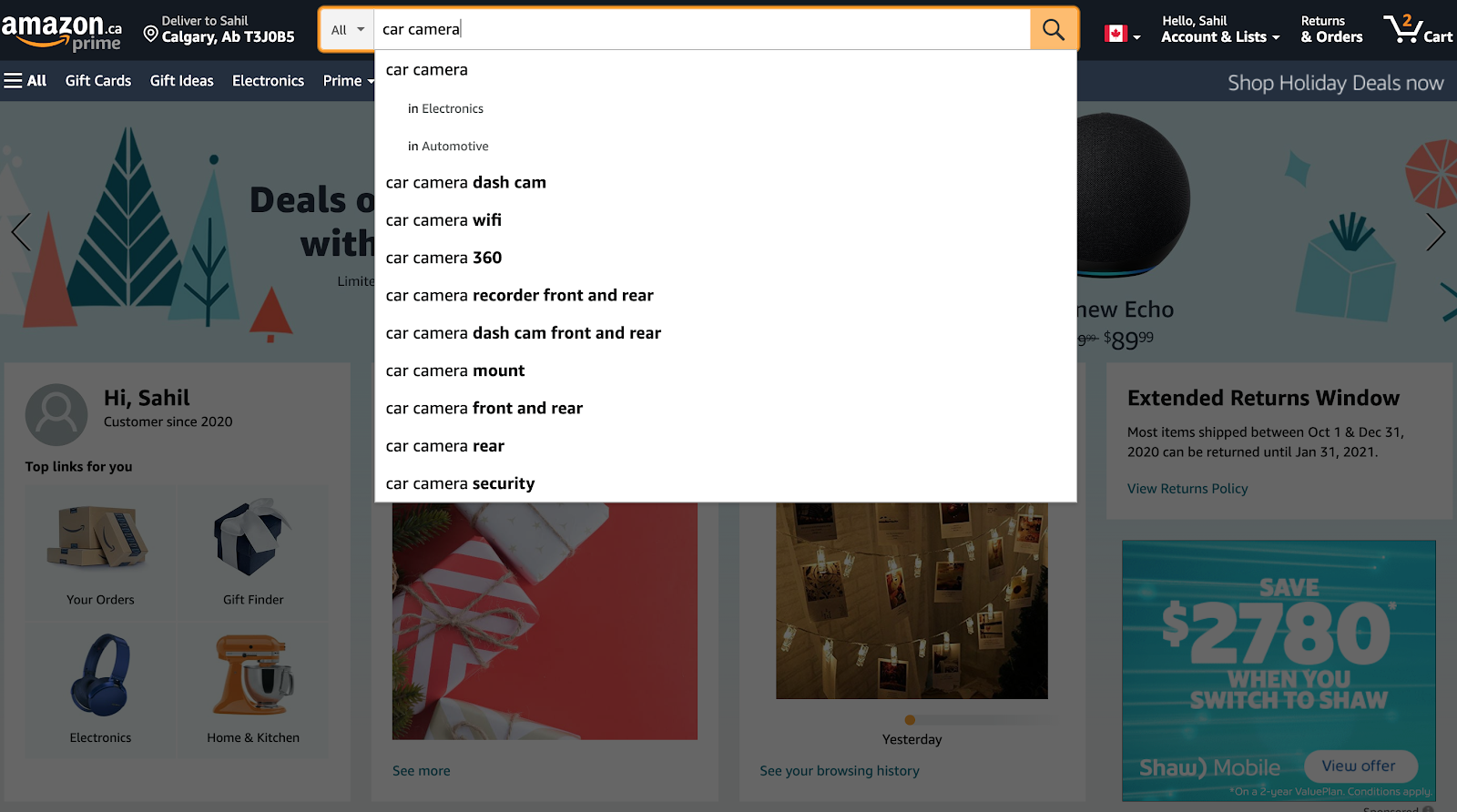
- Enter a product that you sell in your Shopify store or a keyword that is relevant to one of your products (ex. “Car camera”) in the Amazon search bar.
- Take a look at the search suggestions and make note of the different keywords (ex. “Car camera dashcam”, “car camera 360”, “car camera front and rear”, “car camera wifi”). This will give you keyword ideas for your Shopify store.
- Take a look at the product category names (ex. “Electronics” & “Automotive”) and make note of category ideas for your store.
- Now you’re ready to use this information to dive deeper into your keyword research!
Keyword Research with Google Keyword Planner & SEMrush
Now that you’ve got some ideas on where to start, it’s time to dig deeper by using the Google Keyword Planner & SEMrush tools. Although SEMrush offers several paid options, there is also a free plan available to help you with some basic keyword research.
Before you start entering keywords into Google Keyword Planner, create a spreadsheet to gather and compare information during your keyword research process. This should include columns for keywords, search volume, competition, and keyword difficulty. Check out the image below for an example of what your spreadsheet might look like. This is just a small example for one product. Feel free to expand this document per your store inventory and services.

Here’s a quick rundown of the terminology to help you through this process:
Topic: This is the category the keyword fits into best in relation to your website. If your website offers various services or products, each service offering or product category would qualify as its own topic. Assigning keywords to a topic helps identify its relevance to your website and helps in the keyword mapping process. As our keyword research in this example only focuses on one product, all the topics should be the same. Otherwise, the keyword would likely be irrelevant!
Intent: This is the level of the funnel the search takes place. Top-of-funnel is problem awareness searches, middle-of-funnel is solution awareness searches, and bottom-of-funnel searches are directly related to your brand or product.
Search Volume: Monthly Average Search Volume defines the average number of monthly searches for the keyword. This information may vary based on date range, location, and language.
Competition: This defines how difficult it would be to rank for a particular keyword. The level of competition (low, medium, or high) is determined by the number of competitors vying for a keyword relative to all keywords across Google.
Keyword Difficulty %: The keyword difficulty index (from 1 to 100%) shows you how difficult it would be to outrank your competitors in the Google organic top 20 for a given keyword. The higher the percentage, the harder it will be to achieve high rankings for each targeted keyword.
For your Shopify store, you’re ideally looking for keywords with bottom-of-funnel intent (commercial keywords), relatively high search volume, relatively low competition, and relatively low keyword difficulty.
So, you’ve got your research document ready. What’s next?
Now’s a good time to plug in those keywords that you discovered from your Amazon search suggestions research! Once you enter a keyword into the Google Keyword Planner tool, make note of the search volume and competition on your spreadsheet. This tool will also give you ideas on relevant keywords that could be effective for your Shopify store. Be sure to add these new keywords to your spreadsheet as well!
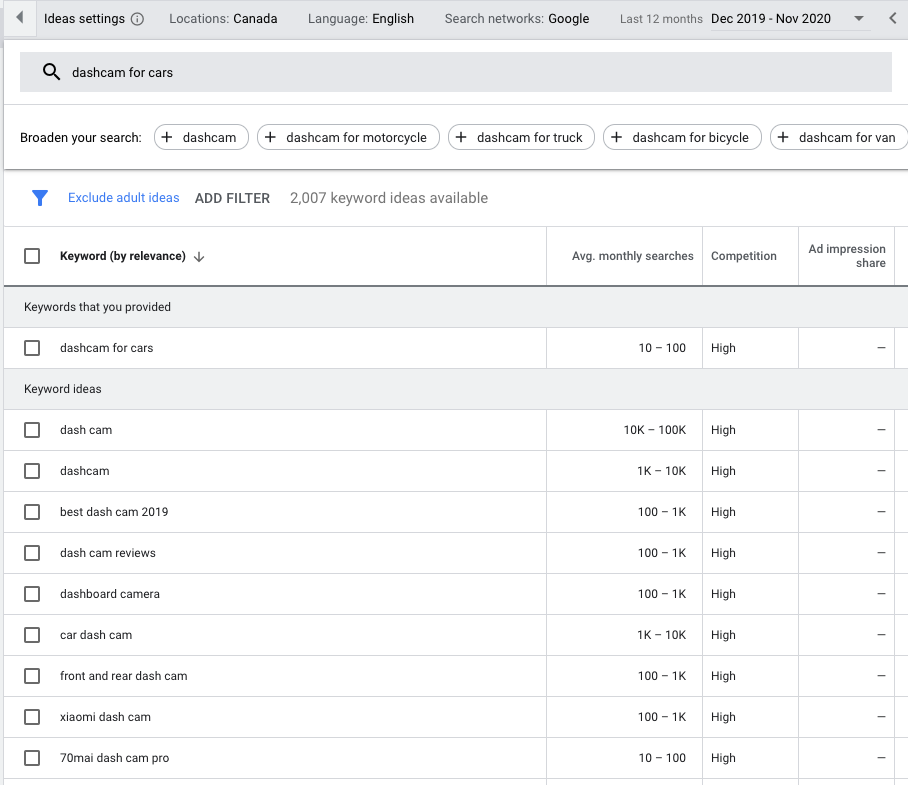
To determine keyword difficulty, we’re going to head over to SEMrush. You’re going to pull up the Keyword Magic Tool, enter your keyword in the search bar, and make note of the number in the KD% column.
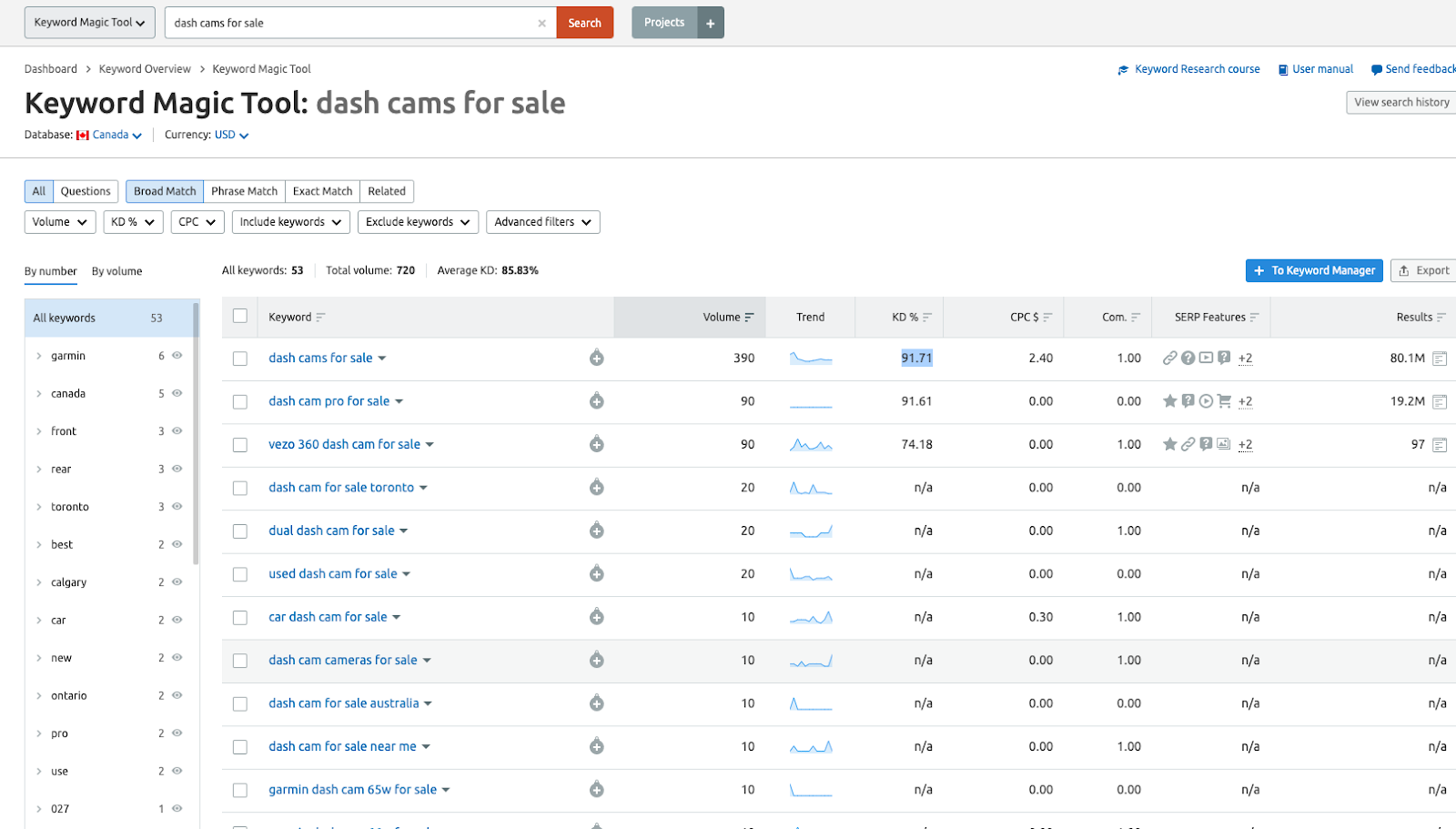
Now you’ve got a thorough list of keywords to compare based on various factors so you can choose the best keywords for your Shopify store!
2. Optimize your Shopify Website Architecture
Compared to a standard website, eCommerce websites tend to be much more complex with a lot more pages, which can make the user experience rather complicated. This is where solid website architecture comes in to save the day.
Site architecture refers to the way in which the pages on your site are organized and arranged. This is important for EVERY website, but especially eCommerce sites to ensure that users and search engines can easily find the many different pages on your site.
Having a solid site architecture is important both for user experience and SEO. Users are more likely to make a purchase from a site that is easy to navigate, and search engines are more likely to rank pages higher when they can easily understand the structure of a site.
Long story short: you want your e-commerce website to be simple and scalable. Why?
Simple – to help users and search engines navigate.
Scalable – to help you easily add more inventory and grow your business.
Here’s an example of what an ideal e-commerce site architecture would look like:
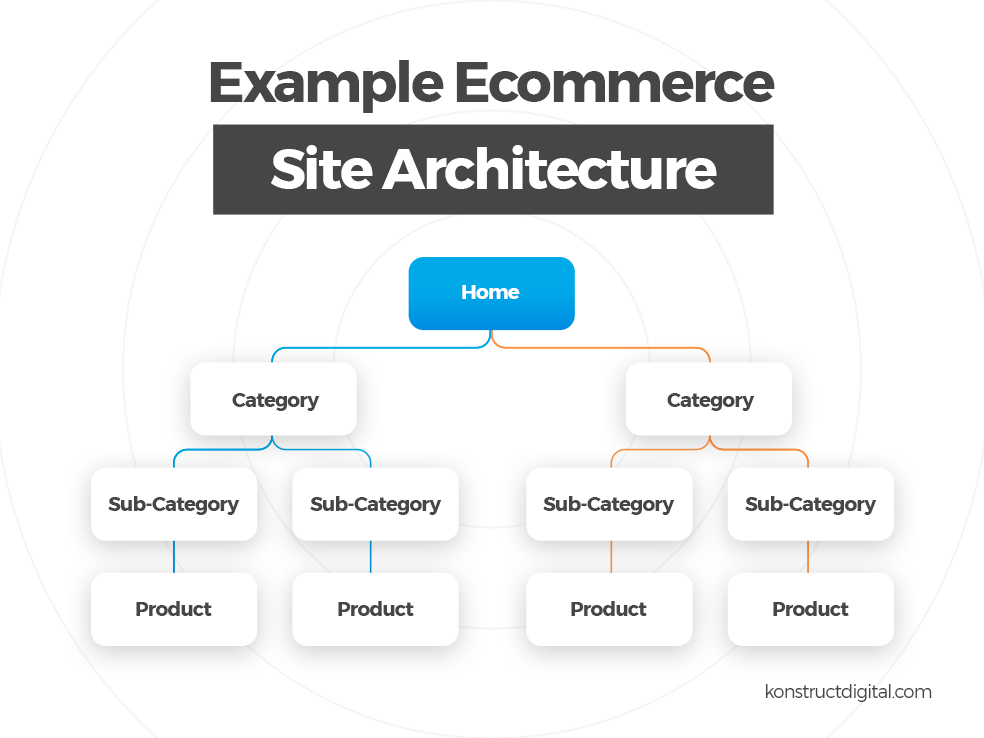
Using Shopify to Optimize Your Site Architecture
Let’s dig into the Shopify settings to see how you can use Shopify to properly organize and arrange your site.
When you log in to your store, you will see a left sidebar menu with a “Products” section. Let’s say you sell car accessories and want to add a new 360-car camera to your Shopify store. If you’ve never sold car electronics before, you would need to start by creating a new category. In Shopify, category pages are referred to as “collections”. Collections could also be used to group together products that are part of a special discount or promotion such as “buy one, get one” promotions. You can add a new collection page by clicking Products > Collections > Create Collection.

To create a sub-category page, you’ll have to create a “collection” page and nest it within a hierarchy in the menu. Shopify does not differentiate between category and subcategory pages.
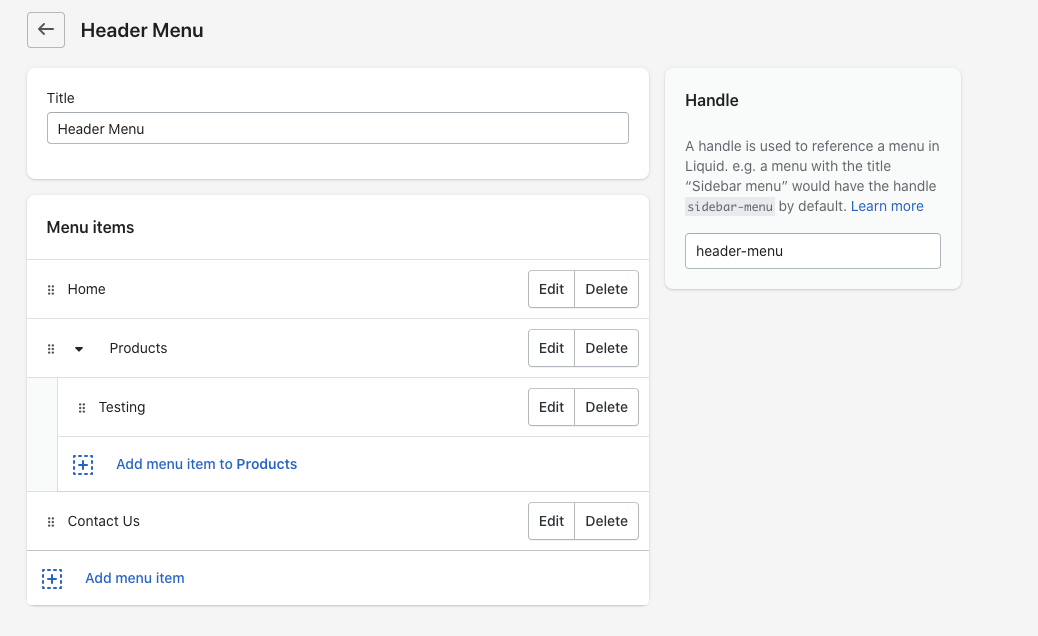
Once you have your collection, you can go ahead and create the product page for your 360-car camera. You can add this page by clicking Products > All Products > Add Product.

When creating a product page for your 360 car camera, be sure to add it to your new “electronics” collection.
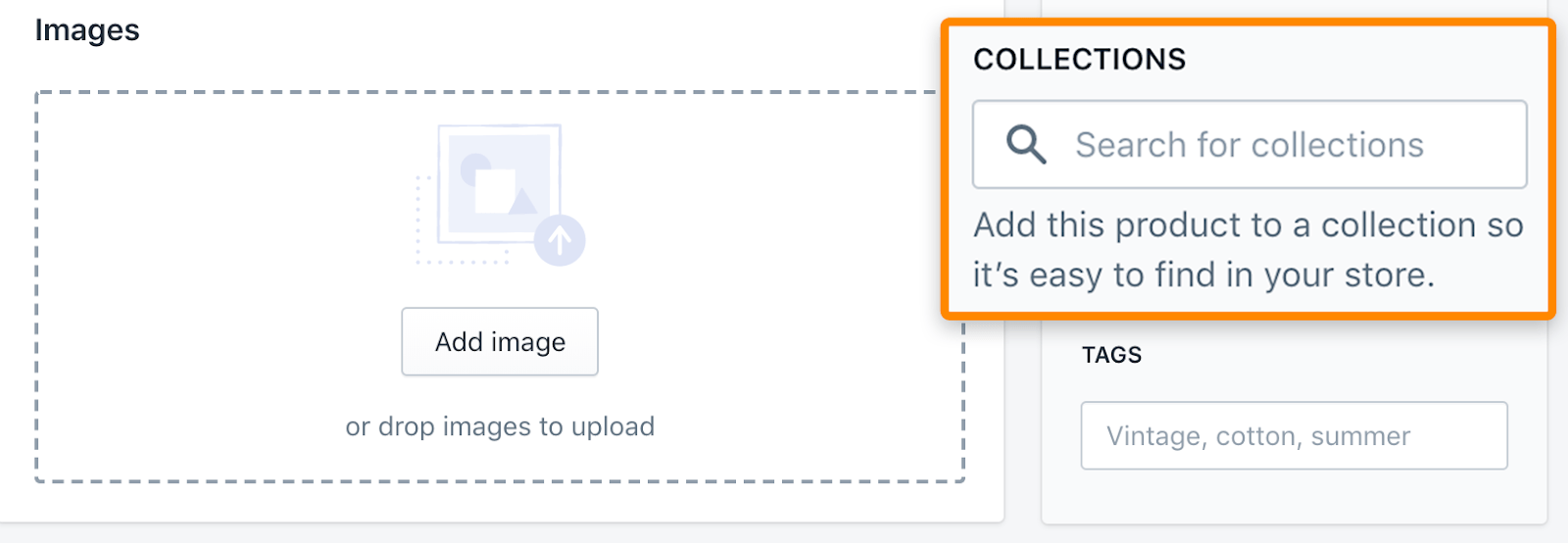
Note: If you have lots of products, you may wish to use the automated collection option rather than the manual collection option. Choosing the automated collection option will help you save time and will streamline the process of adding new products to your Shopify store!
When setting up your automated collections, you will need to create product conditions (basically product tags) to help Shopify identify which products belong in the collection. These include conditions such as type, price, vendor, and stock. For example, this would help you create collections based on different price levels (ex. Products under $30) or brands.
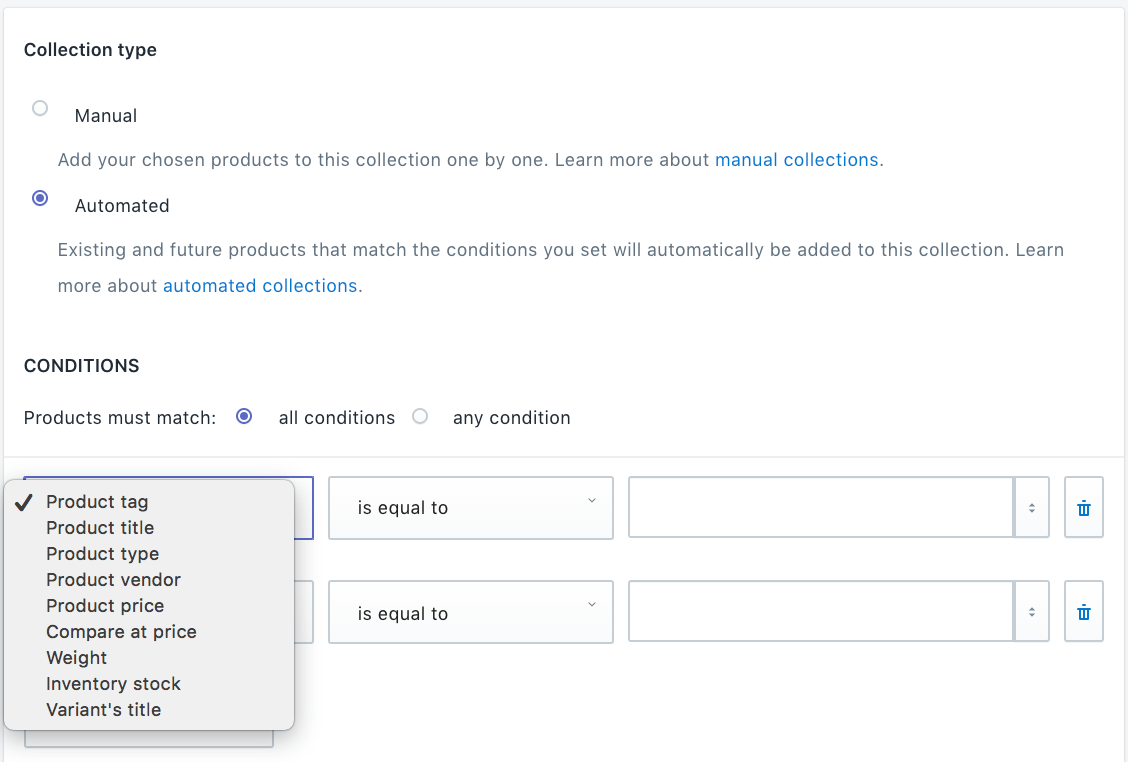
To add these collections to your main menu, click Online store > Navigation> Add menu item.
Don’t forget that there are additional pages other than product and category pages that are important to add to your site to build trust and credibility with your customers. These pages may include an “About Us” page, a “Contact Us”, privacy policies, etc.
Additionally, I would highly recommend adding a search box on your website. This will allow you to use visitor search terms to map with your keyword research document for later use!
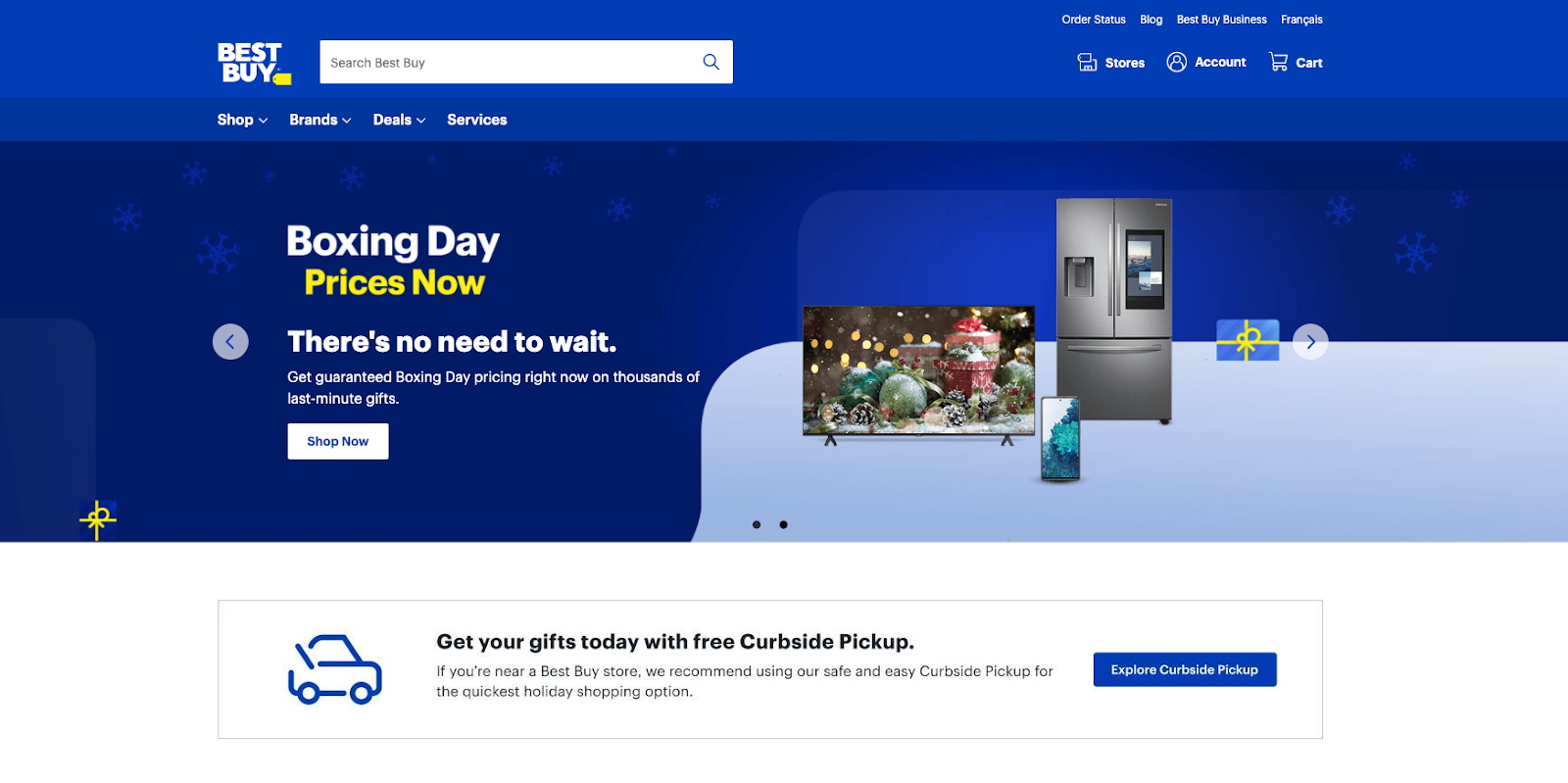
3. Complete On-Page SEO for Your Shopify Website
Now that you have your Shopify store website architecture ready and basic keyword research complete, we can take the next steps to optimize these pages.
Let’s focus on your product and category pages. These are the highest-value pages on your site and have the greatest impact on your sales.
Through Shopify, editing on-page SEO such as page titles, meta descriptions, and URLs is pretty easy. Simply select a product or collection page, scroll down to “search engine listing preview”, and click “edit website SEO”
Page Titles
When it comes to page titles, the main goal is to achieve the best click-through rate (CTR) possible. Higher CTR = more traffic = more sales!
Here are the elements of an effective eCommerce page title:
- Title includes target keyword. Hopefully, this should go without saying! It’s also a best practice to add the keyword to the beginning of your page title (if possible).
- Length is between 51-60 characters. Longer titles are likely to cut off and shorter titles lack description.
- Title includes “click magnet” words such as “Free Shipping”, “Lowest Price” or “X% off”. These will make your title more appealing to searchers and will boost your CTR. For example, “25% off on AUKEY Full HD 1080P Dash Camera – Free Shipping”

- Title includes modifiers such as “Best”, “Buy”, and “Deals”. These are words that your target audience might add when searching for your products. For example, instead of simply “Dash Cam for Cars” you could change your page title to “AUKEY Best Dash Cam Full HD 1080P Dash Camera for Cars”.

Note: You can use Google Keyword Planner to determine the best modifier to use by searching and comparing various long-tail keywords.

Meta or Page Description
Now, let’s move to the next step and write the meta descriptions for your product and category pages.
A good description should not only entice potential customers to click on your listing and complete a purchase, but also help search engines understand your product, which can help boost your SERP ranking.
Here are a few important elements of an effective meta-description:
- Description includes target keyword. Exact match keyword usage is less important in your meta description than in your page title. Include your keyword when it is appropriate but focus more on the quality of your description.
- Length is under 320 characters. Shopify allows you to use up to 320 characters in your description. However, meta descriptions on the SERP typically cut off after 160 characters and mobile SERPs cut off after 120 characters. If you’re going to use a longer description, ensure that the most important information is included in the first 120 characters.
- Description is unique and engaging. Use this opportunity to capture your audience’s attention and entice them to click through and buy your products. If you’re selling third-party products, avoid copying and pasting the descriptions from the manufacturer. Instead, create your own unique description that aligns with your brand.
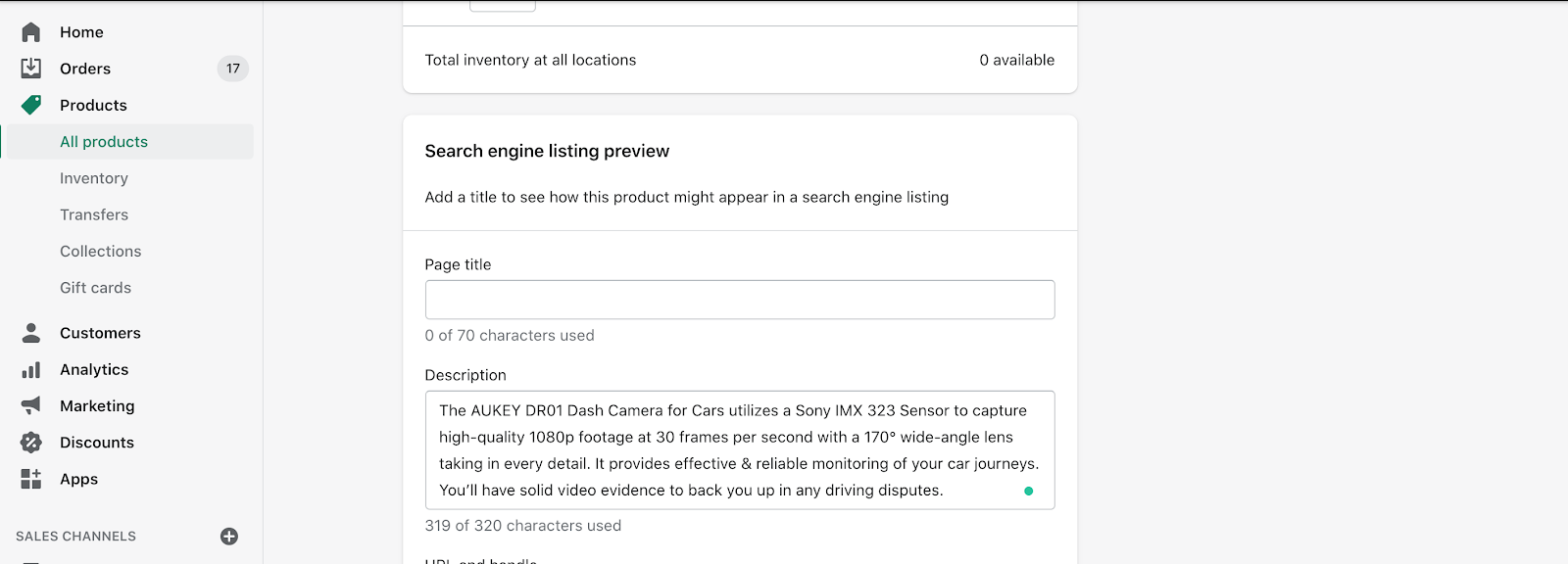
Page URL
For eCommerce websites, it’s possible that your URLs will be much longer compared to other websites. However, it’s still important to keep them as short and sweet as possible and focus on keyword richness.
Here’s how to write an seo-friendly and keyword-rich URL for the various page types:
For category pages, include a 1-2 word description of that category:
Example: https://yourdomain.com/dashcam
Follow the same process for subcategories. Only this time, the subcategory will come after the category in the URL:
Example: https://yourdomain.com/dashcam/cars
Then, for product pages, include just your target keyword for that product, separated by dashes (“-”).
Example: https://yourdomain.com/dashcam/cars/viofo-wr1/
Optimize Images
Images are one of the most important SEO elements to help drive traffic to your eCommerce site. Optimizing your images is also pretty simple to do, so ensure that you don’t miss out on this easy opportunity to improve your on-page SEO.
Image optimization involves adding relevant alt text to your images. Alt text appears in place of an image if an image fails to load, helps screen-reading tools describe images to the visually-impaired, and allows search engines to better crawl your website, therefore boosting your search rankings. This text should briefly describe the contents of your images.
To add alt text to your images in Shopify, upload an image> click “…”> click “edit alt text”
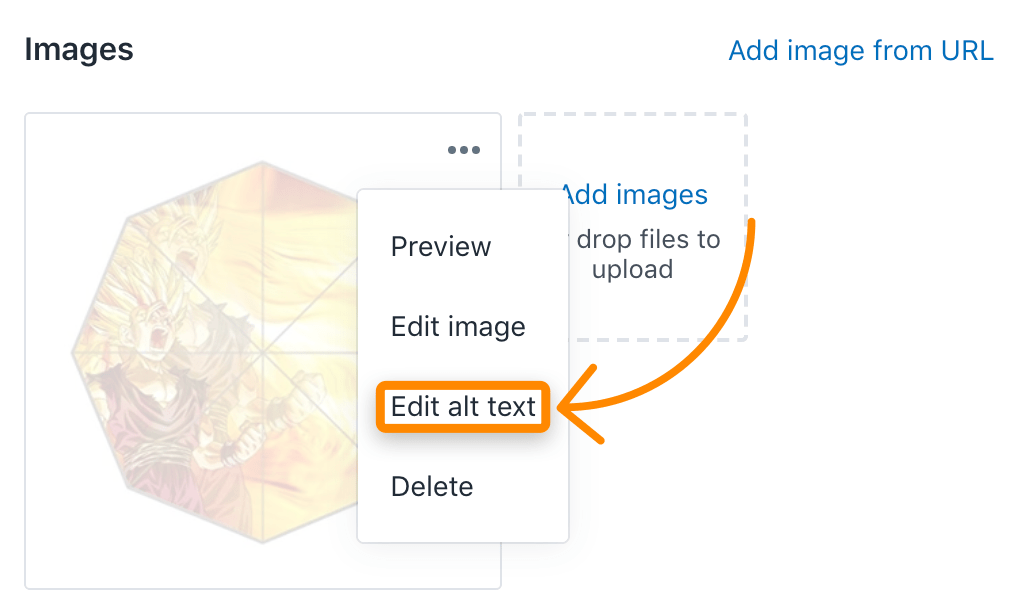
Keep in mind that your alt text should be useful content. While it’s considered a best practice to include appropriate keywords that are relevant to your page content, keyword stuffing that negatively affects user experience could result in your site being flagged as spam. Limit your alt text to just a few targeted keywords for the best results.
Internal Linking
Internal linking refers to the act of adding a link from “Page A” to another “Page B” on your site. This is useful because it can pass some of the SEO value of one page to another and increase user engagement by making it easier for them to find relevant content on your site.
Luckily for Shopify merchants, internal linking is done practically automatically when you set up your site’s navigation. You can also use an app called AutoLink to help with your automatic internal linking. The app allows you to create internal links automatically for selected keywords in your product descriptions or pages.
However, it’s still a good idea to spend some time on strategic internal linking, specifically from authoritative pages to high-priority product and collection pages. For example, if you published a blog post that generated a lot of backlinks, it would be a good idea to add a keyword-rich anchor text from the blog post to one of your relatively high-ranking product pages to give it a potential extra search ranking boost.
4. Technical SEO for Shopify Website
Now we’re ready to move on to the technical aspects of your Shopify site that can be optimized to improve your search rankings.
Basic Setup
Before we cover how to build a technical SEO foundation, we must first ensure that you have a basic setup to gather the necessary data.
- Google Analytics: This will be used to track and report your website traffic data. If you don’t already have this set up for your Shopify store, Shopify has a guide on how to set up Google Analytics within Shopify.
- Google Tag Manager: Use this tool if you plan to integrate more tracking codes and third party apps.
- Google Search Console: This service allows webmasters to keep track of site performance, check indexing status, and optimize website visibility. Here’s a guide on how to verify your store in Google Search Console.
URLs
We have already discussed website architecture and setting up URL structure in the “Optimize Your Shopify Website Architecture” section above. In this section, we’ll go into more detail about the different types of URLs.
Shopify’s URL structure is quite rigid, and there’s not a lot you can do to change it. The only modifications you can make are to URL slugs – that is, the last portions of URLs. Before we jump into explaining different URL types, let’s first see how people can reach your domain.
Domain Canonicalization
Domain canonicalization is the process of choosing a preferred way to reach your domain and explicitly communicating this preferred way.
In theory, there are four different ways that someone could reach your website’s homepage:
- http://yourdomain.com
- http://www.yourdomain.com
- https://yourdomain.com
- https://www.yourdomain.com
Can you spot the difference? Your homepage can be accessed with or without the ‘www’ subdomain and through either ‘HTTP’ or ‘HTTPS’.
Additionally, your Shopify store can also be accessed through yourdomain.myshopify.com. That’s a lot of different ways to reach your website’s homepage!
The main goal of website canonicalization is to avoid duplicate content dilution of your website’s link equity. You want your website to be accessed through a singular URL which can be achieved by redirecting all others to your preferred URL.
If you don’t already have your third-party domain connected to your Shopify store, you can use this Shopify guide on how to connect your custom URL.
Once your domain is connected, follow these steps to set up domain canonicalization in Shopify:
- Log on to your Shopify admin console
- Go to Online Store > Domains
- If it says, “Traffic from your domains is not being redirected to this primary domain”, click the blue “Enable Redirection” link
- Verify that your domains are now being redirected to your primary domain by going back to Online Store > Domains
- You should see a message that says, “Traffic from all your domains redirects to this primary domain”.
Now we’re ready to discuss different URL types!
Collection URLs
As we discussed earlier, product categories are called “collections” in Shopify. Collections have the following default URL structure, but you can define collection names yourself: https://yourdomain.com/collections/$collectionName
So, if you have a collection called “car cameras”, the collection URL would be: https://yourdomain.com/collections/car-cameras.
Tag URLs
Besides grouping products in collections, you can also tag related products. For instance, you may want to tag all car cameras with wifi. You can then use the following tag URL to find all the cameras with wifi: https://yourdomain.com/collections/car-cameras/wifi
Product URLs
Product URLs will have the following default structure: https://yourdomain.com/products/$productName
Similar to collections, you can change the URL slug for product pages but not the path leading to it.
This means that a product named “viofo wr1 car dash cam” will have this URL: https://yourdomain.com/products/viofo-wr1-car-dash-cam
Now we have a problem where your product is available under multiple different URLs. Uh oh! The “viofo wr1 car dash cam” is available under: https://yourdomain.com/collections/car-cameras/products/viofo-wr1-car-dash-cam, which is canonicalized to: https://yourdomain.com/products/viofo-wr1-car-dash-cam.
This situation is not ideal because it sends the wrong signals to search engines for crawling the collection URL and then canonicalizing the product URL. Link authority is also not passed to other product pages, which need higher search rankings.
So, how do you fix this problem?
You need to stop Shopify from linking to the product URL that’s canonicalized. Here are the steps to do this:
- Log on to the Shopify admin console
- Go to Online Store > Themes
- Click the Actions drop-down menu and select ‘Edit code’
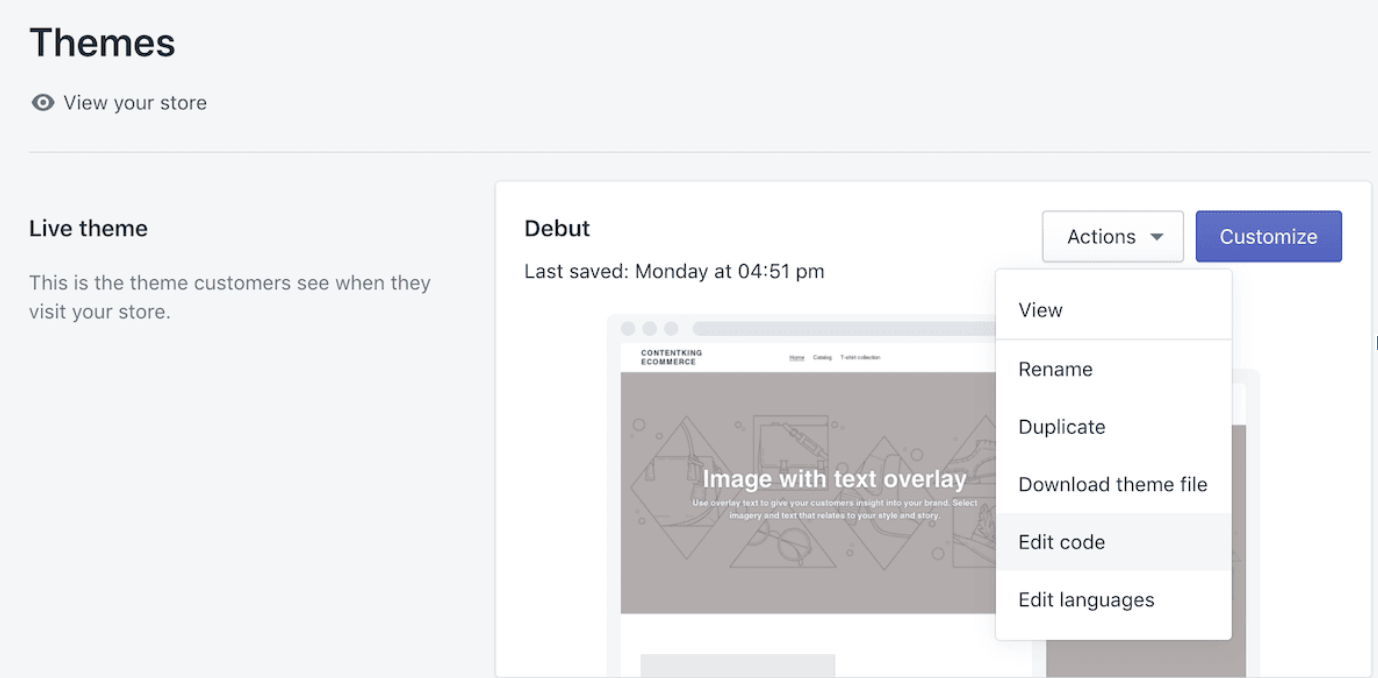
- In the Snippets folder, select ‘product-grid-item.liquid’
- Replace <a href=”{{ product.url | within: current_collection}}”class=”product-grid- item”> with <a href=”{{ product.url }}” class=”product-grid-item”>
Product Variants
What if our product “viofo wr1 car dash cam” is available with different variants? For example, “white viofo wr1 car dash cam” or “grey viofo wr1 car dash cam”.
If you define product variants in Shopify, the platform automatically adds a ?variant=$id to the end of the URL. This means that the grey version of our car camera would be available through the following URL: https://yourdomain.com/products/viofo-wr1-car-dashcam?variant=123456789
Unfortunately, this URL is canonicalized to the main product. This means that search engines will not index and rank this product variant page. If you find that your visitors are specifically searching for product variants, it would be a good idea to create separate product pages for each variant rather than product variants.
Page URLs
In addition to collection, product, and category pages, your Shopify site will also have pages like “About Us” or “Contact Us”.
These pages will have the following URL structure: https://yourdomain.com/pages/$pageName
This means that your “About Us” will have the following URL: https://yourdomain.com/pages/about-us
Blog URLs
Finally, we have blog URLs. Even if you don’t have any blog articles yet, Shopify creates a blog overview page for you by default at: https://yourdomain.com/blogs/news
Your blog article URLs have the following URL structure: https://yourdomain.com/blogs/news/$articleName.
For example, a blog article named “how to install car camera” will have the following URL: https://yourdomain.com/blogs/news/how-to-install-car-camera
How to Manage Shopify Website URL Redirects
When you manipulate URLs, Shopify will ask you if you want to create a 301 redirect. We highly recommend creating 301 redirects if your store is already live. The Shopify redirect manager is a cool feature for importing and exporting redirects to or from Shopify.
Here is the step-by-step process for managing redirects in Shopify:
- Log on to the Shopify admin console
- Click Online Store > Navigation > URL Redirects
- Click the ‘Create URL redirect’ button
- Define the redirect source URL in the ‘Redirect from’ field and the redirect target in the ‘Redirect to’ feld
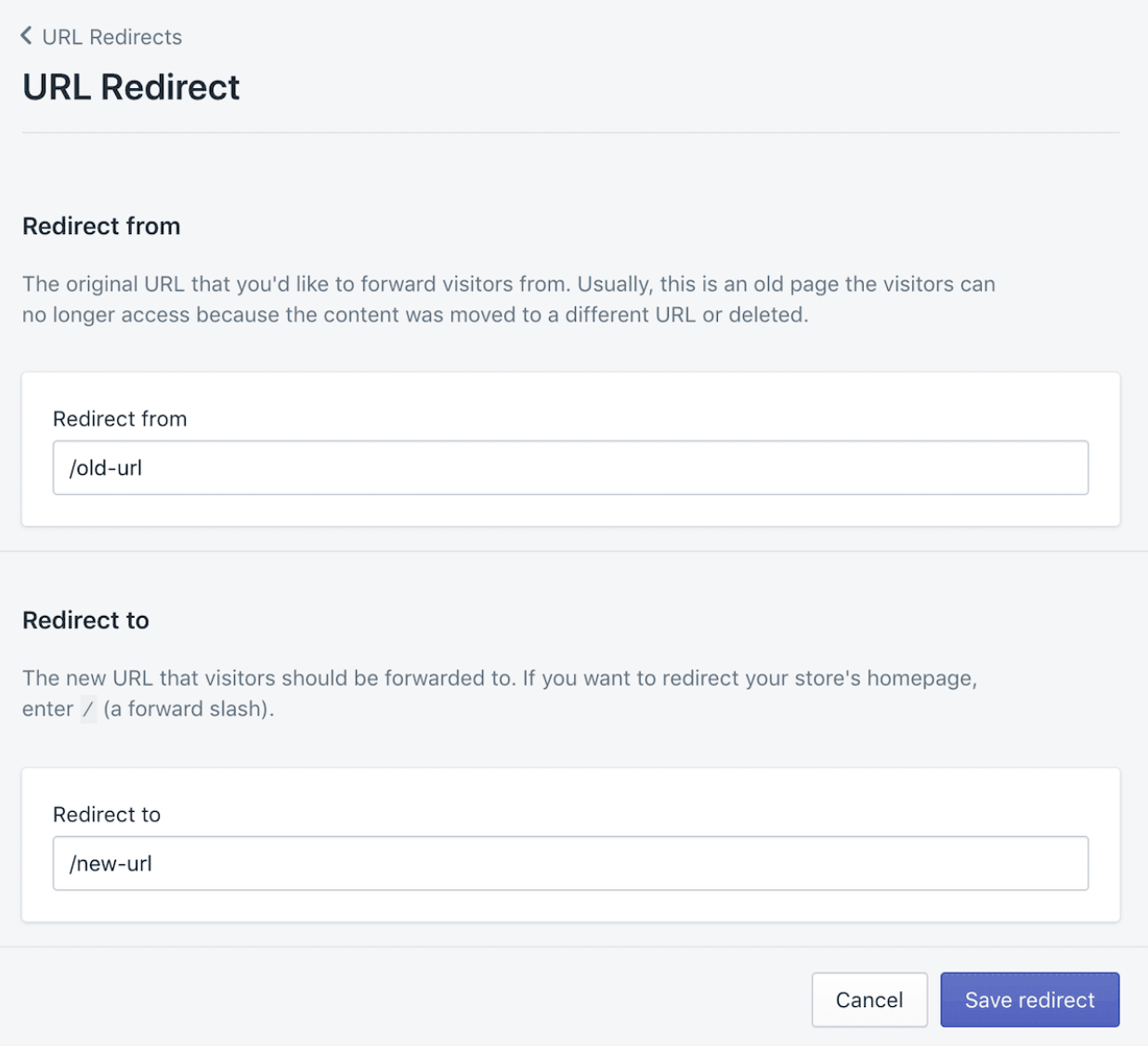
How to Manage Crawling and Indexing for Shopify Website
SEO is like a language you can use to communicate with search engines. In the previous sections, we discussed the set-up of URLs and redirects so you don’t miss any opportunities for search engines to reach (or communicate with) your website.
Communication is a two-way street. That’s why the next step is to ensure that your website can reach (or communicate with) search engines. This is where crawling and indexing comes into play.
Let’s start with the technical aspects that help search engines crawl your website more easily and effectively.
Meta Robots Tags
Meta robots tags provide instructions to search engines on what pages should or should not be indexed in search engines. You can find meta robots tags in the HTML source of a page and it will look something like this: <meta name=”robots” content=”noindex,follow” />
You may choose not to index pages that add no value from an SEO perspective, For example, this might include landing pages that you’ve set up specifically for PPC if they contain highly similar information to other pages that are already indexed on your site.
On Shopify, there are two ways to stop search engines from indexing a page:
- Make changes to your code.
- Use an app that adds a functionality to define these directives within Shopify’s admin console.
Option 1 is riskier and less scalable. However, if you do choose to make the code changes yourself, Shopify has a document that can help you with hiding a page from search engines. Personally, I recommend going for the second option because it is a much more user-friendly approach.
Canonicals
E-commerce websites can often have multiple versions of one page. In that case, canonical urls are used to tell search engines to consider only one version of a page for ranking purposes. Search engines will assign the relevancy and authority from the other version to the canonical version.
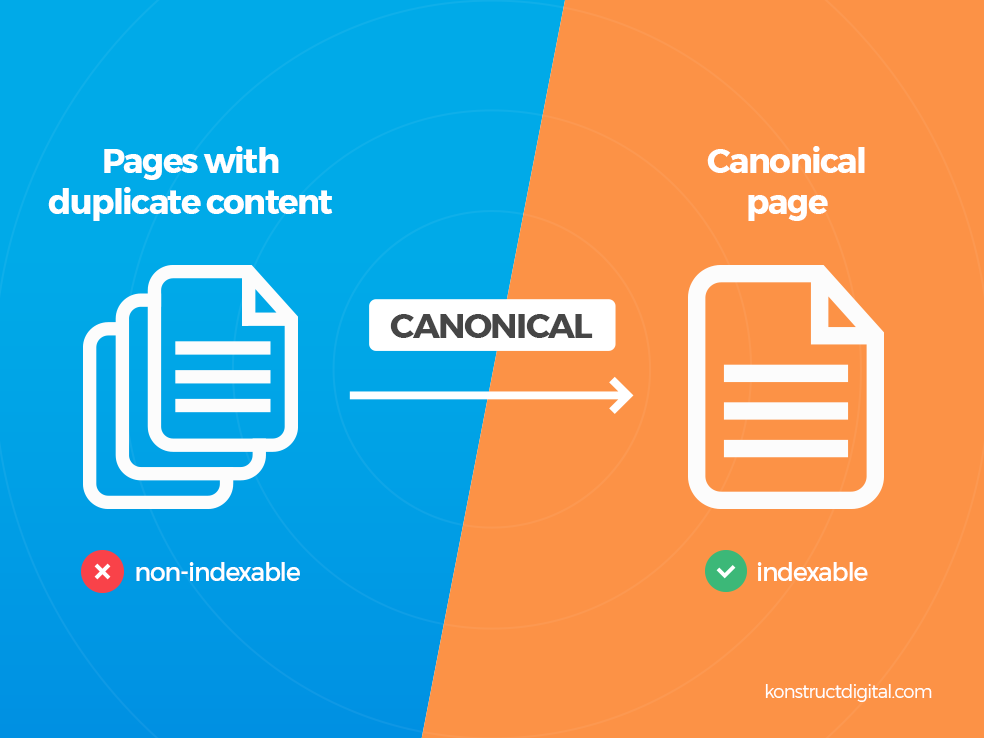
In Shopify, there’s no need to worry about duplicate content for URLs that contain parameters. Shopify always includes a self-referencing canonical to the URL without parameters. For example, if you use the link https://yourdomain.com/collections/cameras for posting on facebook, it will add ?fbclid=XXXXXX to the end of the URL when users click on the link. However, the self-referencing canonical will point to the URL variant without the parameters.
If you want to play around more with your canonical preferences in Shopify, you can edit your theme’s code. Shopify has a helpful guide to help you learn more about editing the canonical within shopify.
Pagination Attributes
Page attributes provide signals to search engines regarding the content spread across a series of pages. The syntax for pagination attributes looks like this: rel=”next” and rel=”prev”
Most Shopify themes support pagination attributes, so this is one less thing you have to worry about!
Robot.txt
Robot.txt is the file that contains the rules for crawlers and provides information about what they can and cannot access. Shopify comes with a default robot.txt for every store that is automatically generated and maintained. This means that you cannot manually change your robot.txt through Shopify.
The following photo shows the beginning of a robot.txt for a Shopify store:
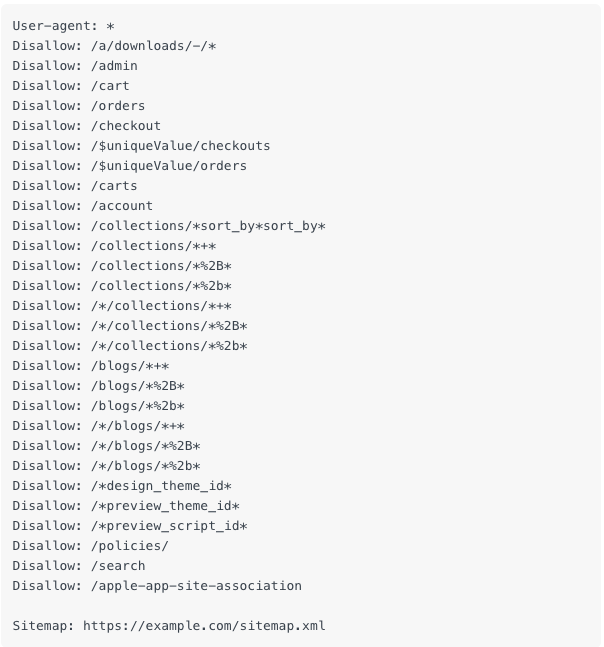
As you can see from the photo, Shopify prevents search engines from accessing account pages, checkout pages, cart pages, internal search results pages, and a few more that could result in duplicate content issues. The photo also shows the sitemap in the robot.txt, which we will cover in the following section.
XML Sitemaps
An XML sitemap is a document created automatically by Shopify that tells search engines which content on the website should be crawled and indexed. Although search engines will look for the XML sitemap within the robot.txt file, we recommend submitting this file through Google Search Console and Bing Webmaster Tools.
The following photo shows what a XML sitemap looks like:

If you want to go deeper and control what’s included in the sitemap generated by shopify, you can use app integration like Smart SEO.
Structured Data
Structured data is data organized in a predefined format. One of the important types of structured data to note is schema. Schema markup, found at schema.org, is a kind of metadata that creates an enhanced description (AKA a rich snippet) once added to a webpage. This helps search engines understand the webpage content and provide context to your page on the SERP.
Although there is no guarantee that Google will display rich snippets, using proper schema markup will boost SEO and increase the probability of search engines ranking your pages highly.
The following schema types are useful to Shopify stores:
Let’s use the example of creating and implementing product review schema. This photo shows the types of markup specific to reviews:
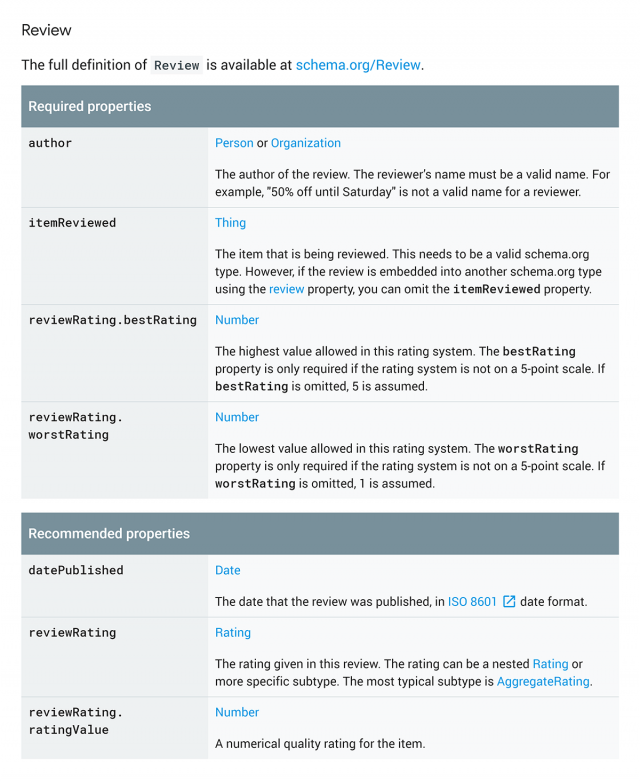
Structured Data Markup Helper is a helpful tool to set up schema markup. Here’s the step-by-step process for using this tool to implement schema in Shopify:
- Go to the Structured Data Markup tool and select “products” as your data type.
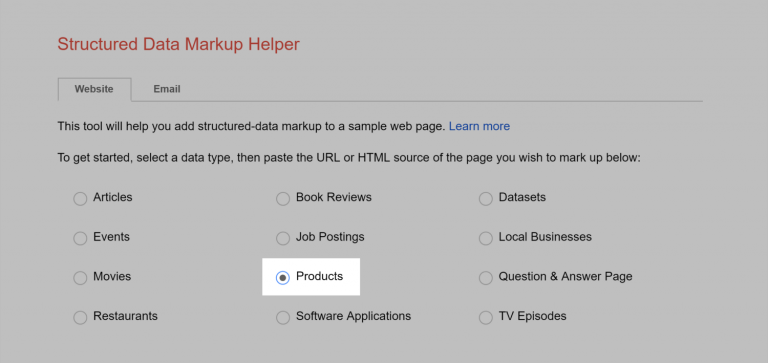
2. Find a product from your Shopify store with a review and rating.
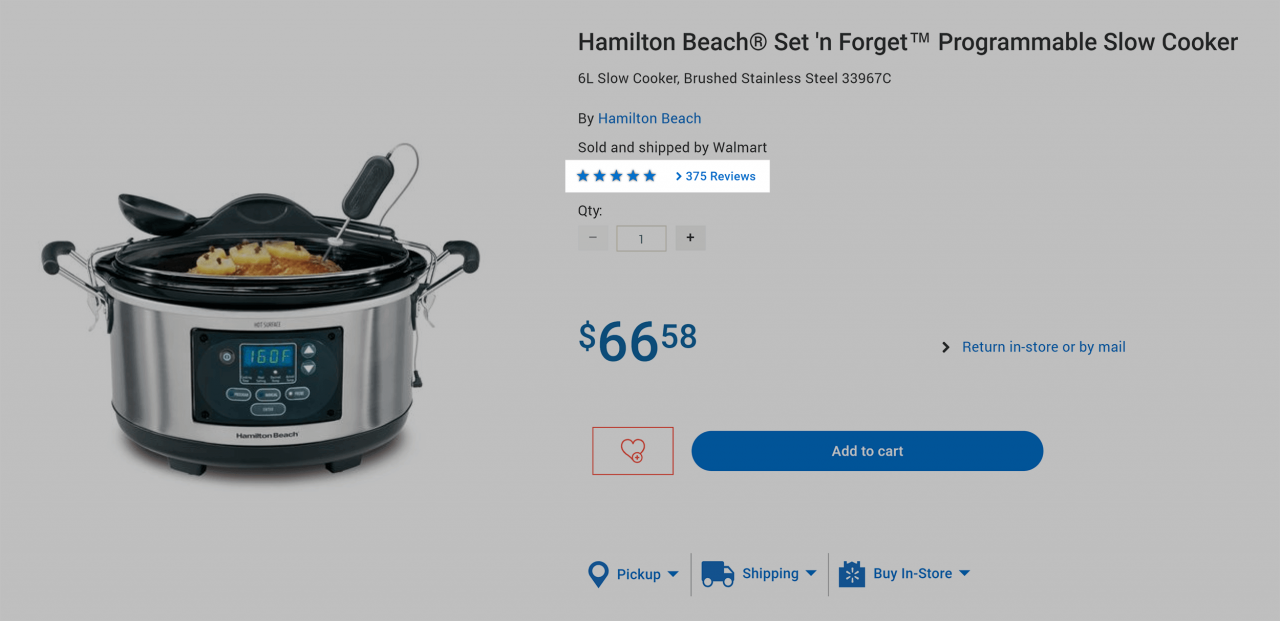
3. Paste the URL of that product page in the Structured Data Markup Helper URL field and click “Start Tagging”
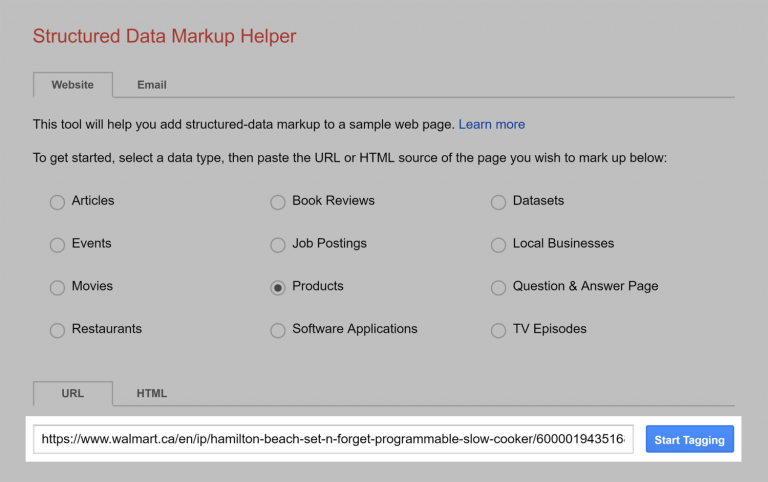
4. Highlight the section of the page you want to tag. In this case, we’re going to focus on product reviews and ratings.
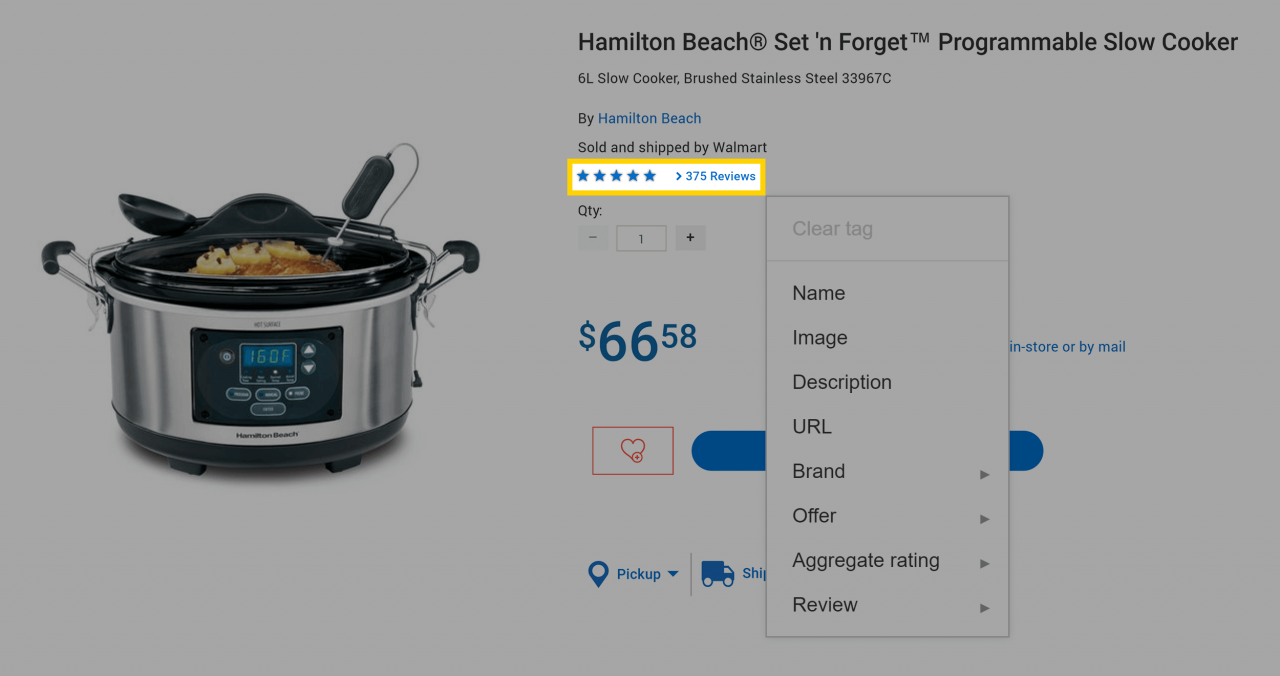
5. If your product was reviewed by a single person, choose “Review”. Then highlight the name of the person that reviewed the product, the date of the review, etc.
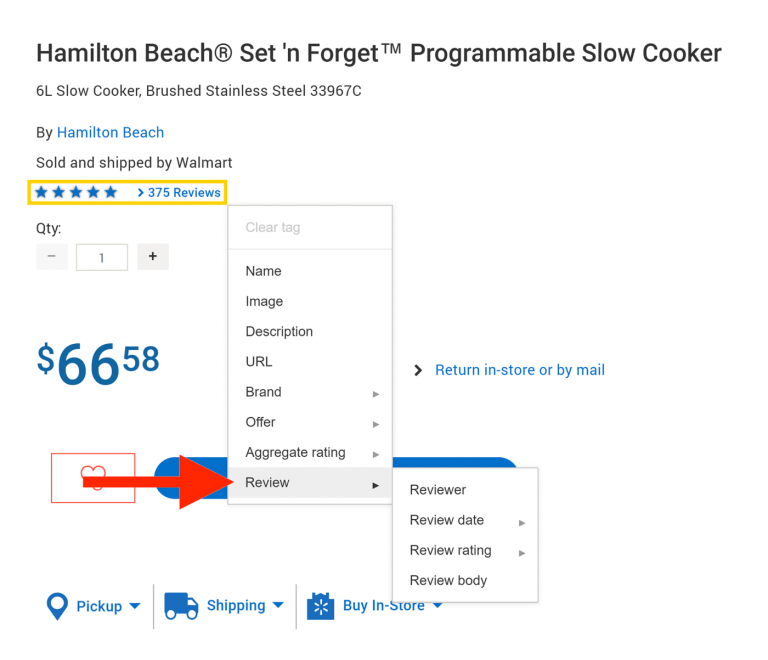
6. If multiple customers reviewed the product, highlight the number or star rating, and select “Aggregate Rating”.
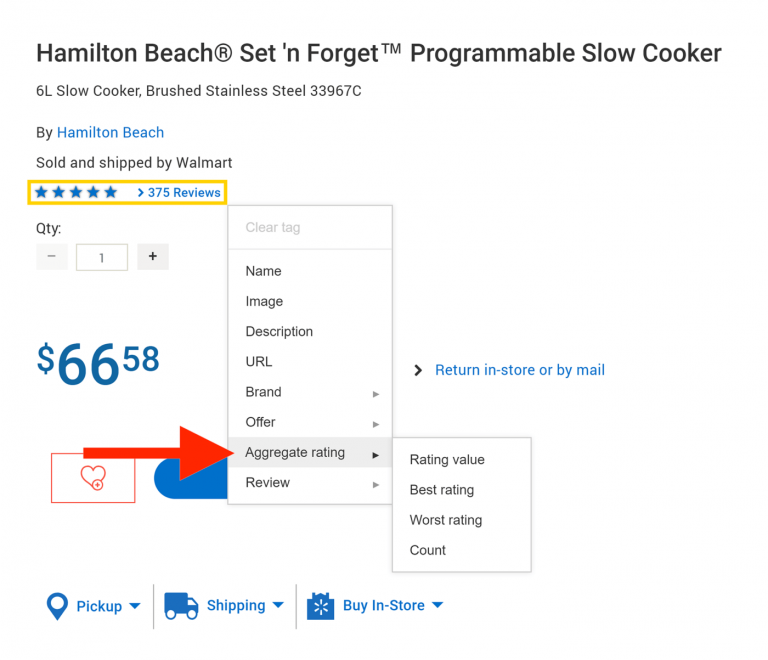
7. Make sure to provide as much info as you can. For example, don’t forget to highlight the number of reviews and choose the “count” tag.
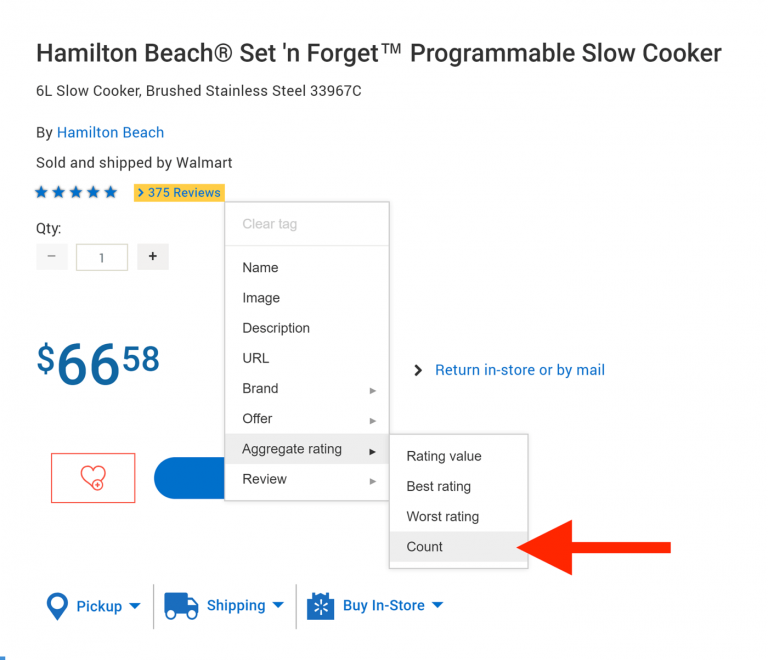
8. When you’re done, choose “Create HTML”.
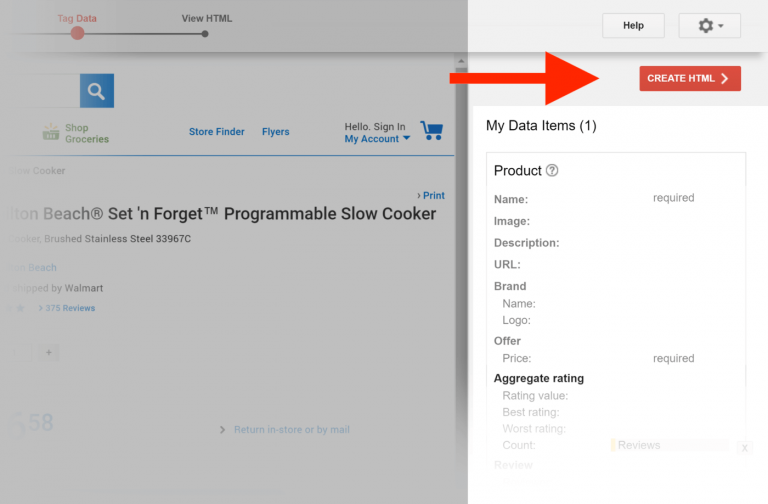
9. You can either copy and paste this new HTML into your page or add the new Schema markup to your existing code.
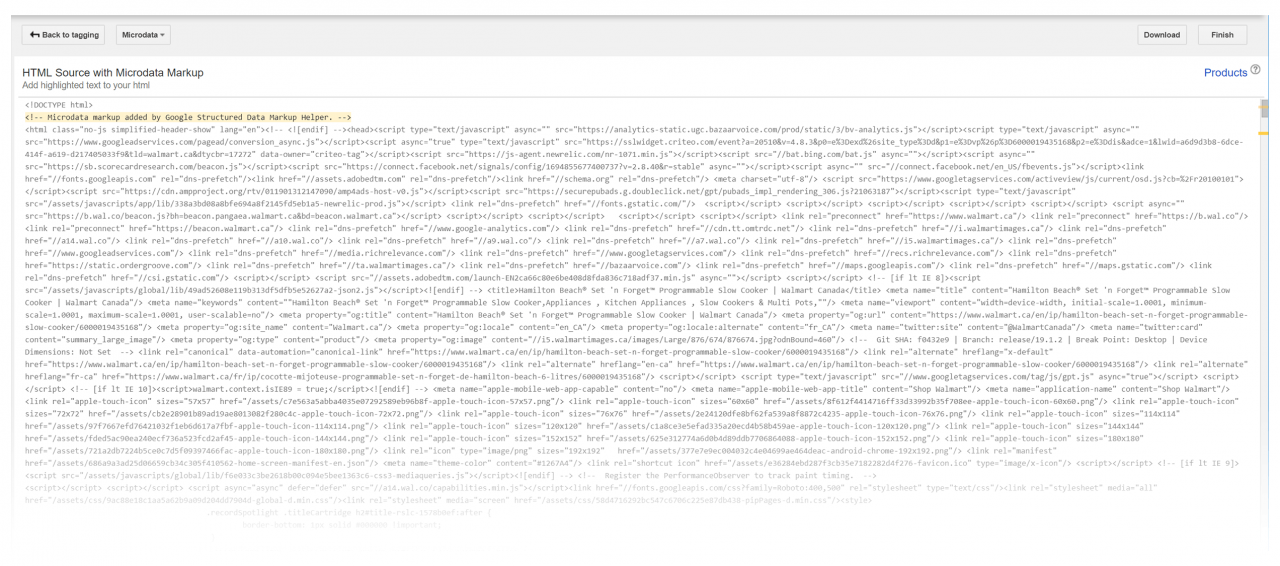
Without the help of a developer, we do not recommend editing your main website. Instead, you can use apps like JSON-LD for SEO to implement schema changes and add markups.
Page Speed Optimization
Like any other CMS platform, you’ll want to add themes, apps, and third-party plugins to your website. However, these all take up a lot of server space and can seriously slow down your store.
Optimizing the page load speed of your Shopify website should be one of your top priorities. Why? Slow websites lose orders to fast websites. A page load time delay of 2 seconds is associated with a 103% increase in bounce rate (Akamai).
Don’t worry! There are a few different ways you can optimize your page load speed:
- Use a custom theme and build your store from scratch. Although this option is more expensive, it will allow you to keep track of what you’re adding to your site. If your budget is tight, you can also opt for using a lighter theme instead.
- Avoid using apps when possible, and hire a Shopify expert instead. Every time a webpage loads, it must also load the code for all the apps on your site, which can significantly decrease page speed. A Shopify expert can help you add code snippets in the page source so you can use fewer apps and optimize your page speed.
- Serve images through a CDN (content delivery network). Luckily, Shopify runs on a world-class CDN!
- Implement lazy loading for your images.
- Implement all the tracking scripts in Google Tag Manager. This will help to reduce the number of requests that pages make while loading.
5. Link Building for Shopify Websites
Great work making it this far in our Shopify SEO guide! Now that we’ve covered the on-page and technical aspects of your Shopify store, we’re finally ready to dive into our final section on link building!
According to Google, link building is just as important as content! External links to your Shopify store build domain authority, drive traffic, and increase consumer trust in your brand. Think about it – if you see a Shopify product mentioned on another website, would you be more likely to purchase that product? Probably!
For Shopify stores, one of the best ways to get backlinks from external sources is through blog content. The more blog content you have, the easier it is to get backlinks. We’ll discuss additional ways you can build links to your Shopify store in the following sections.
Find unlinked mentions
Let’s first start with the low-hanging fruit: people who are already discussing your products but have yet to link to your Shopify store. This is an easy and effective first step for diving into the world of link building
Ahrefs is a great SEO software that can help you find unlinked mentions. In Ahrefs, the Content Explorer is a mini search engine that will help you find pages and see mentions about your brand. I’ll use the example of the store “petvalu” to show you how it works.
1. Start by searching for your brand name in the Content Explorer and exclude results from your website. As you can see in the photo below, I’ve entered “petvalu” -site:petvalu.com. You can swap out “petvalu” for your domain when searching.

2. Add filters to get linked mentions from better-quality pages. I am looking for only English pages with domain authority (DM) of more than 30 and at least 50 organic visits per month.

3. The primary goal here is to build links from unique pages that don’t link to you. So, I will use the “highlight unlinked mentions” feature, which will highlight the sites that have never linked to you.

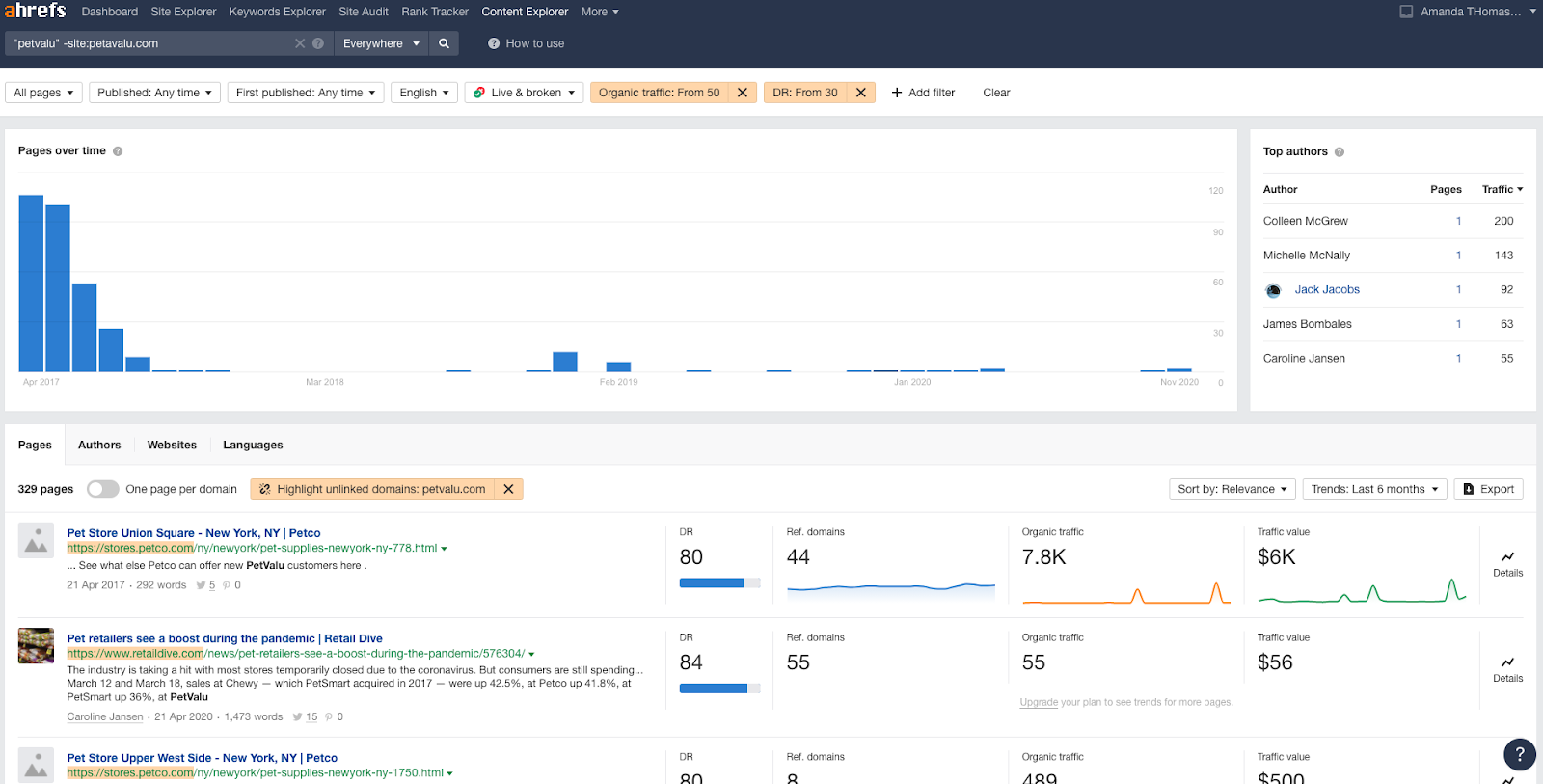
4. Next step is to export these links and find contact information. You can use a tool like hunter.io which will provide you with 5-10 email addresses for each domain.
5. Finally, reach out to these contacts and ask them to link the content mentioning your brand name or products to your website.
Get your Products Reviewed by Sending Free Samples
After tackling the low-hanging fruit, you’ve got to work a bit harder to build links to your Shopify store. One of the strategies you can take may be to send free samples of your products to people (most likely bloggers) who write about your industry or niche market. Sending them a free sample might inspire them to write a review about your product on their blog or website and link to your Shopify store.
For example, check out the link on the goodhousekeeping website to a Honeywell Humidifier:

Try using the following Google search for one of your product categories: “best [keyword or category]”. This will give you an idea of who is writing content that would benefit your brand.
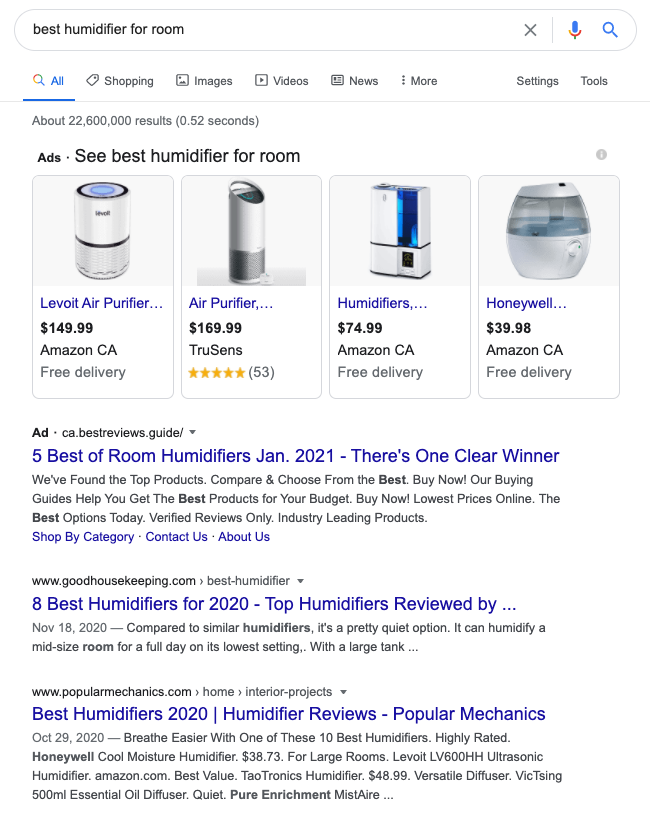
Reach out to these sites about sending them a sample. Remember, you can use the hunter.io tool to find 5-10 email addresses for the site. It’s also a good idea to ask these people for a product review so it doesn’t seem like you’re bribing them in exchange for links!
Guest Blogging on Relevant Sites
Guest blogging is another effective strategy for building relevant links to your website. You can easily write a valuable guest post on relevant websites and add links to your site.
One of the best ways to find guest posting opportunities is to use advanced search operators through Google. For example, you could try “[keyword]” “write for us” or “[keyword]” “submit guest post”. This will give you the sites in your niche that are open to guest posting.
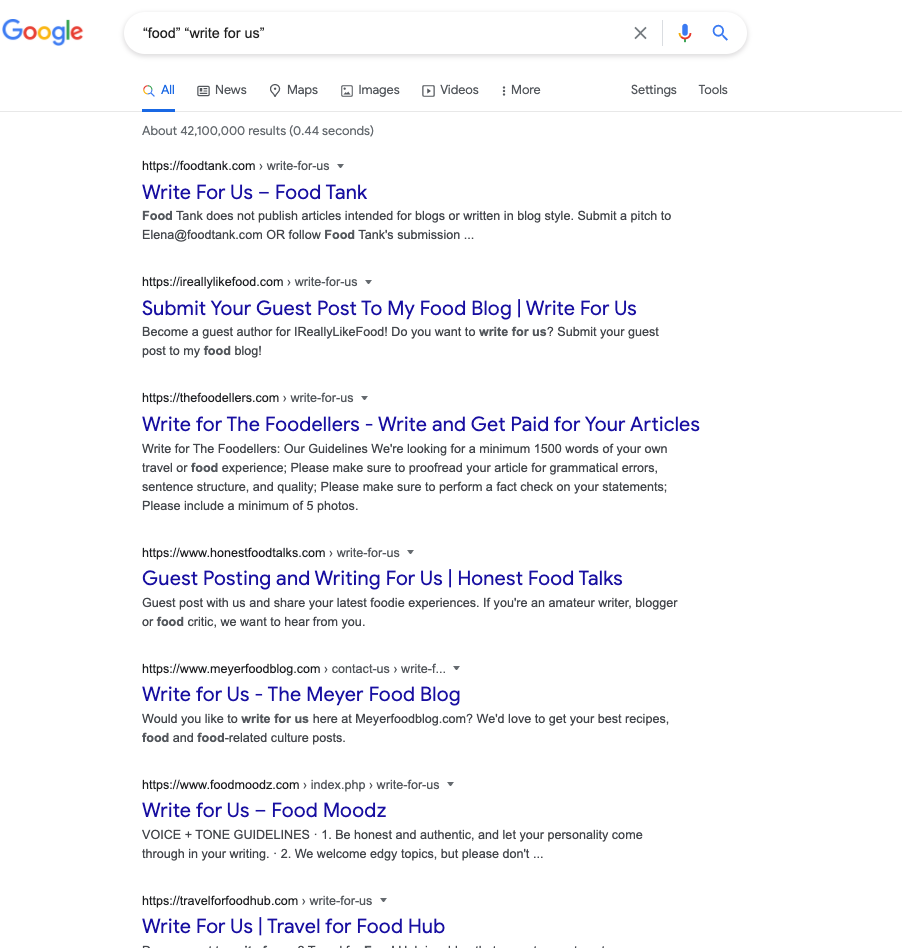
Reach out to the blogs or websites that make sense to your brand. It’s a good idea to include a few pitches on topics you’d like to write about and attach previous content you’ve written so they can get a sense of the quality of your writing.
Ideally, you want guest posting to be a mutually beneficial experience. You’ll get to build links to your store and they get awesome content to add to their website.
Shopify SEO Yourself Or Hire An SEO Company?
Congratulations on making it through this entire Shopify SEO guide! You now have strong foundational SEO knowledge that will help you boost the search rankings of your Shopify store. If you feel like you’ve got a good handle of the information covered in this guide, it’s time to put your knowledge into practice and get to optimizing!
However, if your head is spinning from all that information, the SEO experts at Konstruct are always here to help. You may have heard the saying: “if you want something done right, do it yourself.” However, this doesn’t always apply to SEO! New strategies, technologies, competition, and paid marketing spending changes make SEO a constant battle.
With new search algorithm updates dropping every 2 weeks, it can be super tough to keep on top of new SEO best practices in addition to the foundational knowledge covered in this article. In order to ensure that your organic traffic continues to grow (or at least stays consistent) it’s always a good idea to hire an SEO expert. Reach out to the SEO experts at Konstruct Digital today!
Frequently Asked Questions About Shopify SEO
How can I Improve my eCommerce Store SEO?
Unfortunately, SEO isn’t as easy as adding a plugin to your Shopify store! You’ve got to put in the time to establish an SEO strategy. In this article, we have covered how to build an SEO foundation for your Shopify platform covering technical aspects, keyword research, on-page SEO, and link building. However, hiring an SEO specialist will save you time and energy, help you put a solid SEO strategy into place, and improve your organic ranking consistently.
How do Shopify Stores Rank on Google?
Like any other platform or website, if you follow all the fundamentals and build a strategy, your Shopify store can rank on Google. With Shopify, there are default sections to help you optimize SEO. However, for more advanced SEO, you might need to use app integrations or customize your theme.
Is SEO Important for eCommerce?
Google receives 1 out of every 5 initiatory product searches. This amounts to potentially hundreds of millions of queries each day! This means that the search engine ranking of eCommerce websites is just as important as any other site. A higher SERP ranking leads to more organic traffic, which ultimately leads to more sales!
When it comes to eCommerce, an SEO blunder can cost you a pretty penny in lost sales!
SEO should be a crucial part of any eCommerce marketing strategy to ensure that your site and products rank in search results. However, some eCommerce businesses find that their site and product pages are still lost and floating around in the Google abyss.
If this you, you’re in luck! For this blog post, we asked 16 digital marketing experts to share the most common (and detrimental) eCommerce search engine optimization mistakes. By the end of this blog post, you’ll know exactly what NOT to do when setting up or optimizing your eCommerce website.
For your reading pleasure, we divided their answers into the following categories:
- Inadequate product descriptions, titles, and images
- Using duplicate content for product descriptions
- Mishandling out of stock pages
- Poor website architecture
- Poor URL structure
- Keyword stuffing product pages
- Not using product schema markup
- Using tabs or accordion content
- Using dynamically generated content
- Focusing only on classical SEO ranking factors
So… how do these mistakes negatively affect your search rankings? And how can you fix them to create a more search-engine-friendly eCommerce site? Let’s dive in and find out what the experts had to say!
Inadequate Product Descriptions, Titles, and Images
Matthew Kay

“I frequently run across ecommerce stores that have nonexistent or inadequate product descriptions and titles. Doing a decent job of titling and describing your products is a great way to make sure that they have the best chance possible to rank for relevant terms.
Oftentimes when looking at the difference between a product page that ranks and one that isn’t even on the map, the big differentiator is frequently whether a relevant description exists. While having good titles and descriptions is great for SEO, it’s also something that can assist conversion and convince store visitors to purchase items.”
Steven Orechow

“Optimize Your Product Pages from the Get-Go!
There are a lot of eCommerce sites that have great looking product pages but aren’t ranking to their full potential. It’s easy to pump out a high volume of products without being mindful of on-page structure, title tags or meta descriptions. However, once you have hundreds of products in your store, going back and fixing them can be quite a headache, especially if you have limited budget/resources.
Here are a few tips that can help you lay the initial groundwork for your eCommerce SEO strategy and maintain it going forward:
Keyword Research: Get your product-specific keywords ready during the planning phase. This way, you can structure your pages around keyword data as you build out your site.
On-Page: Try to include the primary keywords in your title, product description, URL, title tag and meta description. There are plenty of Shopify Apps, Magento Extensions and WordPress plugins out there to help you do this at scale with accuracy and consistency.
Product Images: Making sure you have quality product images is pretty common knowledge, but there are a few things to consider before uploading them to your online store. Properly resizing your images for the web and being mindful of file size will help you keep your site’s page speed in check. You may also want to consider serving them in a progressive format like WebP or AVIF for increased web performance without having to compromise quality. Don’t forget to include your primary keywords in the alt text and file name!”
Krista Lawson, Break the Web

“The biggest SEO mistake we see eCommerce sites making is not optimizing their product pages according to search demand. This is a huge problem because you might be wasting your time promoting your product in a way that no one is using to search for it, and that means it won’t be seen.
For example, optimizing your product page for “12-cup coffee pot” when people are searching for “Cuisinart 12-cup coffee pot” could seriously lower your ranking in SERPs… honestly, you might as well be invisible.
When you’re writing your headlines, title tags, and product descriptions, spend some time researching search demand and the keywords people are using to find your product.”
Using Duplicate Content
James Norquay, Prosperity Media

“One very common eCommerce SEO mistake we see is companies using duplicate content for product descriptions. It is advisable to make unique content where possible for products you want to rank well. It is also important to build out your category level pages with unique content as this will also assist with ranking the category level page.
Another common issue you need to work on is checking your scripts on the website, if you are no longer using a heat mapping tool for example, remember to remove the scripts. These can really slow down the load times for eCommerce sites. You need to be running regular script audits of the website.”
Steven van Vessum, ContentKing

“A customer published tens thousands of duplicate variants, products that were exactly the same as existing products but just had a different color.
As you would expect, Google didn’t index most of these near-duplicates. It just took up precious crawl budget while also diluting the internal flow of link authority (this was shared with the near-duplicates).
We recommended the customer either canonicalize these product variants to the primary product, or that they create unique product descriptions and images for each product variant they wanted to get indexed.
They ended up removing 80% of these product variants, and adding unique content to the remaining 20%.”
Mishandling Out of Stock Pages
Niki Mosier, Two Octobers

“One eCommerce mistake I see often is mishandling of out of stock pages. Just listing an item as out of stock with no further information provides a poor user experience and is a missed opportunity.
If an item is out of stock, a few things should happen on the website:
1. Give an approximate back in stock date if possible.
2. Give users an option to be notified when the product is back in stock.
3. Recommend a similar product to the customer to hopefully still get a sale.
Providing more information for out of stock items can help keep a user on the site and hopefully bring them back to the site when the item is back in stock.”
Zawad Iftikhar, Slyecom

“Not doing a technical audit to clean up the dead and no longer in inventory products periodically is one of the most common e-commerce SEO mistakes I see. eCommerce sites offer all kinds of filters and options on product pages without planning whether it is something that they want to be Indexed in Google. This creates a huge number of dead URLs and index bloat which eventually holds them back in Google search results.”
Poor Website Architecture
Jonathan Gorham, Engine Scout

“One of the biggest SEO mistakes I see on eCommerce sites is poor website architecture. Ecommerce websites by nature have a lot of pages and it’s important you get the structure right from both an SEO and user experience standpoint.
For example, let’s say you sell shoes online, you’d want to first split them into men’s and women’s categories and then further refine these by sub-categories depending on what type of shoes you sell. Helpful sub-categories for shoes could include sneakers, boots, dress shoes, sandals etc. Additionally, adding helpful filters will allow customers to shop by brand, colour, price, etc.. while also helping to increase your store’s organic visibility for long-tail search terms that can drive a lot of sales.
As a general rule of thumb, always select categories based on the best user experience, not on what keywords you think have the highest volume and your store will do well.
If you fail to get your eCommerce store structure right then it’s not only going to negatively impact your SEO, it’s going to confuse customers who will find it difficult to shop for the products they want and your store will miss out on sales.
If you find that your eCommerce structure is confusing and some of the categories don’t make sense or it’s hard to find products. The best thing you can do is simplify your store by reducing the number of category pages on your store and group as many similar themed product pages onto the appropriate category page. If you reduce category pages but still notice it’s difficult to find products easily you can always add sub-category pages or filters if it makes sense from a user perspective.”
Poor URL Structure
Eleanor Reynolds, Contrast

“Most online shops offer filtering options on their category or subcategory pages (filter by brand, size, colour, type, etc.). You can also order products by newest in, price (highest to lowest, lowest to highest, biggest discount etc). Every single one of these options can create a new URL. For example:
www.example.com/shoes
www.example.com/shoes?size=4
www.example.com/shoes?size=4%colour=red
www.example.com/shoes?size=4%colour=red%brand=dune
www.example.com/shoes?size=4%colour=red%brand=dune%price=lowest-to-highest
Depending on the order in which you add the filters, the urls look different. For instance you could have:
www.example.com/shoes?size=4%brand=dune%colour=red
or
www.example.com/shoes?size=4%colour=red%brand=dune
or
www.example.com/shoes?colour=red%size=4%brand=dune
You get the picture – this one URL could have 9 different variables – add that across every single type of filter and every single way you could organise those pages: you suddenly have yourself thousands of pages with the same content on them. This is absolutely catastrophic for SEO, unless you have what is known as a canonical tag.
The canonical tag is placed on all of these possible urls, and basically says, this is the main page, crawl and rank this one, ignore me:
www.example.com/shoes
It’s incredibly simple to implement on the majority of content management systems out there, (some maybe more difficult, but with a good developer you should be able to find a way around it), and it really does save the day in terms of SEO sometimes. And yet, tons of eCommerce stores don’t do it!
And, be sure to include brand names and model numbers in your H1 headings and title tags. Don’t forget to include keywords in your image alt tag info, but remember not to overstuff the page with the same keyword and phrases over and over again.
Remember, Google prioritizes relevancy, so you always need to be thinking about ways to make it easier for the searcher to find exactly what they’re looking for. Be specific!”
Nick LeRoy, Nick LeRoy Consulting LLC

“The biggest ecommerce issue I see is not controlling how search engines crawl and index the website. Ecommerce websites are known to have faceted navigation that can cause an extreme amount of pages. Think about it. If a user can choose both colors and sizes the permutations can be extensive. Now imagine if you add 5, 10, 15+ facets that you can mix and match.
It’s also important that faceted navigation not simply be ‘solved’ with the use of the canonical tag. While it may solve for true duplicate content issues (from the permutations) you are still relying on Google to crawl all of these page variations to properly attribute the canonical value. This will very likely make it difficult for Google to allocate resources to crawling/indexing content you actually want included in the search results.
The proper solution is use a combination of meta robots, no index, and robots.txt directives to prevent both the crawling and indexing of faceted pages that do not provide significant search value.”
Dave Nilsson, The Converted Click

“Mostly three things: Duplicate content, bad url structures and poor internal linking/architecture.
With many e-commerce platforms, replicated pages can cause duplicate content or descriptions without anyone knowing about it.
A common example of this is when someone uploads products in bulk without checking everything extensively. Very often a default description item is in place as it is easier, yet it’s a poor reflection.
In turn, url strings become long and complicated.
The last point I’d like to highlight would be a lack of information architecture which follows a solid internal linking structure.
It makes sense that related sections of products or information should be nested closely and easily accessible for crawlers and humans. At times, a user would greatly benefit from being able to easily click on a product category which is the perfect addition to the initial product they are viewing.
Example: we often see cases where there are links and headings saying ‘commonly purchased together’ etc. This could be an opportunity for internal linking to the next relevant product which will be a good addition for the customer and also more sales and revenue.
I feel information architecture in any situation needs to be extensively researched, planned and mapped into relevant sections. In the e-commerce space it is even more essential.”
Keyword Stuffing Product Pages
Ben Walker, Transcription Outsourcing, LLC

“One of the most common eCommerce SEO mistakes I’ve seen is to spam your own site’s pages. What I mean by this is when sites keyword stuff, and go so overboard that the page, or pages, are unreadable. Sites will use their chosen keyword phrase so often in everything including the URL, Alt tags, meta tags, and throughout the content it sends a signal to both the visitors and Google that you are trying way too hard to force this page to rank for whatever term that it backfires on them. It makes the page very difficult to read and comprehend which will cause people to bounce from your page, and that will also hurt your SEO. When visitors bounce from your page, Google will detect it and penalize your page in the search engine results. A high bounce rate will also hurt your site because Google is being told that your page is not what the searcher was looking for.”
Not Using A Product Schema Markup
Hakon Agustsson, MyTweetAlerts

“Not using product schema markup and not optimizing images for SEO. If you use product schema markup, Google and other tools and websites can pick up all the details about your products and display them correctly. You are making it easier for your products to be seen outside of your website.
Many images on Ecommerce websites are not found in Google Image Search at all. If you make sure that the image filename and alt tag are relevant and descriptive then it is easier for Google to know what images and products you are selling. Most people don’t pay attention to the image filename but preview123.jpg is not as good as black-jacket.jpg.
Why make it so hard for Google to know what images you have on your websites? As people don’t pay attention to those things you can sometimes easily rank in Google Image Search when it is really hard to rank in Google Search for the same terms and keywords.”
Using Tabs or Accordion Content
Geoff Kenyon, Pomar Digital

“One common SEO problem on ecommerce sites is product detail pages often have content in collapsed or accordion containers, or hidden in divs. This is most often product descriptions, specifications, and reviews. Collapsing this content is much cleaner for UX and is often a point of contention between design and SEO teams.
While Google historically said that content which isn’t viewable on page load (ex. tabbed or collapsed content) maybe be discounted, more recently in 2016 Google said not to worry about this; that they fully count this content.
Despite Google saying not to worry about this content, I have found this often to not be the case. When I have worked with clients to change the tabs or collapsed content to be entirely visible on page load, I have typically seen clients improve organic traffic to product detail pages by 5% to 10%.
While some tabbed and collapsed content implementations may not actually deliver the hidden content in the initial page load, my clients had typically served this content to Google, it just wasn’t visible – inherently, these gains were not from now delivering the content to Google, but actually displaying the content to Google.
While you can just show all the content to Google on page load, clients who want to create a tabbed content feel have another option: sites like Home Depot and Motoroso create the feel of tabbed content but have a hovering menu that persists through the product, description, specifications, and reviews section of the page with jump links that help a user navigate through these sections. This enables a site to create more structure and navigation and the product detail page subsections while still exposing the content fully for Google and getting full SEO value from this content.
Using Dynamically Generated Content
James Macnamara, Blink SEO

“Setting up a site to use dynamically generated content to display new product categories / sub-categories.
If you don’t have a static page for that content you can’t appear in organic search, so you’re missing out on the cumulative traffic you can generate to your site just by having as many unique pages as possible. You also miss out on having a cohesive site structure organised semantically around topics—if your product subcategory isn’t linked to its parent category and is instead dynamically generated, then the parent category isn’t supported by a subtopic. This means it’s not as powerful (in the eyes of a search engine).
Reservations around this are justified—not having many products on subcategory pages, user experience, resources for creating new content—but it’s much easier to have the static pages, or at least the ability to create them, in place as early as possible, preferably from the initial build. Think about growing into them rather than worrying about having too many.
Migrations to new URL structures are always a pain, but if you have an eCommerce store with nicely layered product categories and subcategories, migrating to a static structure will be of long-term benefit. And if you’re undergoing a rebuild/changing platforms, don’t start generating content dynamically! This would be potentially disastrous.”
Focusing Only on Classical SEO Ranking Factors
Serbay Arda Ayzit, Contentus

“Focusing only on classical SEO ranking factors 🙂 What i want to say is that most eCommerce companies only try to write more content on category pages, h1s, titles, query rankings, etc. In this part, they are making mistakes by finding low rankings reasons with these factors. But in the e-commerce game, you need to look beyond that and understand why users choose other sites. Most of the time, the main reasons are your range of products and pricing.
Instead of classic factors, try to crawl competition and understand your product range vs. theirs, your average pricing vs. theirs. We all know one of our main goals in SEO is to keep users on the page. If you do this, you will succeed.
Also, the listing is another crucial step because when users enter your page/category, they have some popular products in their minds, which you can also find via keyword research tools. If you don’t put those kinds of products prominent, then the user may bounce back. In the end, popular products, your avg. price, and product range are crucial metrics you need to look at.”
Time To Fix Those eCommerce SEO Mistakes!
Whew! These expert responses were jam-packed with insights on what NOT to do when optimizing or developing your eCommerce website. Now it’s time to get to work!
Here is a summary of some of the best eCommerce search engine optimization tips covered in this article to help you out:
- Ensure that all of your pages, product descriptions, and product titles are keyword optimized and include unique content that hasn’t been duplicated. At the same time, avoid keyword stuffing that could turn potential customers away.
- Provide more information for out of stock items to keep users on your site, such as approximate back-in-stock date or similar products.
- Select product categories based on the best user experience, not on what keywords you think have the highest search volume.
- Use canonical tags and control how search engines crawl and index your website to prevent both the crawling and indexing of faceted pages that do not provide significant search value.
- Use product markup schema so Google and other tools and websites can pick up all the details about your products and display them correctly.
- Create the feel of tabbed content without losing out on organic traffic by implementing a hovering menu that persists through the product, description, specifications, and reviews sections of the page with jump links that help a user navigate through these sections.
- Create static pages for dynamically generated content so your content can appear in organic search results.
- Don’t forget the importance of having a good product range and competitive pricing!
If you’re still stuck on how to improve organic search traffic for your eCommerce website, the Konstruct Digital SEO specialists are here to help! Contact us today to find out how we can add SEO best practices to your eCommerce marketing strategy to help you improve your organic search rankings and eCommerce sales.
Alert! A little green checkmark has been spotted popping up next to local listings on Google! If you’ve recently searched Google for a local plumber or locksmith, you may have noticed one of these little green checkmarks during your query.
This green checkmark is known as a Google Guaranteed Badge. It has recently become available to a limited selection of local service businesses in Canada.
One of the reasons that Google is making the move to roll out the Google Guarantee program is for consumer protection and to help customers avoid fraud. If a business has a Google Guaranteed Badge, Google guarantees that the service listing is credible. Google is even willing to reimburse customers who are dissatisfied with the services they receive from these companies! This guarantee is huge for local businesses because it solidifies a positive online reputation and fosters consumer trust in the brand.
So, how do you get Google Guaranteed? Is your business eligible for Google Guaranteed services? And how could a Google Guaranteed Badge be a gamechanger for your company? Keep reading this article to find out everything you need to know about Google Guarantee for Google My Business (GMB)!
Who is Eligible for a Google Guaranteed Badge?
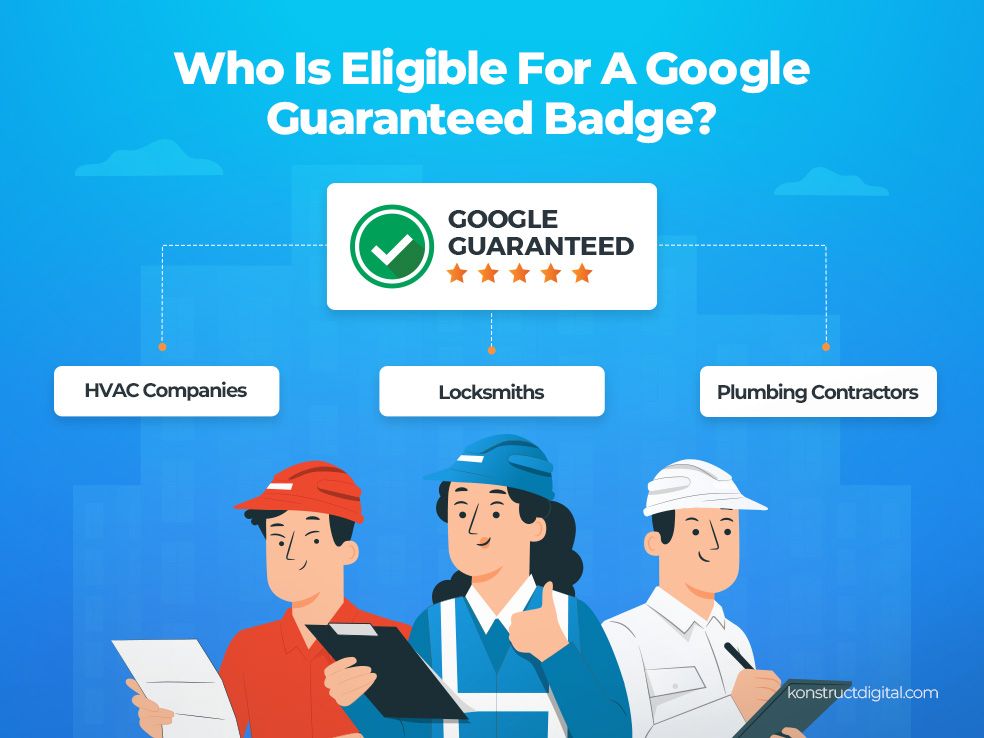
Currently, the Google Guarantee sign-up process is only available to businesses in a select few service categories which differ depending on your location.
In the United States, businesses from a wide variety of service categories including services like pet grooming, lawyers, lawn care, carpet & upholstery cleaning, window cleaning, pest control, appliance repair, and more can sign up for a Local Service listing. The eligibility for Canadian businesses is much more limited with only three eligible service categories:
- Google Guarantee for HVAC companies
- Google Guarantee for locksmiths
- Google Guarantee for plumbing contractors
If your business is eligible for a Google Local Listing and Google Guaranteed certification, you may have already received an email notification from Google sent to the owner of your Google My Business page and a notification on your Google My Business Dashboard.
As the Google Guaranteed program gains more traction, we hope to see more service categories become eligible to sign up for a Local Service listing, earn the Google Guaranteed certification, and reap all the potential rewards from the program!
How to Get Google Guaranteed
If you’re wondering how to become Google Guaranteed, there are two different approaches you can take…
1. Sign up for Local Services Ads
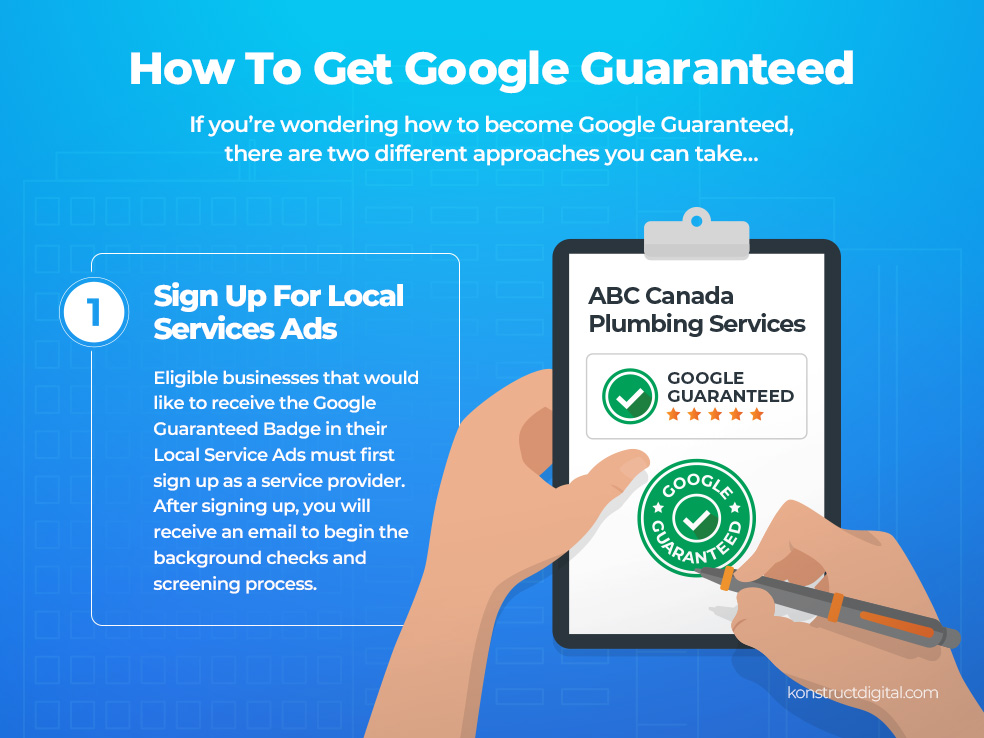
Eligible businesses that would like to receive the Google Guaranteed Badge in their Local Service Ads must first sign up as a service provider. After signing up, you will receive an email to begin the background checks and screening process.
The Google Guarantee is a badge that is awarded to eligible businesses that pass the Google screening and qualification process. The qualification process differs depending on your industry but will most likely involve a screening of your company’s standing relationship with Google. Those who successfully pass the screening process are awarded the almighty green checkmark on their Google Local Services Ads!
Keep in mind that if you take this route, your Google Guaranteed Badge will only appear in your Local Services Ads. Whenever your listing appears in organic Google search results, your Google Guaranteed Badge will not appear alongside your profile. However, there is a way you can make this happen…
2. Upgrade your Google My Business Profile
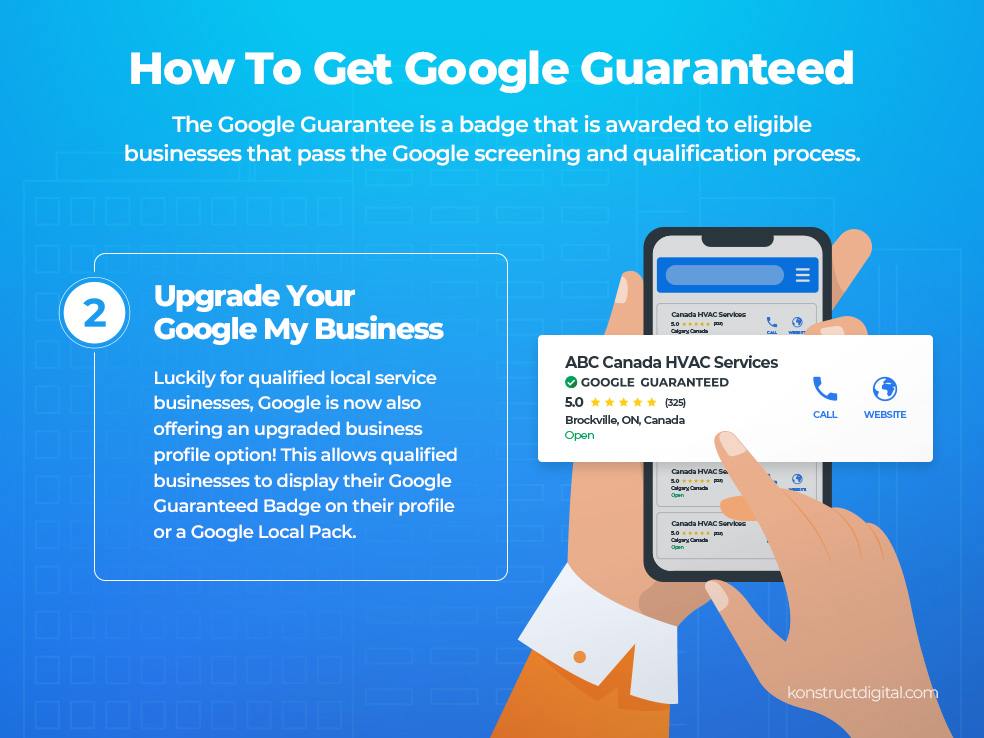
Luckily for qualified local service businesses, Google is now also offering an upgraded business profile option! This allows qualified businesses to display their Google Guaranteed Badge on their profile or a Google Local Pack. A Local Pack is a section of Google’s search results that shows three local businesses related to a user’s query. This means that instead of paying for an ad in which your Google Guaranteed badge will appear, your badge will now also show up next to your listing in organic search results.
How Much Will a Google Guarantee Cost Your Business?
For businesses in the qualified service categories who have signed up for a Local Service listing, there is no cost to having a Google Guaranteed badge appear alongside your Local Service Ads. As long as you pass the screening process, your Local Service Ads will include your Google Guaranteed Badge free of charge. Keep in mind that you pay per lead for Google Local Services Ads, but the Google Guaranteed Badge comes as an added bonus.
Unlike Google Local Services Ads, upgrading your GMB profile to include a Google Guaranteed Badge appear will cost you $50 per month. However, this investment could definitely prove to be worth the additional charge!
TL;DR: If your business is eligible, you can pay per lead to run Local Services Ads that will include your Google Guaranteed badge, or you can pay $50 per month to upgrade your GMB profile with a Google Guaranteed badge.
Is Google Guarantee Worth It?
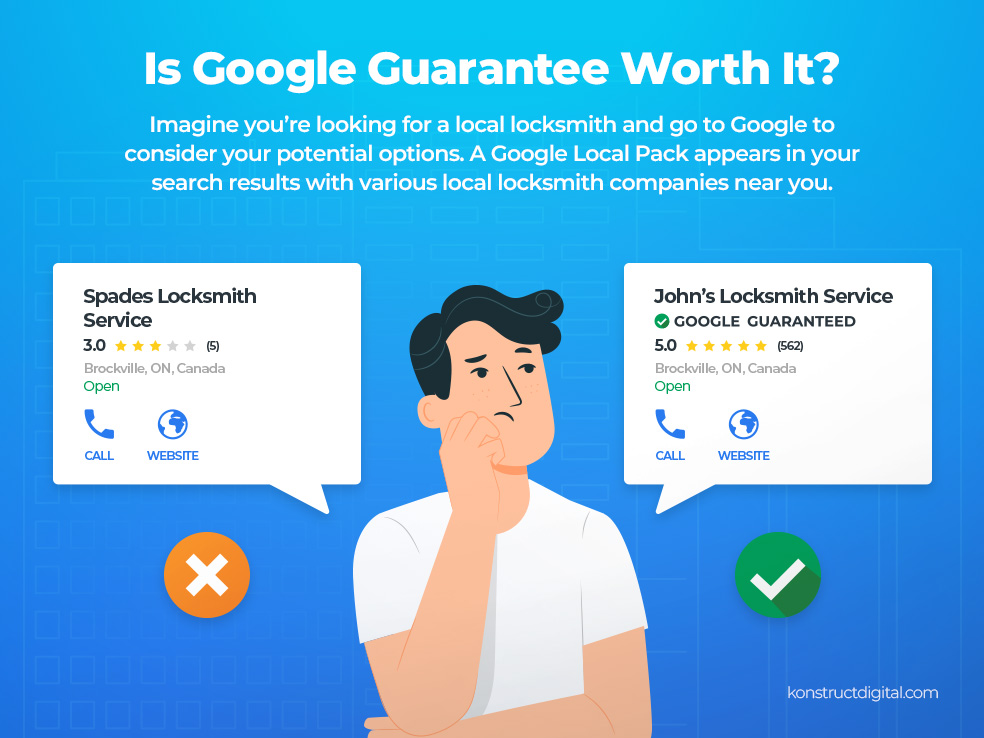
Imagine you’re looking for a local locksmith and go to Google to consider your potential options. A Google Local Pack appears in your search results with various local locksmith companies near you. You have no prior knowledge about the suggested companies but one of the companies has a Google Guaranteed badge. Which listing are you most likely to click on? The answer is obvious!
Though there is no public data regarding the impact of Google Guaranteed Badges on Click-Through Rates (CTR), a Google Guaranteed business will definitely stand out from its competitors. Keep reading to find out how…
How does a Google Guaranteed Badge Help Your Customer?
If your business has a Google Guaranteed badge and a customer is dissatisfied with your work, Google may reimburse your customer up to the amount paid for the initial service (subject to the lifetime limit of $2,000). Services must have been booked through a Local Services Ad to qualify for reimbursement.
The risk of wasting money is a common purchase barrier that could stop potential customers from diving in and booking a service with your business. Money is tight these days and people are being extra conservative and diligent when it comes to making purchasing decisions. Having a Google Guaranteed badge removes this purchase barrier because it gives the customer confidence that your business will either do the job right or they’ll get their money back.
What Happens When a Customer Submits a Request for Reimbursement?
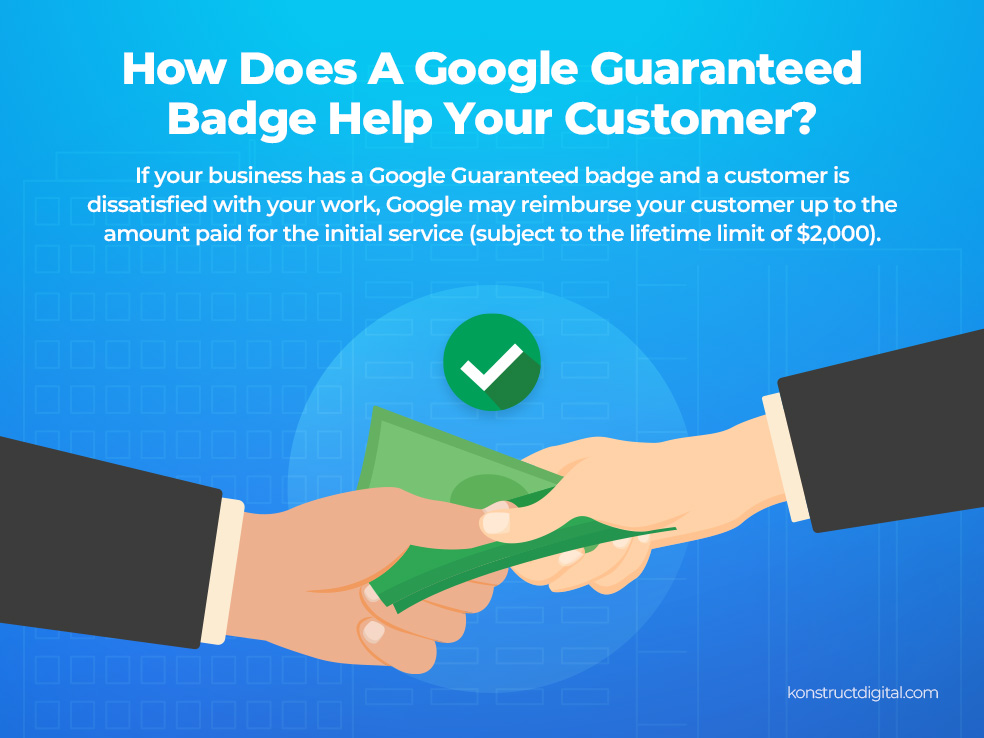
Before reimbursing your customer, Google will contact you directly to learn more about the situation and give you the opportunity to make things right with your customer on your own. The Google Guarantee just adds an extra layer of protection for your customers that will allow them to have confidence in their purchase decisions.
What is Not Included in Google Guaranteed Coverage?
The Google Gurarantee covers when customers are dissatisfied with the quality of work a Google Guaranteed business provides. However, Google does not provide reimbursement to dissatisfied customers who had booked a service from a Google listing without a Google Guaranteed Badge. If you don’t have a Google Guaranteed Badge and your competitors do, your services are a much riskier bet in the eyes of potential customers!
Google also does not provide reimbursement for services backed by a Google Guarantee in the following circumstances:
- The customer is unable to provide a receipt with the business name and amount paid for the initial service
- The customer experienced property damages as a result of the services
- Customer dissatisfaction with the price of the services or provider responsiveness
- The customer wishes to receive reimbursement for future projects that were pre-paid
- Cancellations of services
In these circumstances, your employees must provide the necessary customer support, even if your business is backed by a Google Guarantee.
How Will a Google Guaranteed Badge Help Your Business?

As a local business owner, investing in the upgraded GMB profile or receiving a Google Guaranteed Badge on Local Services Ads by signing up for a Local Service listing can have a number of benefits:
Increase Consumer Trust in Your Brand
People are becoming increasingly skeptical of advertising. However, they trust Google to steer them in the right direction. That’s why many people go to Google to find local businesses in the first place! When customers see that your listing has Google Guaranteed Badge, they will be reassured by the fact that your company is well-established and pre-vetted by Google’s thorough screening process. This will increase their confidence in your business and could increase the odds that they’ll click on your ad.
A Google Guaranteed Badge is also a great opportunity for new service listings to build trust. Previously, Google reviews have been a key component of boosting a brand’s reputation. People like to follow the leader. If other people had a good experience with a particular company, it seems less risky to pay for their services. However, newer businesses may not have many reviews to vouch for their trustworthiness. In this case, a Google Guaranteed badge could act as a shortcut to building this trust.
Stand Out from the Crowd
Having a Google My Business profile isn’t enough to get a leg up on your competitors these days. Why? Chances are most of your competitors already have one! So what does it take to lure a prospective customer over to your website when there is little opportunity to differentiate yourself in search? A little green checkmark could do the trick!
The Google Guaranteed Badge will show potential customers that your ad is worthy of their attention. When faced with two almost identical service listings, it may be difficult for a customer to decide between the two. When faced with the option between Google Guarantee listings and listings with no money-back guarantee, the choice suddenly becomes obvious!
(Potentially) Improve Your Google Search Ranking
While it’s yet to be confirmed how a Google Guarantee Badge could affect your search ranking, it’s certainly plausible that Google could offer a Google Guarantee ranking boost. As Google’s algorithm seems to be everchanging, it doesn’t hurt to get a step ahead in case this does emerge as a ranking factor. Google also has a financial incentive to rank these listings higher due to the paid Google My Business upgrade. Google may look to incentivize more businesses to upgrade their GMB profiles by boosting the ranking of those who have already paid for the upgraded profile with the Google Guaranteed Badge.
A Google Guaranteed Badge could also improve your search rankings if you receive an influx of customers that leave positive reviews for your business. The Google Guarantee may lure customers to click on your listing and book a service. It is then your job to provide them with excellent service so they will leave positive Google reviews. This could result in Google improving your search ranking because Google wants to connect its users with the best services or resources available.
(Potentially) Receive a Large Return on Investment
It’s fair to say that Google dominates the other search engines, especially for local search. This means that having a strong Google presence for your business is increasingly important. If you don’t, you’ll just be consistently losing out to your competitors that do. An upgraded Google My Business profile with a little green checkmark for $50 may seem like a hefty investment. However, consider the huge number of prospective customers searching for a business in your industry on Google with little knowledge about you or your competitors. That little green checkmark (the Google Guaranteed Badge) could be the sign they’re looking for.
Avoid Losing Customers to Competitors
Not having a Google Guaranteed Badge while your competitors do could also be costly for your business. You may miss out on customers that would have otherwise gone to you for your services.
It’s likely that as more businesses invest in the upgraded GMB profile, the cost of losing out on customers will make the upgraded GMB profile the norm. In order to really benefit from this investment, you’ll need to invest before your competitors catch on!
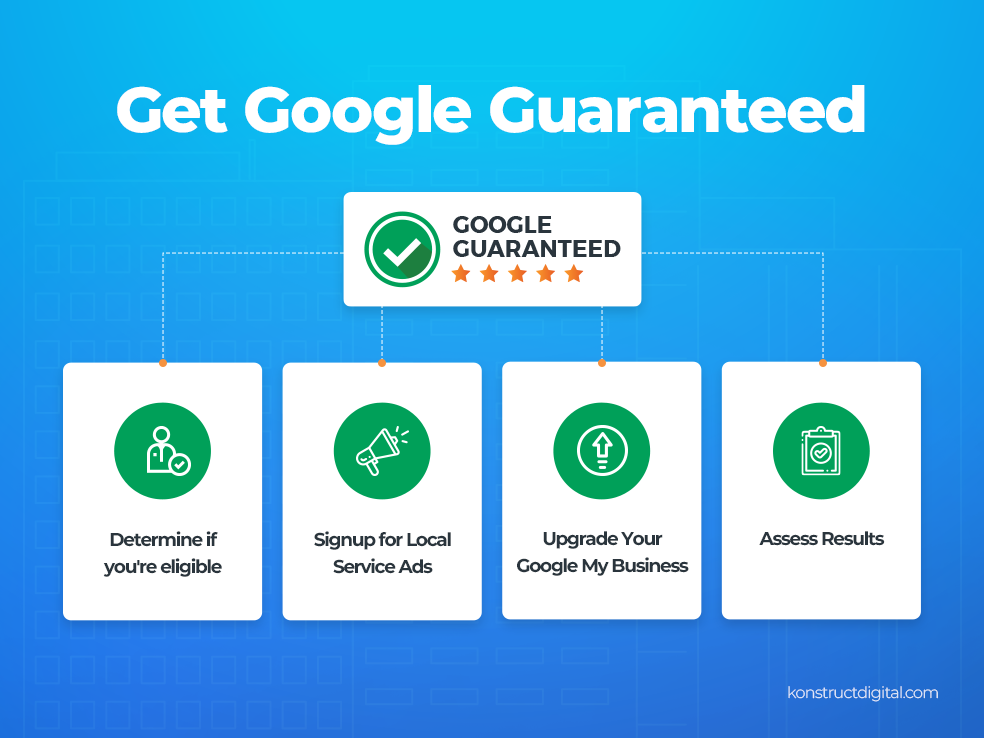
Konstruct Digital is a Google Certified Partner
Now that you know that an upgraded GMB profile and a Google Guaranteed Badge can be a major win for your business, how do you actually get the ball rolling? Or maybe you’re not eligible for the Google Guarantee program but are interested in leveling up your Google presence. That’s where we come in!
At Konstruct, we have a team of Google experts that can help with everything from growing ad revenue to setting up an effective GMB profile. Contact us today to get started!
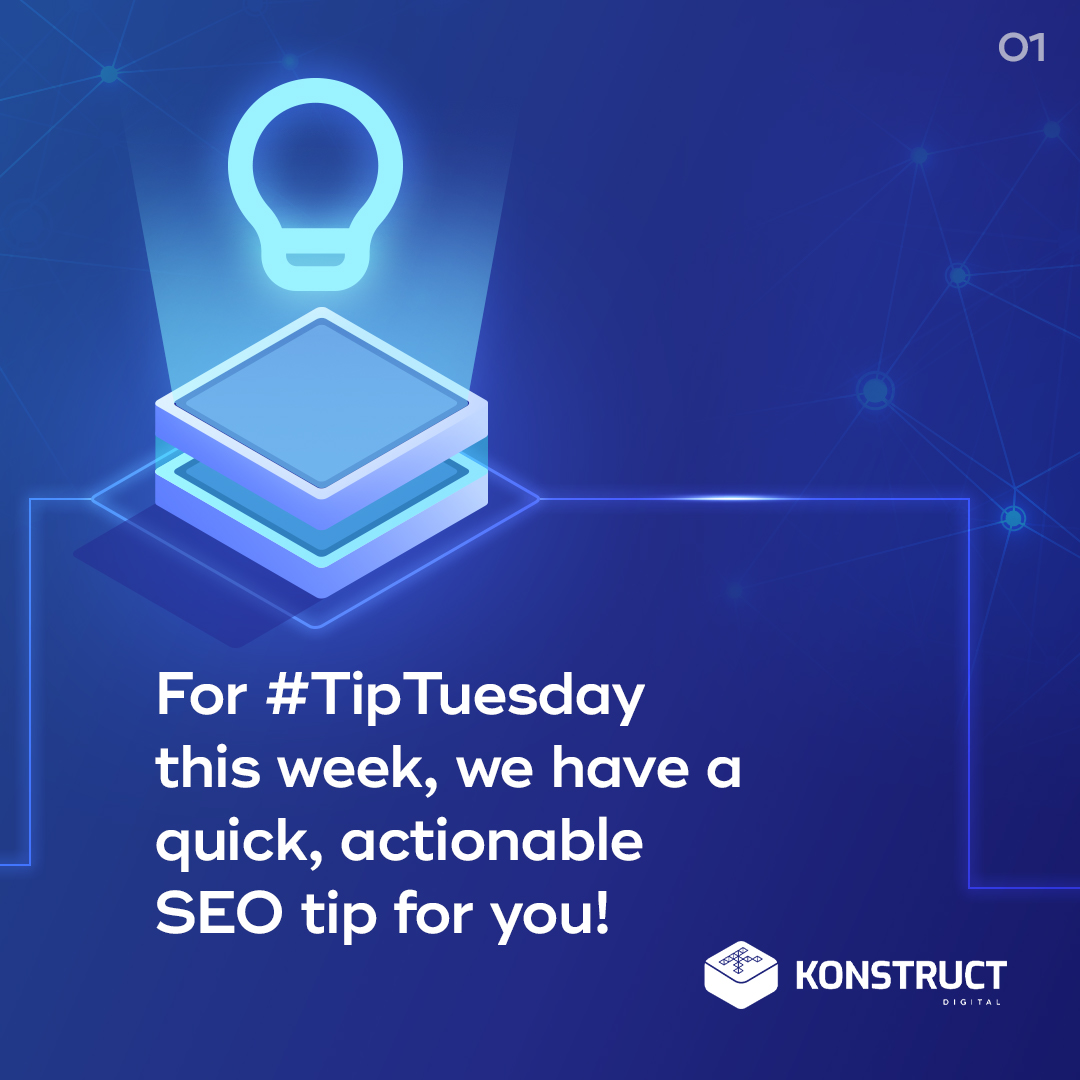
For #TipTuesday this week, we have a quick, actionable SEO tip for you! 👏
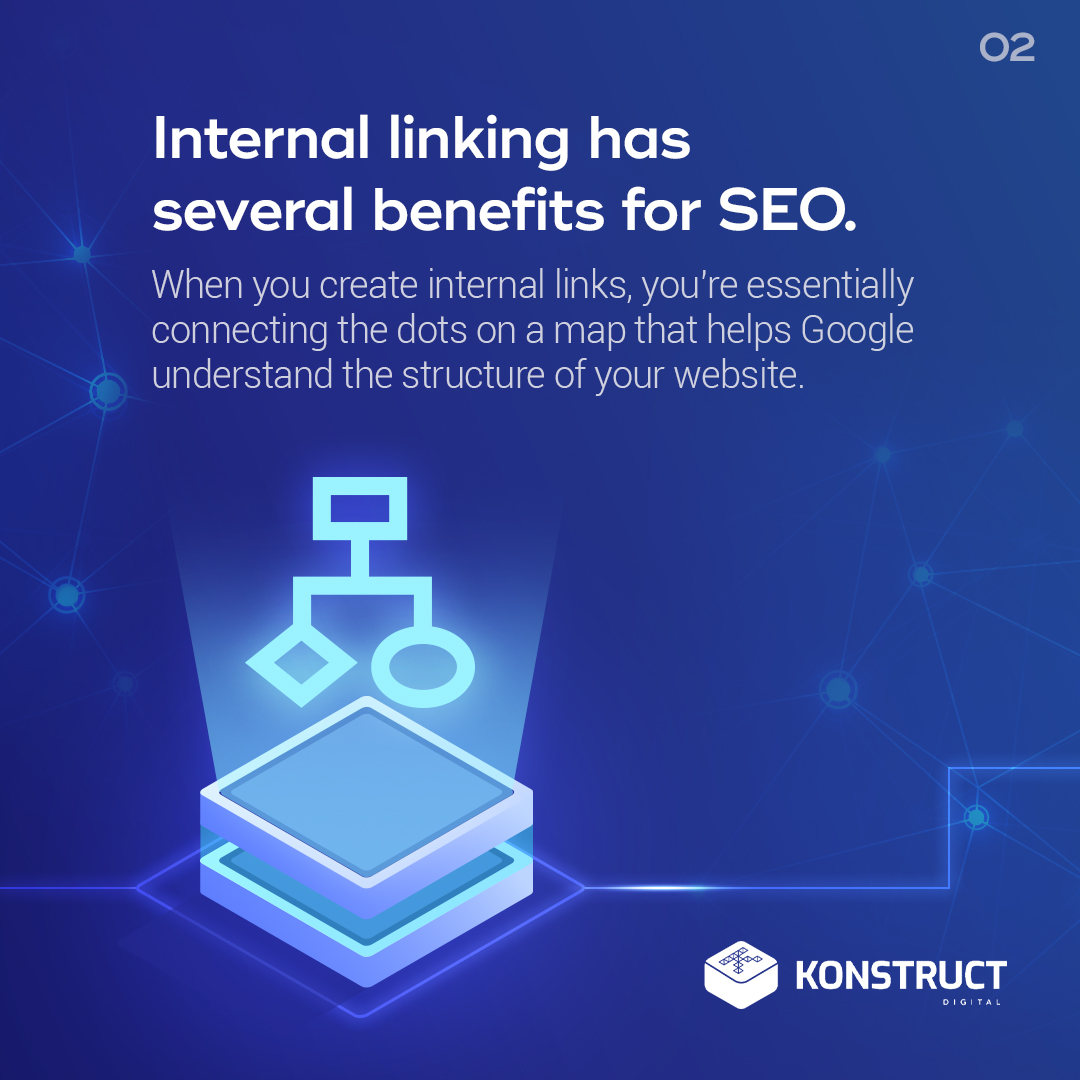
Internal linking has several benefits for SEO. When you create internal links, you’re essentially connecting the dots on a map 📍 that helps Google understand the structure of your website.
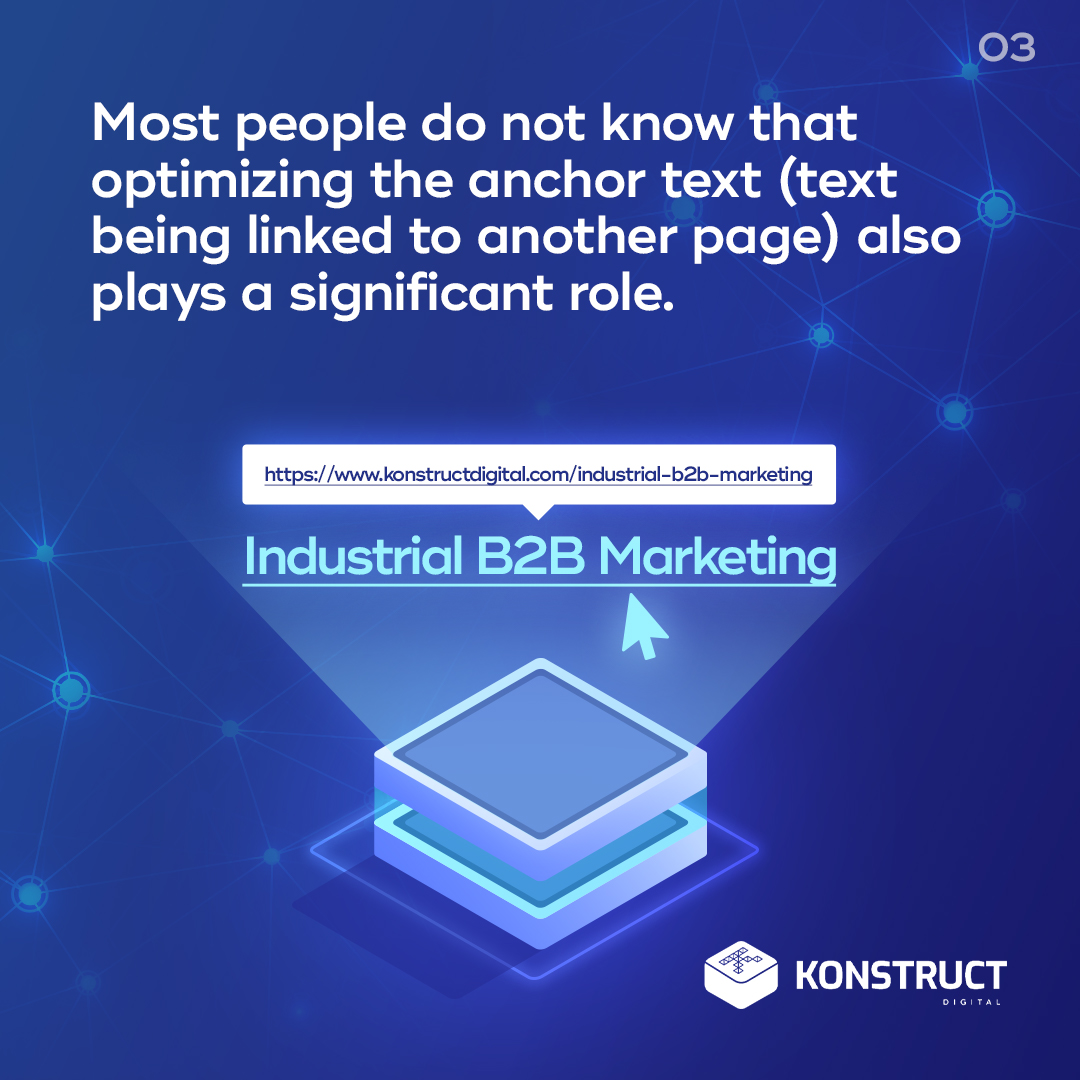
This is pretty basic knowledge when it comes to SEO. However, what most people do not know is that optimizing the anchor text being linked 🔗 also plays a significant role.
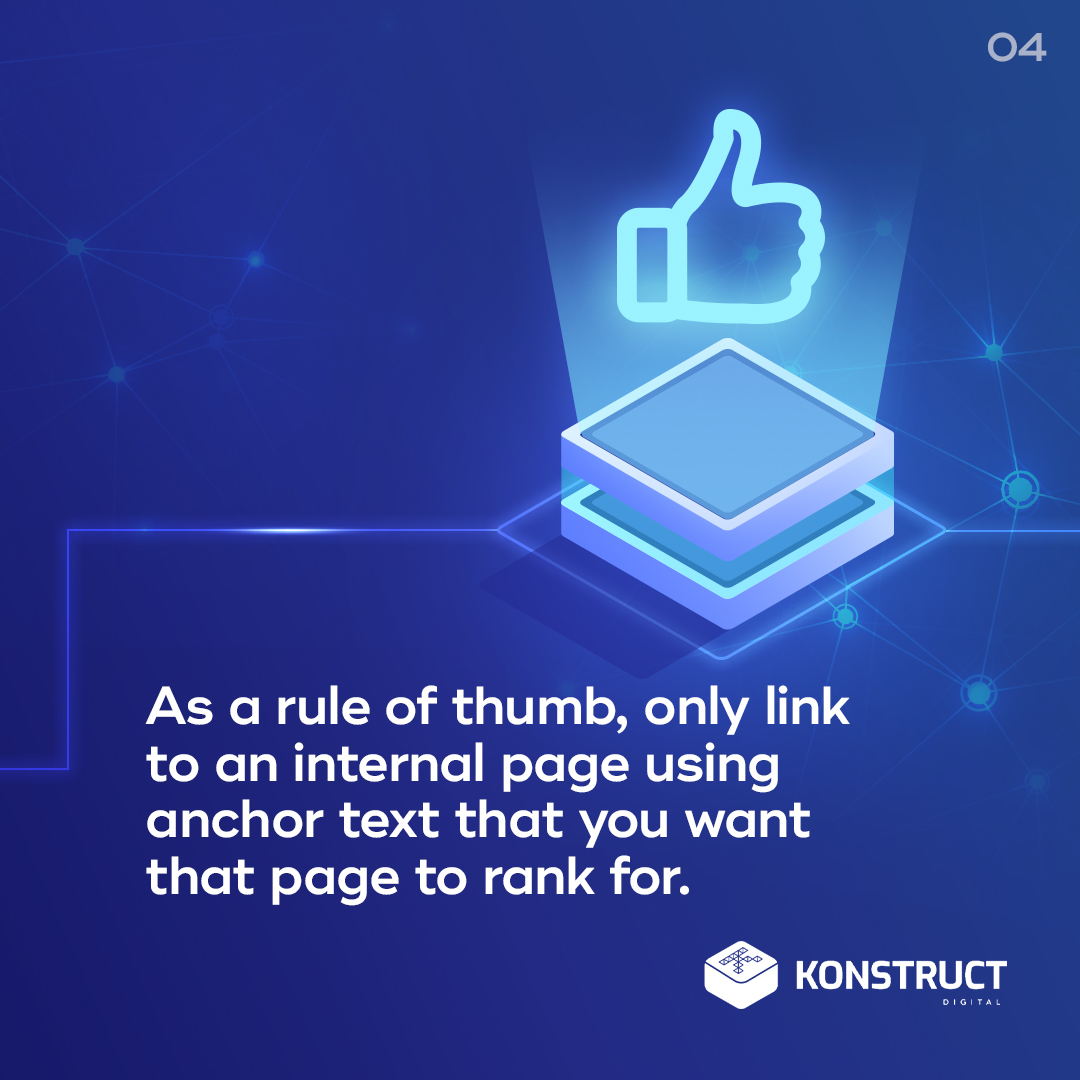
As a rule of thumb, 👍 only link to internal pages with the terms you want your content to rank for. 🥇 The anchor text in your internal link can be even more important than the content on that page!
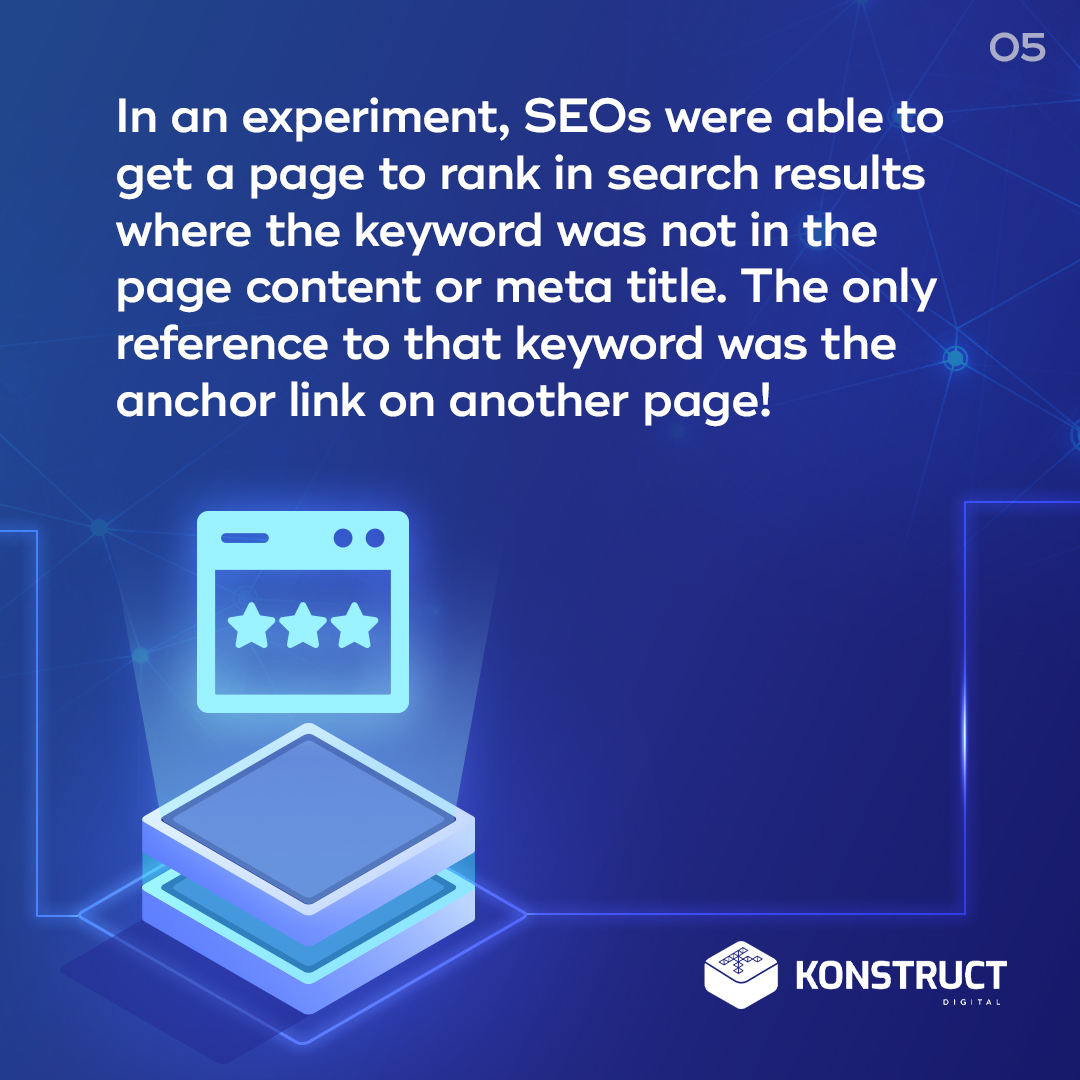
In an experiment, SEOs were able to get a page to rank in search results 🔍 where the keyword was not in the page content or meta title. The only reference to that keyword was the anchor link on another page! 😱 WHOA!
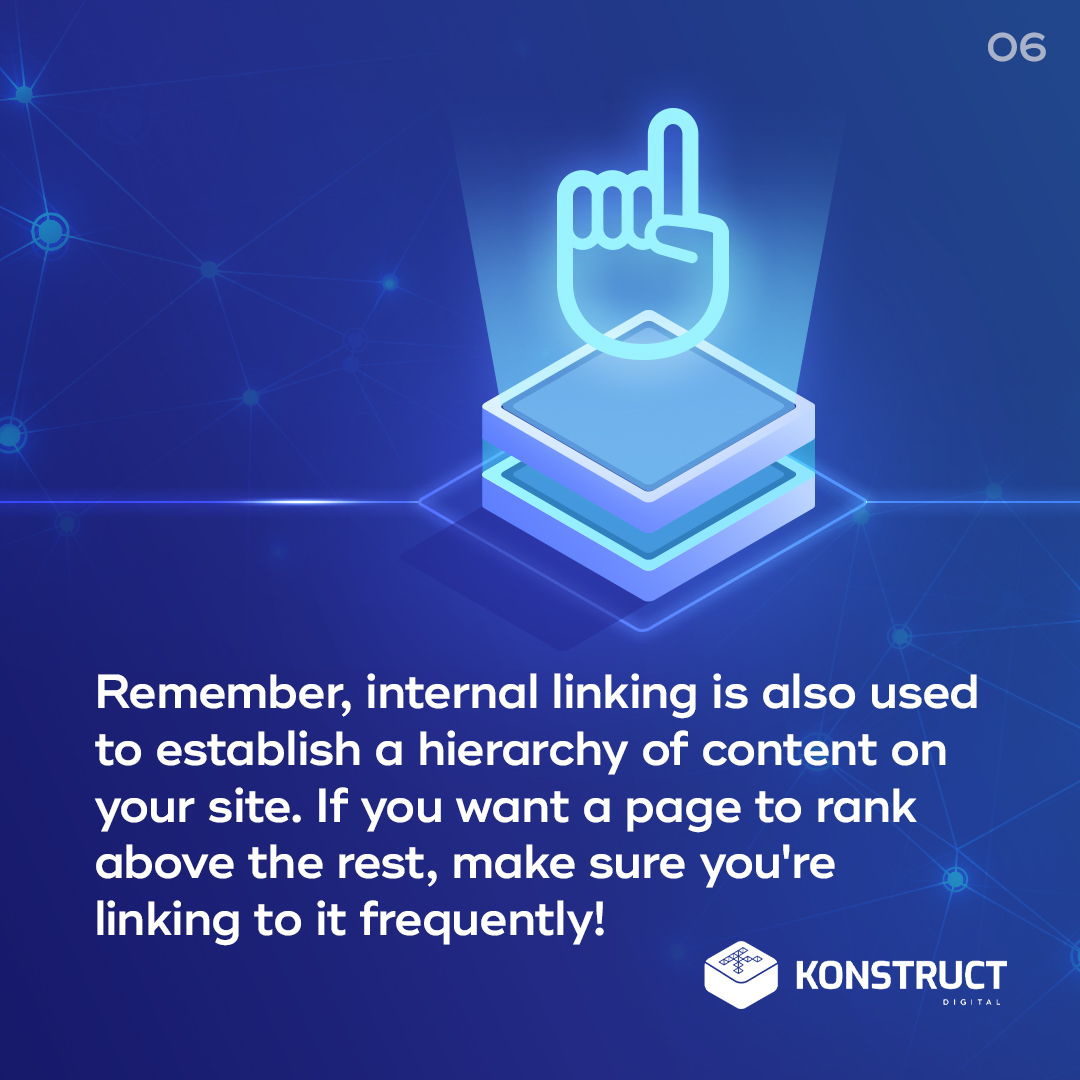
Remember, internal linking is also used to establish a hierarchy 🏆 of content on your site. If you want a page to rank above the rest in search results for a certain topic, make sure you’re linking to it frequently!
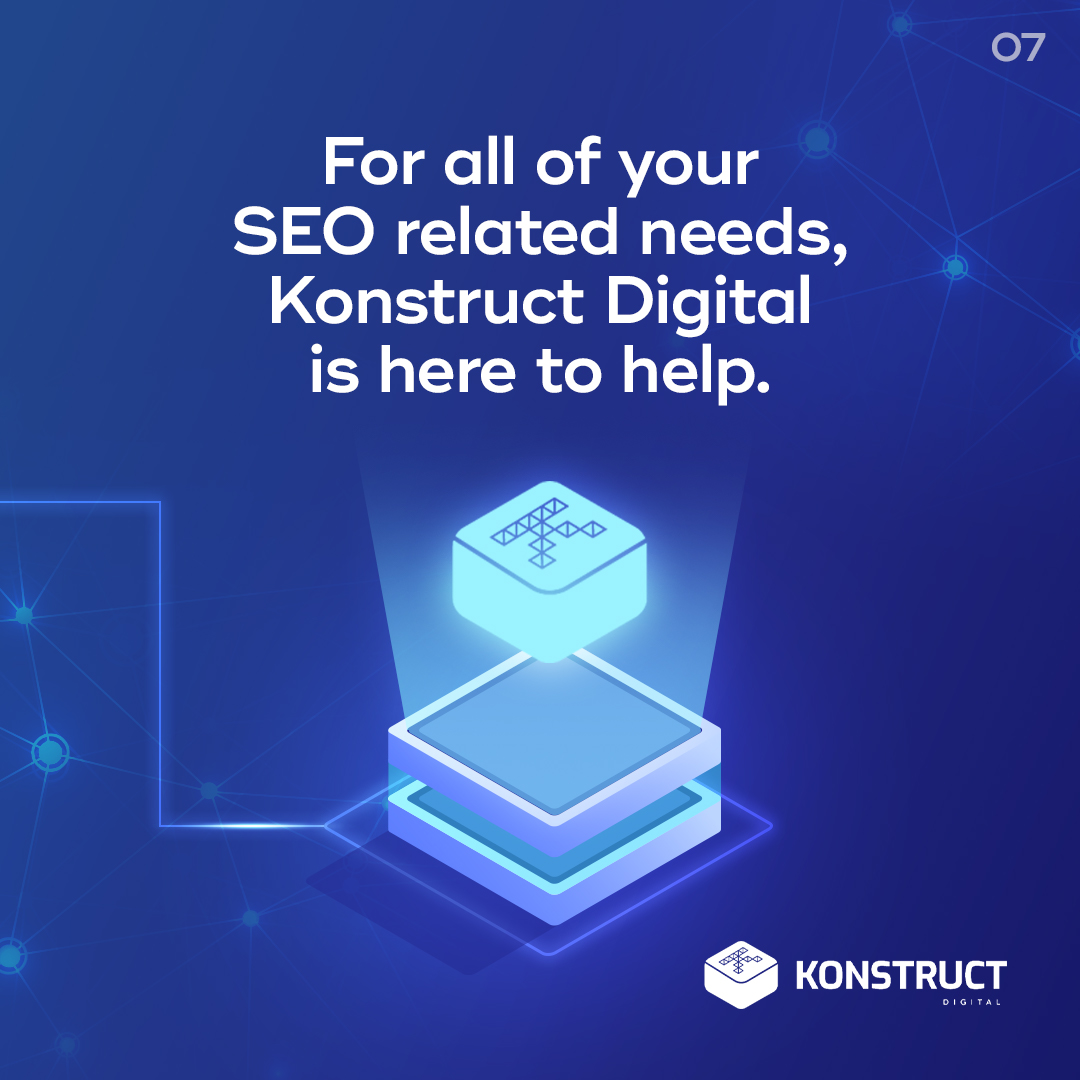
For all of your SEO related needs, Konstruct Digital is here to help. 👏

#KonstructDigital #GrowYourBusiness #InternalLinking #SEO #AnchorText
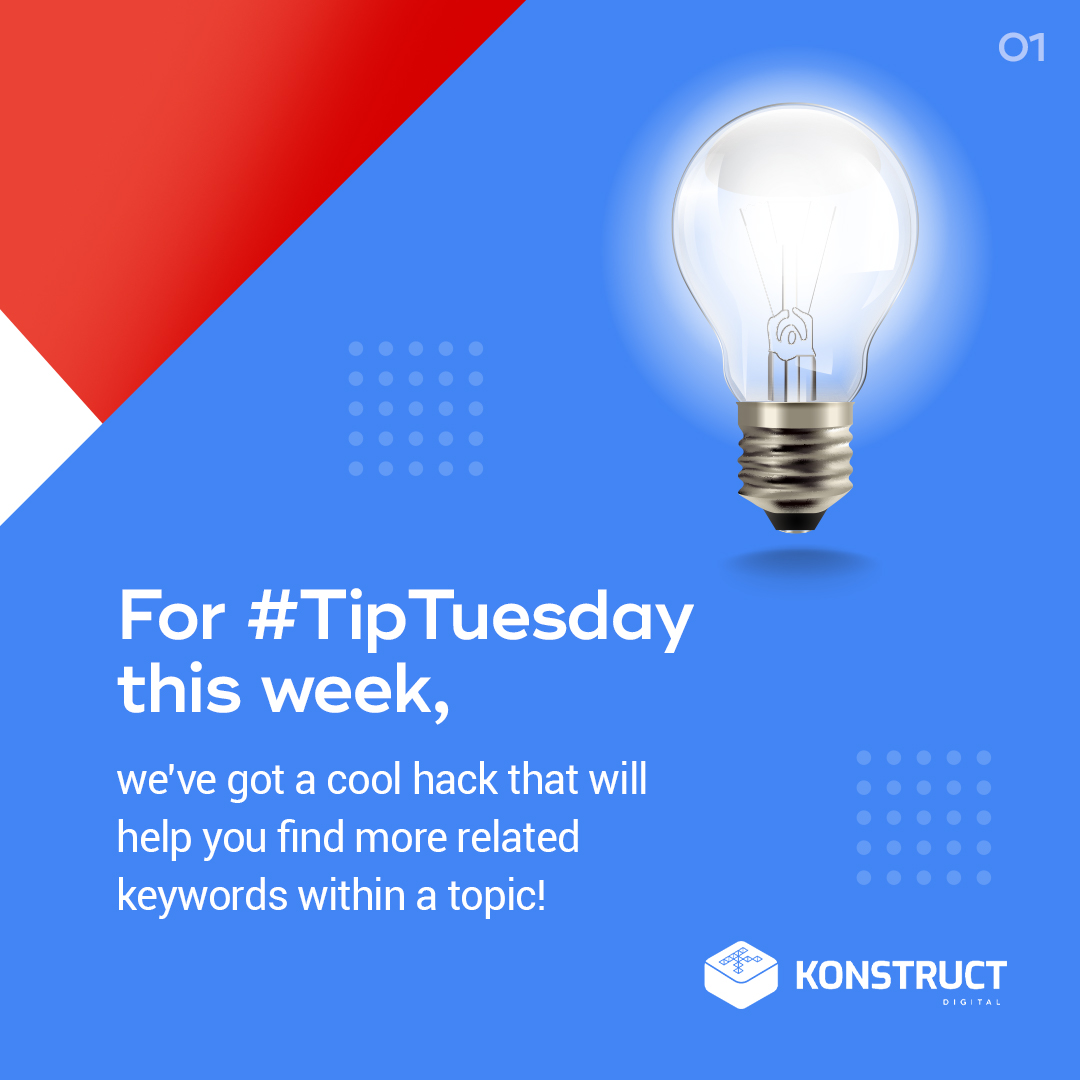
Having a hard time figuring out what related keywords you should be targeting with webpage content? 🤔 For #TipTuesday this week, we’ve got a cool hack that will help you find more related keywords within a topic!
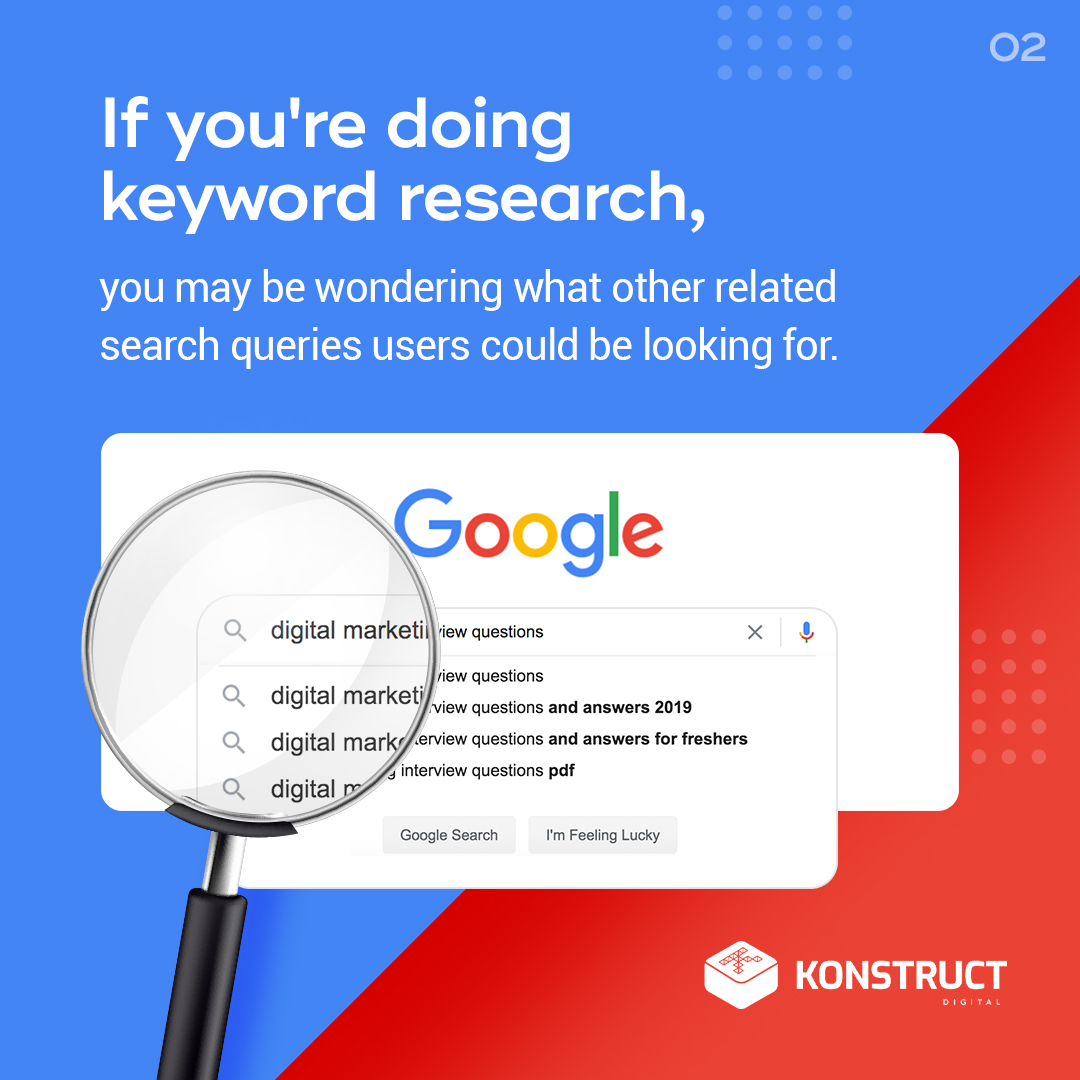
If you’re doing keyword research, 🔎 you may be wondering what other related search queries users could be looking for. Google Keyword Planner is a good place to start, but it sometimes doesn’t reveal the whole picture.

By using an asterisk *️⃣ in a search query, we can stretch keywords and find out what other similar queries exist around the subject matter we’re searching for.
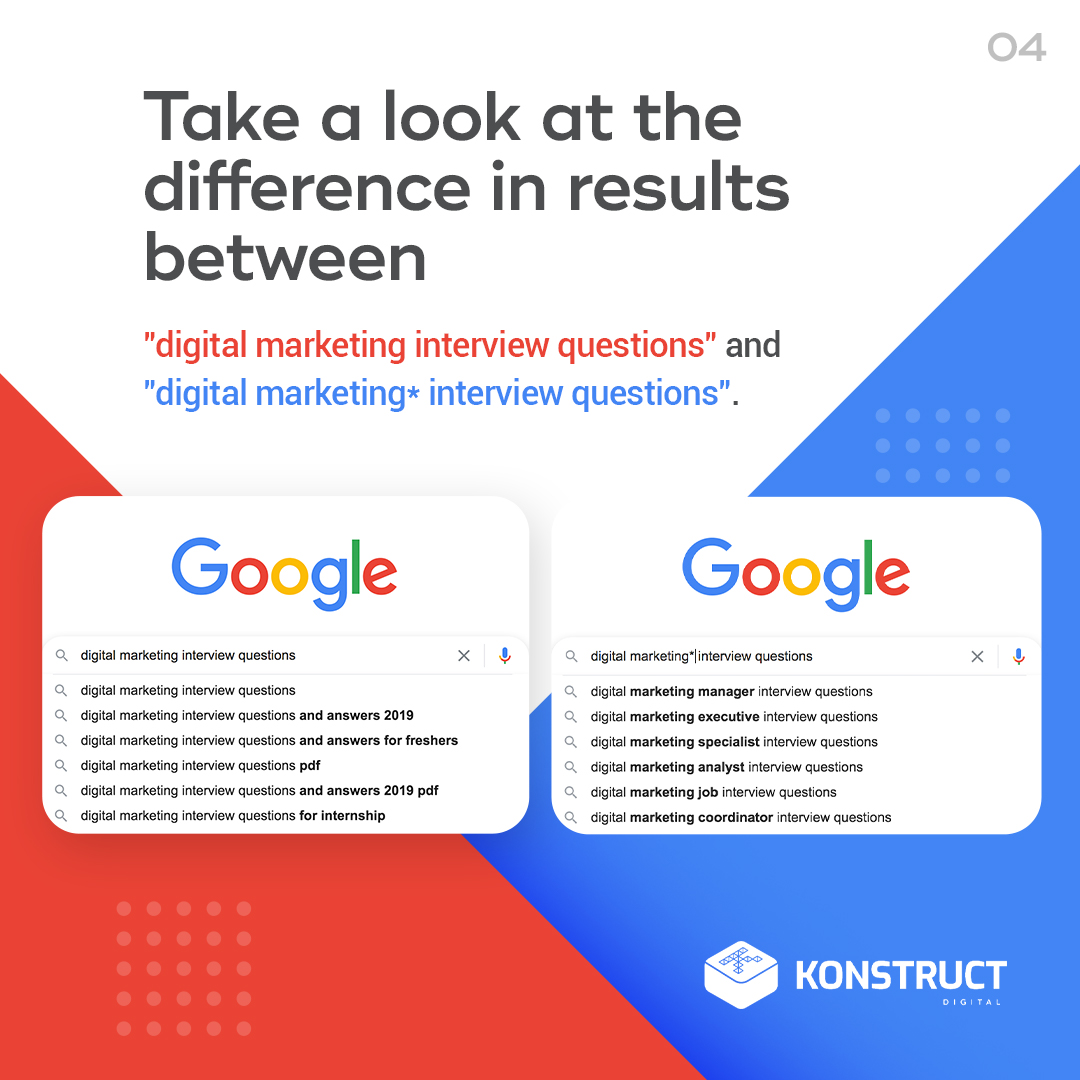
For example, instead of searching “digital marketing interview questions” and looking at the results, try searching “digital marketing* interview questions” and take a look 👀 at the results!
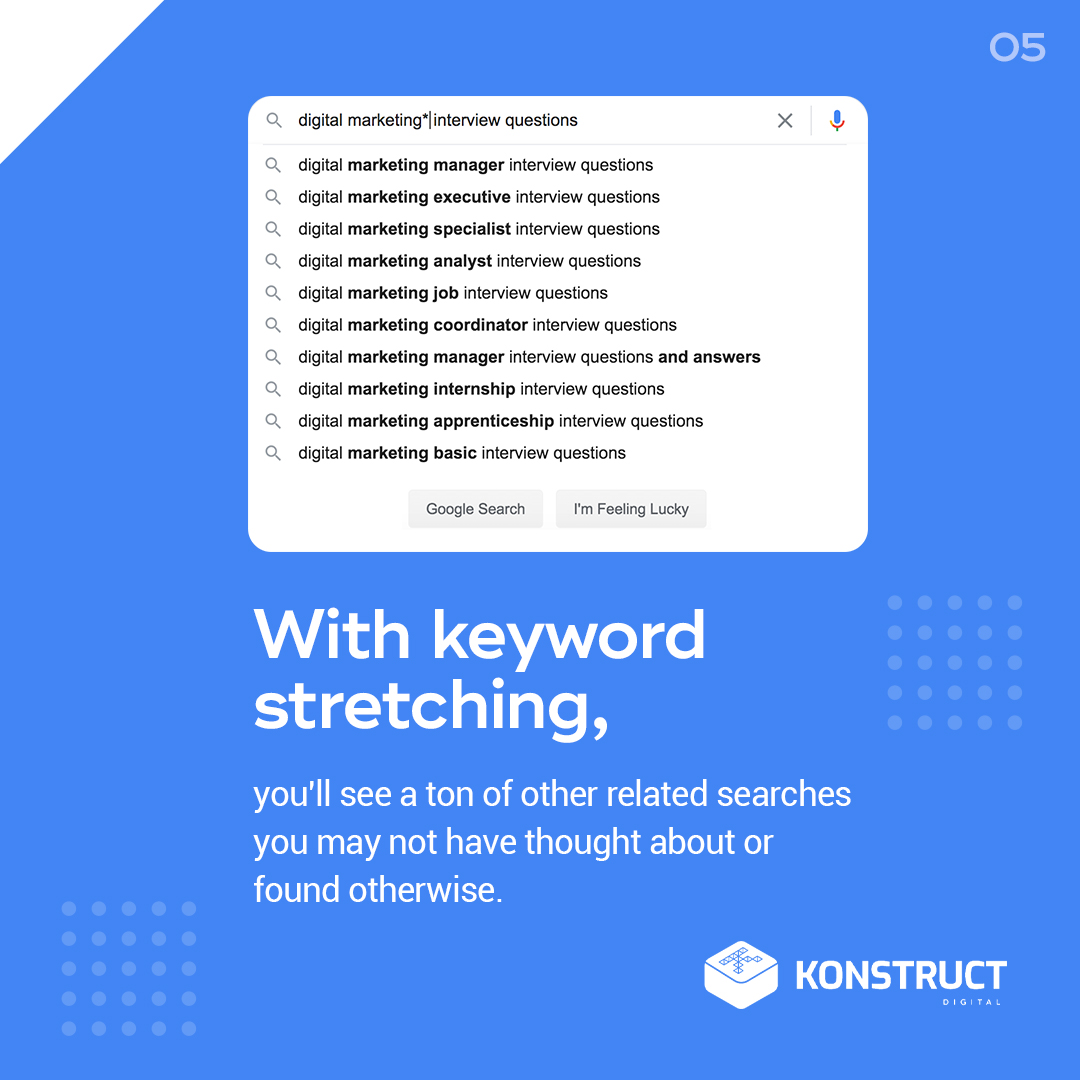
With keyword stretching, you’ll see a ton of other related searches you may not have thought about or found otherwise. 🙌
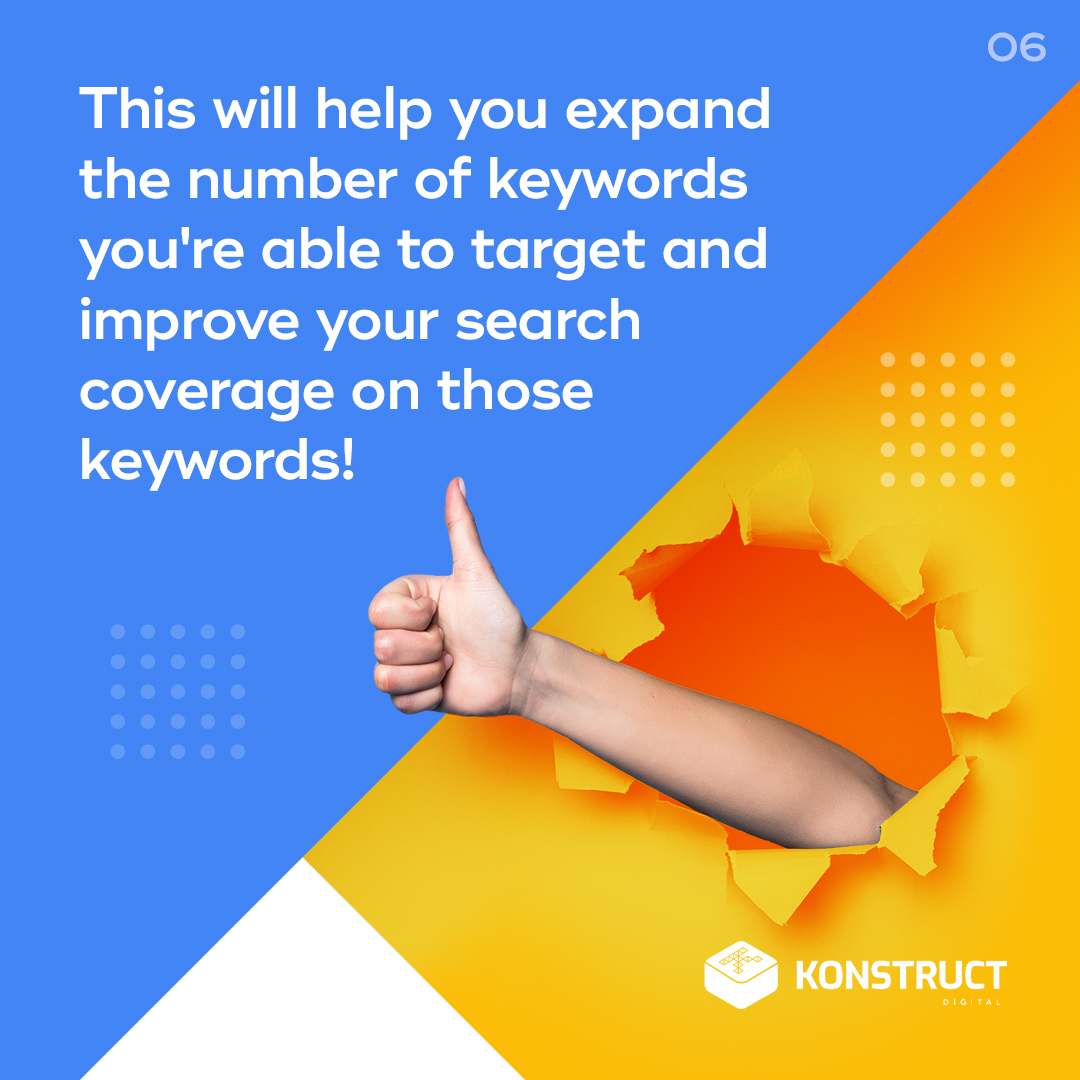
This will help you expand ↔️ the number of keywords you can target with website content and improve your search coverage on those keywords.
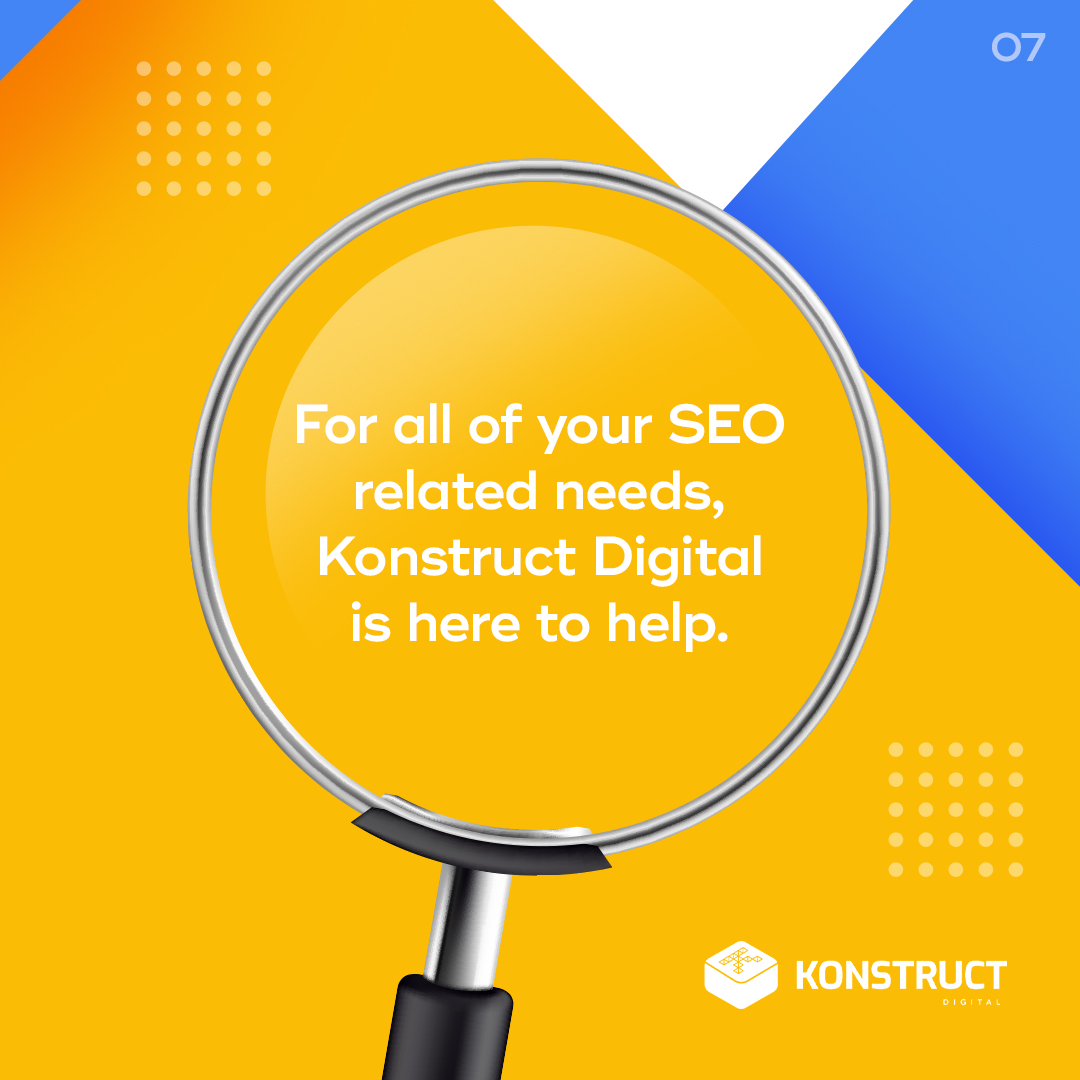
For all of your SEO related needs, Konstruct Digital is here to help.
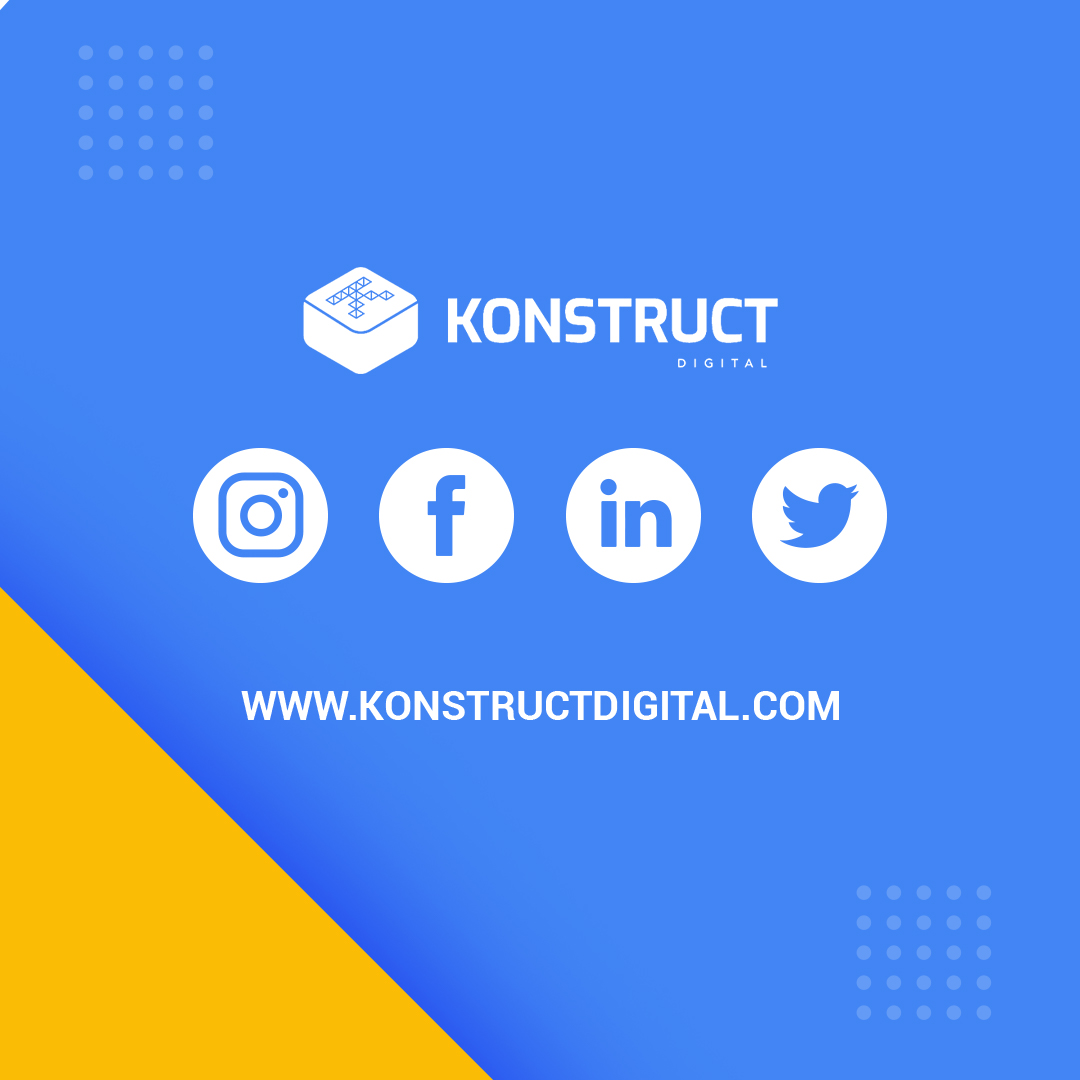
#KonstructDigital #GrowYourBusiness #SEO #KeywordResearch
With all the Tiger King 🐯 stuff buzzing around, we thought we’d give you an example of how Joe Exotic used an illicit SEO campaign to get in his competitor’s search results.
If you’ve watched the show, you’ll know that Joe Exotic did not like Carole Baskin. Baskin’s company, Big Cat Rescue 🐅 advocated for tigers and sought to shut down businesses like Joe Exotic’s.
Joe Exotic figured out that because of Google’s search 🔎 algorithms, if he named his business similar to “Big Cat Rescue” he could appear in the search results for that business.
As such, Joe renamed his business to “Big Cat Rescue Entertainment”. 👏 By doing this, his business actually appeared above Baskin’s in search results.
However, the gains were short lived. In 2012, Baskin sued Exotic over copyright violations, resulting in a nearly $1 million settlement in Baskin’s favour. 😮
Keep in mind, Google isn’t stupid! They will penalize manipulative actions like this and cripple a website’s organic visibility or possibly even de-list it 🚫 in search results. We see this happen with local listings spammers regularly.
Remember, don’t be like Joe Exotic, black hat tactics and illicit SEO strategies are never the way to go. There are plenty of opportunities to outrank your competitors and expand search coverage without breaking the rules. 👍
#KonstructDigital #GrowYourBuisiness #SEO #TigerKing
#JoeExotic #CaroleBaskin
There’s no question that COVID-19 / coronavirus is rocking the economies of the world.
There’s no playbook on how to feel. There’s no playbook on what actions your business should take.
We’re in uncharted territory.
A challenge like this has never occured in the modern business world.
Consumer Behaviour Has Rapidly Become Unpredictable
As people came to grips over the last few weeks of how monumental and temporarily life changing COVID-19 will be, the collective behaviours shifted.
Consumption of news has shot through the roof. People have been stocking their pantries and buying wild amounts of toilet paper. They’re worried about when stores are closing, how to get food delivered. People are distracted. This is temporary. Breathe in, breathe out.

The last few weeks of consumer behavior are not indicative of the future. At some point, the spread of Covid-19 news will normalize. People’s routines will normalize.
When this happens, we won’t only see a resurgence in demand, but also an influx of deferred demand. It’s important to consider where you’ll be positioned in the market when this happens. It could make or break your business over the next several years.
Making smart marketing choices now is more important than ever.
Demand Isn’t disappearing – It’s Deferring
Is there probably going to be a global recession this year? Yes.
Is demand for your product/service going to be zero? Probably not. It might be less than it has been in previous years, but once consumers adjust to their “new normal”, there’s going to be a surge of “deferred demand”.
For some industries, demand is going to explode. For others, it will be about capturing what you can.
What’s deferred demand?
Deferred demand is the concept that demand still exists in the market, but currently people are choosing to either use up their stockpiles or go without due to extraneous triggers.
Once the pressure of the triggers lessen, consumers will not only go back to their previous buying habits, but potentially even purchase more than normal to build up their stockpiles again, or get the enjoyment of the thing they’ve missed so much.
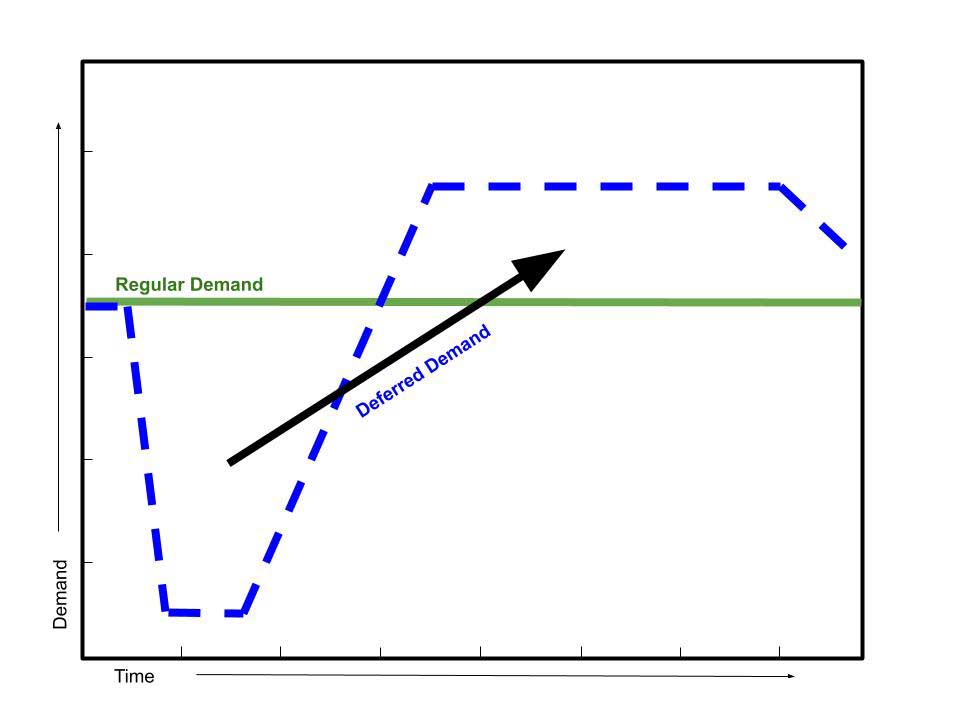
If you take your “foot off the gas” (as it pertains to marketing) entirely during the deferral period, your business likely won’t be set up to take advantage of the deferred demand period. It’s difficult to predict precisely when that will occur. You have to be ready at any moment or risk being late to the game.
What does this mean for your business? If you’re not set up to take advantage of the deferral, be prepared to kiss all that lost demand good-bye. It will hurt the long-term prospects of your company and make recovery that much more difficult after this initial adjustment period is over.
I’ve worked with dozens of companies through two recessions now. The Great Recession after the financial crisis, and oil price recession in Alberta.
I’ve seen companies handle uncertainty in a lot of different ways and here are my observations:
- The companies who cut back the majority of their marketing take longer to recover (if they recover)
- The companies that invest in long-term marketing assets like SEO and their customer database saw faster recovery.
- The companies that doubled-down on their marketing efforts were able to leap frog their competition who cut back and emerge as a new market leader.
Big plays are going to be made over the next year. Businesses have a choice on whether they want to watch from the sidelines or get a piece of the action.
I get it. There are tough choices to be made. You might be choosing between your marketing budget and a staff member. Your staff are like family.
But it’s time for tough talk: you’re not doing anyone any favours (even your staff) if you don’t position your business for recovery. The better you’re positioned for recovery, the sooner you can hire them back with viable long-term employment.
What are businesses doing next?
As the economy temporarily halts, businesses are right to assess their expenditures and make smart financial choices.
If you do need to make choices with your digital marketing, this is the order I would assess from first to last if you have to make cuts.
[Please take the below list with a sweeping grain of salt. My recommendations are highly generalized. The choices here are going to be different for every industry and the different degrees in which they’re directly (or indirectly) impacted by COVID-19. If you’d like a consultation, please contact us to discuss.]
- Display Ads & Paid Social: if your ads are positioned around direct response or getting a consumer to do something right now, you’ll want to give this a hard look.
- Paid Search: for the same reason as #1. Depending on your niche, consumers may not be taking action right now.
- Social Media: while I don’t recommend cutting entirely, you may want to temporarily cut down your frequency depending on your business situation. Double check that your posts aren’t tone-deaf to the current situation.
- Content Marketing: a slow period is a good opportunity to reassess your content marketing strategy. Make sure your messaging isn’t tone-deaf at this time.
- Email: your email database is always going to be one of the most valuable assets you have. Depending on your niche you may want to increase or decrease frequency right now.
- SEO: SEO has, and always will be, a long term strategy. With it you’re always looking on the 3-12 month horizon, so don’t stress about what’s happening this month. Your SEO will be the #1 thing that will help you when deferred demand starts to grow. Knee-jerk reactions to cut SEO in the short term push out your lead time and may impede your ability to recover. Take advantage of market opportunities and competitors that might scale back their efforts here over the next few months and use it as an opportunity to leap-frog them.
An example: if you run a bar or restaurant that’s now closed, you’ll obviously want to stop paid ads that encourage direct visitors. On the other hand, if you’ve pivoted in to offering take out or other services through your website, you’ll want to adapt your ad strategy to advertise that instead. If you’re closed, you’ll want to save that budget. Use the time and budget to think about your re-launch ramp-up strategy.
New Digital Marketing Opportunities
Before you even consider slashing or adjusting your digital marketing budgets, you should know that the current crisis also provides very unique digital marketing opportunities. Depending on your unique situation, there might be ways to get a better bang for your buck if you reallocate some of your digital marketing budget. If you can afford to maintain your digital marketing budget, double down now.
With many businesses struggling or cutting their digital marketing budgets, there’s less competition and therefore opportunities for quicker results at a lower cost. At the same time, new challenges mean that consumers are looking for new (or new to them) solutions, for example, how do I arrange a virtual birthday party for my friend? What are some crafts I can do with my kids at home? How do I make a sourdough starter?
- Lower Cost for Digital Ads: Case in point, we’re starting to see some evidence that as digital marketers pull back budgets, CPMs and CPCs are going DOWN on platforms like Google Ads and Facebook. If your industry remains open, now would be a great time to see how far you can push your ROAS (return on ad spend).
- New Target Audiences: The crisis means a huge shift in behaviour and potentially changing consumer motivation. It might be a great time to revisit who your target audience is. Have new audiences popped up as a result of the crisis? Are your existing target audiences still driven by the same motivators? A poignant example would be home tutoring services – there are probably a few additional groups of consumers that can be added to your list of target audiences after schools closed and many parents were thrust into the role of home educators.
- Email Campaigns. This is a cheap and effective way to remind customers how they can access your products. To cut through the noise, your campaign should be clearly linked to providing value for your customers and tie into your digital buying options.
With many of your employees at home and not tied up with other obligations, it could also be a great time to develop some valuable pieces of content or make updates to existing content that you’ve been thinking about for years. Maybe your website content needs to be updated? Maybe you can write a series of blog posts that you can use now or later? There are many ways to focus on content marketing these days.
Remember to re-assess all of your marketing efforts regularly, including your marketing copy and collateral. You’ll need to do a COVID-19 sanity check. This won’t be a one-time exercise, but a constant process of reassessing whether your digital marketing strategy and collateral make sense in a rapidly changing situation.
COVID-19 Digital Marketing Communication
For businesses, it’s a matter of mastering the fine balance between “business as usual” communication and leaning too heavily on the current crisis. If a business tries to carry on with their communication and ad campaign collateral unchanged, they run the risk of coming across as tone-deaf and alienating their customer base because they’ll appear like they don’t understand how much the pandemic has affected them. On the other hand, businesses will not want to look like they’re trying to exploit the crisis either.
From the actual copy to images and discount codes, think about how the message holds up after COVID-19. Perhaps an image with people hugging or shaking hands doesn’t make any sense right now. Discount codes with #covid19 will be perceived as tacky and exploitative. The key to the balance is empathy and understanding of what your audience needs and wants right now.
Finally, it’s crucial that you demonstrate your commitment to keeping your employees and customers safe. What are the safety and sanitation measures that your business has implemented? Show that you’re a responsible business that’s worth supporting and inspire confidence that customers can safely continue to use your services.
The mantra should be: stay safe, be empathic, and think about what value your business can offer. That way, you’ll be able to keep your marketing on-point and not offend your clientele.
My Predictions
Now the interesting part: how will demand shift as consumers settle into a “new-normal” of life involving social-distancing and isolation?
As more people stay home, I predict:
- Information consumption will skyrocket. Blogs, articles, videos, will be consumed at impression levels never seen before.
- How-to content will win. From home renos, to cooking, everyone will be spending more time learning to become self sufficient.
- Ecommerce will explode. More than before. Rather than ecommerce being a bolt on to an existing business model, more organizations will undergo a transformational shift to be e-commerce first. Delivery and logistics will play a key part in this.
The thing about the current crisis is that these effects won’t just be short-term. New habits that are formed while staying at home will die hard. In many ways, physical distancing will open people’s eyes to the benefits of ecommerce. For example, ordering groceries online is a practical and convenient alternative to spending time in the grocery store and the demand for online shopping across all sectors will probably persist long after COVID-19 is just a distant memory. That’s why it’s so important to set your business up for success in the ecommerce realm.
My Advice for Different Industries and Business Types
[Disclaimer: my advice, recommendations, and predictions are not right for every business. Please discuss with a trusted digital marketing partner.]
Affiliates & Bloggers
These last couple weeks have probably sucked. Impressions have dropped. And worse, if you rely heavily on Amazon, as they’ve shifted to focusing on essentials, your commissions might be down substantially.
My advice to affiliates and bloggers in the midst of Covid-19 is to stay the course with a few adjustments. Within a few weeks people’s lives will return to a new-state-of-normal. Traditional search behaviour will resume with booms in key niches. How-to and self-sufficiency content will likely explode with traffic.
Take the current week to assess your affiliate programs. Diversify where you can, look for alternatives to Amazon with a solid supply chain. Double down on your SEO efforts to solidify your market positioning. If you’re in the right niches, there is a tsunami of traffic headed your way.
If you can’t find a suitable affiliate program alternative – shift your temporary focus to acquisition. Be ready to capture that email list and those social followers. Once your affiliate programs come back (and they will), you’ll have a larger subscriber base to leverage.
Service Businesses
Depending on what type of service business you have, you’re likely facing different challenges. Here’s my best attempt at breaking it down.
Medical Services:
Customers will be nervous about visiting you. I’d recommend the following:
- Investigate where you can offer phone or video consultations.
- Patients WILL be concerned about visiting your location. Describe in-depth your COVID-19 policies (how you clean, how often, how you’re protecting your staff and patients, what your sick policies are, etc) and over-communicate this to your clientele. Post it on your door, in your waiting room, on your website, on your confirmation emails, on your phone system – EVERYWHERE. The more you can make this clear, the more your clientele will feel you are taking this seriously and it will inspire confidence.
Depending on your service line, you will likely see a decrease in customers while people are practicing social isolation and distancing. Focus on retaining existing customers, consider lowering paid media spend, and invest in SEO to better poise your practice for recovery.
If you’re able to offer phone/video consultations, a short-term PPC strategy could be highly effective.
Professional Services:
The businesses you work with are likely distracted. Unless you offer business pandemic planning consulting as a primary business line, it’s likely you’ve seen your leads drop over the past few weeks.
Businesses are grappling with moving their teams to 100% remote and trying to forecast the economic impacts.
I would anticipate seeing this sector contract for the next 1-3 months as businesses work on stabilizing. After this, depending on your offering and what industries you work with, growth will start coming back.
Pull back on paid media spend temporarily. Work on your marketing assets and content strategy. Position yourself with SEO to take advantage of the growth 3-12 months down the line.
Other Services:
If you offer any non-essential services that depend on your customers coming to you (think: entertainment centres, bars, restaurants, etc), you’ve likely had an enormous business shock over the last few weeks.
For some businesses, the best you can hope for is weathering the temporary shut down.
If you can afford it, I’d recommend keeping your SEO going to ensure you’re well positioned come recovery time. There’s likely to be some BIG movements in your SERPs depending on who is able to continue to invest in SEO and who isn’t.
If you have a restaurant or cafe and have pivoted to take-out/delivery, kudos to you on your adaptation! It will make sense more than ever to continue your social, PPC, and SEO strategies to stay top of mind.
Merchandising Businesses
Grocery stores, Pharmacies, Liquor Stores:
Your services are essential and it’s likely that there will be increased spending in these areas. But as with medical services, people will be concerned about visiting your physical location:
- Set yourself up to take online orders and delivery and/or curbside pickup.
- Customers WILL be concerned about visiting your location. Describe in-depth your COVID-19 policies (how you clean, how often, how you’re protecting your staff and patients, what your sick policies are, etc) and over-communicate this to your clientele. Post it on your door, in your waiting room, on your website, on your confirmation emails, on your phone system – EVERYWHERE. The more you can make this clear, the more your clientele will feel you are taking this seriously and it will inspire confidence. This applies to your delivery process as well.
Other Bricks-and-Mortar Retail:
Unfortunately, non-essential bricks-and-mortar stores are likely to struggle as they grapple with closing stores and rent bills to pay.
To survive, you’ll need to quickly adapt an ecommerce and delivery strategy. Leverage your email marketing lists to get your first online customers. After that, you may need to invest in paid-media to make consumers aware of you and your offering.
Ecommerce:
Unless you sell essential services, you’ve likely seen a decrease in sales over the last few weeks. Consumers have been distracted with essentials. As things normalize, expect to see ecommerce pick-up with vengeance (depending on your niche of course).
What will probably be down:
- Luxury goods: anything vanity related will likely be down as people set-in at home. Without anywhere to go to show-off your new wares, people will transition their spending habits.
- General fashion, clothing, & accessories: same reasons as above
- Health & Beauty: same reasons as above.
- Anything to do with travel, except for potential niches in insurance as even domestic travellers look for more security.
What will probably be up:
- Groceries, Food & Drink: many people won’t want to brave stores.
- DIY Home Renovations materials, supplies & tools: many consumers will have more spare time to tackle projects around the house.
- Gardening: more time will be spent in yards this spring.
- Activities, hobbies, arts & crafts
- Kids toys & activities
- Cooking paraphernalia: many people who depend on take-out for most of their meals may start cooking more. Also think of all the time people have to take cooking master classes and want to round out their tools.
- Home gym exercise equipment: with gyms being closed people will be looking to supplement at home.
- Technology: mixed bag here. I predict essentials like computers and webcams will be more popular as people assess their home office situation. Vanity tech like the next greatest iPhone, apple watches, fitness trackers, etc, I expect to be down.
- Furniture: all demand will likely move online for several months. Home office furniture will likely be the biggest winner.
- Flowers and Gifts: I don’t know about flowers, but online gift giving will be huge. Think of all those grandparents that won’t be able to see their grandkids for the major holidays and birthdays ahead!
B2B
In the midst of a global recession, it won’t be surprising to see companies pull back budgets. The key is to make sure your service is essential and to prove the ROI on how much moolah you SAVE companies. ROI will be the king & queen more than ever!
At the same time, B2B companies won’t be able to use traditional, relationship-based sales tactics in the same way as before. With trade shows and exhibits cancelled and sales calls either cancelled or switched to remote meetings, it will be a challenge to networks and generate leads. For many B2B businesses that have not yet embraced a digital transformation, this crisis will highlight just how effective adding digital sales enablement can be. If your B2B business is not already thinking about a digital strategy, your competitor is!
Play The Long Game
In the long run, there will be many benefits available to businesses that keep focusing on digital transformation and digital marketing in the years to come. Although it can be hard at this time, you can reap the benefits down the line as the opportunities in online shopping and advertising grow.
- Ecommerce. People are forming new online consumption habits during the pandemic. Habits are difficult to change, so expect a new, digital normal once physical distancing measures start easing off.
- Digital Marketing. More people will eventually start turning to digital marketing. Get a head start and stay ahead of your competition.
- Social Commerce. People have increasingly been hooked on social media platforms to stay connected. There will be opportunities to tap into the expanded audience and provide a convenient platform for users to shop. That’s why social commerce will likely expand faster than expected.
While crises are challenging and very difficult to navigate, there’ll be both short-term and long-term opportunities available for businesses that are able to adjust to the changes.
“Never Let a Serious Crisis Go To Waste”
“You never let a serious crisis go to waste. And what I mean by that it’s an opportunity to do things you think you could not do before.”
— Rahm Emanuel
I’m a silver-linings type person.
I had a lot of great plans this year. Personal development plans, business plans, family plans. A lot of them aren’t going to happen now, and there’s going to be a lot of hardship instead.
But what we can do is take what the world gives us and find our opportunity. These are perfect opportunities to re-invent ourselves and our companies. It can be the catalyst for change that was always needed.
Necessity is the mother of invention.
In a matter of weeks the world became digital first. Strategizing about how your business will not only serve, but market to, a digital-first world is no longer a luxury.
We will rise up to the challenge. The economy will come back.
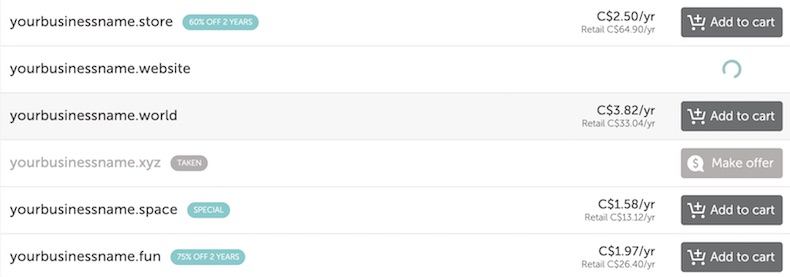
The time has come for you to buy a domain! So you log onto Namecheap or GoDaddy, enter in “yourbusinessname.com” aaaaand it’s taken.
Not to worry! You come across a .ca for a few bucks more, or a sale on a .vip for $3, or a .biz domain for 99 cents.
You add it to your cart, look at the purchase button, go in for the click, but WAIT! You may not realize it, but this can have an impact on your website’s SEO, your dot something (also known as a top level domain or TLD) matters. You may wonder why? Or if it will really affect your rankings on Google?”
So that’s why you’ve come across this article. To find out if it does. And yes, it does… well kind of.
Over recent years, there has been the introduction of new TLDs that sound cool, look nice, are extremely specific, or just random. But which TLD should you choose? Here are some things to consider.
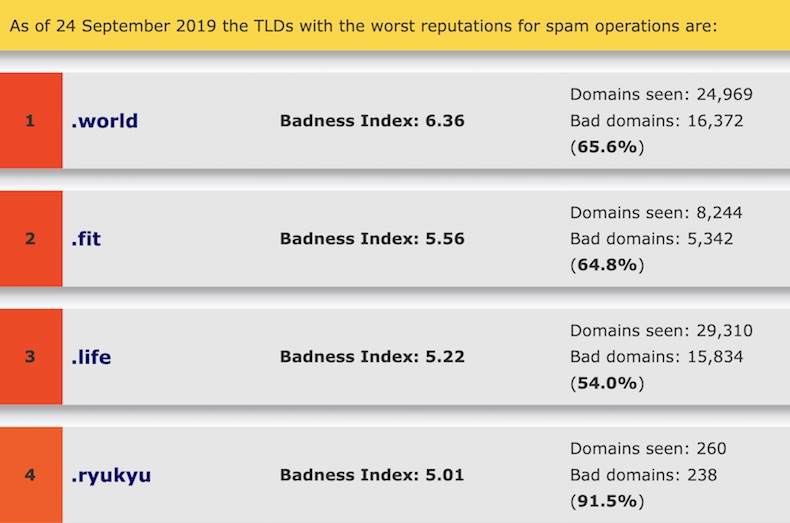
Do You Want To Be Flagged For Spam?
There are lots of internet marketers, especially the black hat marketers, that have abused these new TLDs. These are called Generic Top Level Domains (gTLDs). There are multiple reasons why marketers love getting new gTLDs:
- Keyword Domain: having a keyword in your domain used to be a big factor when it came to ranking. However, in today’s algorithms, it doesn’t matter as much. Some marketers still believe in the old ways, so they try to buy keyword.com, but it’s taken. What’s the next option? Keyword.xyz, keyword.biz, etc. If one of your main keywords is part of your brand name, don’t sweat it. But also don’t spam.
- Price: a major reason why these TLDs get abused for spam is that there are some that are extremely cheap. A lot of times, when you go to Namecheap, they promote certain TLDs for just 88 cents. That’s a steal for a throwaway domain you could use to spam things.
Google says they treat all gTLDs the same, but they do have their guard up against a number of them.
What About Country Code TLDs (ccTLDs)?
Country code TLDs or ccTLDs matter. If you are in Canada, complete a search for London on Google. What’s the first thing that shows up (after Wikipedia)? London.ca. But we had the intention of searching for the city of London in the UK. Why aren’t there any UK sites listed in the top 5?
Try this too: search up “Walmart”, “Home Depot” or “Trip Advisor”. There are .com versions of these sites, but because you’re in Canada, Google will give you the .ca versions.
For local search intent, Google will often favour region-specific TLDs.

But It Makes Sense to have a gTLD in your Industry Right?
In theory, yes, but unless the gTLD you want isn’t an abused TLD, Google won’t treat it any differently. It may change in the future, but we won’t know until it happens. However, it does help with relevancy. Having an industry-specific TLD lets Google know more about your business, but won’t directly give you a boost in the rankings.

Think Social
Let’s forget SEO for a second. Picture this scenario:
“I love that shirt! Where did you get it?” asks your friend.
You respond, “I bought it online at Shirt Supply!”
When you hear a website name, what’s the next thing that pops in your head? Subconsciously, you probably read that as shirtsupply.com, but the dot com wasn’t even there. .com is the go-to TLD and is what everyone knows. Maybe sometime .ca odes, but most of the time it’s a .com TLD.
Not only that, what looks more trustworthy to you, shirtsupply.com or shirtsupply.store?
Dot coms have the highest social proof when it comes to visiting a website, and adding that layer of suspicion to a website visitor is just leaving a sale at the door.
Your best bet is to use a .com TLD if you can.

So when should I use a gTLD?
Whenever you want! If you think it looks great, are a huge fan of it, or just aren’t able to get a .com or a ccTLD, just go for a gTLD. As long as you aren’t using a known spammy extension, you should be all good to use a gTLD.
Using a gTLD can also bring out your creativity. You can integrate the gTLD into your name, or even come up with a clever phrase. Do you like to eat fish? You could buy “iliketoeat.fish” (yes, that exists). Even Taco Bell has done it. They own ta.co..
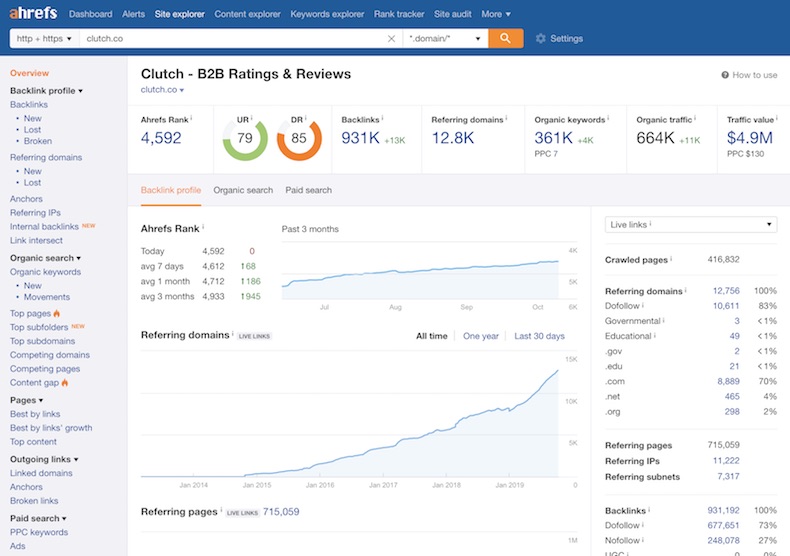
But Can I Actually Rank With a gTLD?
YES. Again, Google doesn’t care what TLD you use. Want proof? Search up “Calgary marketing agency” on Google, and you will find clutch.co in the #1 position. A .co beat out a .ca and .com. The reason why clutch.co beat .com’s, and .ca’s is because their SEO is on point. Their domain metrics are amazing and have a ton of backlinks and referring domains to them.
Your SEO efforts matter more than your TLD. The main reason why .com’s still own the majority of top search rankings is because of their domain age.
Takeaways From Our TLD Research
Country specific TLDs help your rankings locally. If you’re not planning on ranking locally, then SEO-wise, it doesn’t matter if you use a TLD that isn’t a .com or a .ca. As long as you aren’t using a red-flag TLD, the choice is yours, but definitely go for a .com.
